inbox and environment news: Issue 526
February 13 - 19, 2022: Issue 526
Koalas Now Listed As Endangered
February 11, 2022
The Federal Government is boosting the level of protection for Koalas under National Environmental law, and will this week seek agreement from Queensland, New South Wales and the Australian Capital Territory on the National Recovery plan.
Minister for the Environment Sussan Ley said “We are taking unprecedented action to protect the koala, working with scientists, medical researchers, veterinarians, communities, states, local governments and Traditional Owners,” Minister Ley said.
“As part of our $200 million bushfire response, I asked the Threatened Species Scientific Committee to consider the status of the Koala.
“Today I am increasing the protection for koalas in NSW, the ACT and Queensland listing them as endangered rather than their previous designation of vulnerable.
“The impact of prolonged drought, followed by the black summer bushfires, and the cumulative impacts of disease, urbanisation and habitat loss over the past twenty years have led to the advice.
“Together we can ensure a healthy future for the koala and this decision, along with the total $74 million we have committed to koalas since 2019 will play a key role in that process.
“The new listing highlights the challenges the species is facing and ensures that all assessments under the Act will be considered not only in terms of their local impacts, but with regard to the wider koala population.
“The National plan developed through scientific advice and public consultation will now go to the relevant states for their final adoption and will help guide state and local government strategies.”
The decision follows a joint nomination by the International Fund for Animal Welfare (IFAW), Humane Society International (HSI) and WWF-Australia in April 2020 to Australia’s Threatened Species Scientific Committee.
Koalas in Queensland, New South Wales and the Australian Capital Territory will now be classified as Endangered under national legislation and will gain elevated protections. The decision also recognises the koala is one step further along the pathway to extinction.
“Koalas are an international and national icon, but they were living on a knife edge before the Black Summer bushfires with numbers in severe decline due to land-clearing, drought, disease, car strikes and dog attacks. The bushfires were the final straw, hitting at the heart of already struggling koala populations and critical habitat,” IFAW Oceania Regional Director Rebecca Keeble said.
“This decision is a double-edged sword. We should never have allowed things to get to the point where we are at risk of losing a national icon. It is a dark day for our nation. If we can’t protect an iconic species endemic to Australia, what chance do lesser known but no less important species have?
“This must be a wake-up call to Australia and the government to move much faster to protect critical habitat from development and land-clearing and seriously address the impacts of climate change.”
The nomination was submitted on the basis of two scientific reports which revealed Queensland’s koala population crashed by at least 50% since 2001 and up to 62% of the NSW koala population has been lost over the same period.
IFAW also welcomed the federal government’s recent $50AUD million pledge for koala recovery and habitat restoration.
“These actions are vital to ensure the survival of the species into the future, but without addressing the root cause of their decline which is habitat loss and climate change, we are just plugging holes in a sinking ship. We must do everything possible to implement the plan and save this iconic species,” Ms Keeble said.
In January 2022, the Australian Government announced an additional $50 million over 4 years to maintain and support the recovery and conservation of the Koala through monitoring, the protection of Koala habitats, and the improvement of Koala health and care in response to natural disasters such as bushfires and diseases including Chlamydia.
This funding injection builds upon the $18 million Koala conservation package announced in 2020, which includes $14 million in bushfire recovery funding, given the impact of the 2019-20 bushfires on the species and its habitats.
The additional $50 million Koala investment includes:
- $20 million in grants and procurements for larger projects led by Natural Resource Management groups, NGOs, and Indigenous groups, as well as state and territory governments to build on existing work, guided by the outcomes and findings of the National Koala Monitoring Program.
- $10 million to extend the National Koala Monitoring Program to fill critical knowledge gaps and increase the use of citizen scientists
- $10 million in grants for small-scale community projects and local activities such as habitat protection and restoration, managing threats, health and care facilities, and citizen science projects
- $2 million in grants to improve Koala health outcomes through applied research activities and the practical application of research outcomes to address fundamental health challenges such as Koala retrovirus, Koala herpes viruses and Chlamydia
- $1 million to expand the national training program in Koala care, treatment and triage
The $18 million Koala Conservation package (to June 2022) includes:
- $10 million to support habitat restoration and threat mitigation in bushfire-affected regions of New South Wales and south-east Queensland
- $2 million for Koala protection and recovery at additional sites identified from the Investment Framework for Environmental Resources (INFFER) workshops held in northern New South Wales (funded under the Environment Restoration Fund)
- $2 million for habitat restoration and threat mitigation in other non-bushfire affected regions of central and western New South Wales and central Queensland(funded under the Environment Restoration Fund)
- $2 million for a Koala Health Initiative to support coordination and delivery of more effective health research and to support Koala veterinary activities
- $2 million for a National Koala Monitoring Program to produce a robust estimate of the national Koala population and fill key data gaps identified through the Koala re-assessment and recovery plan development process.
In addition, Australian Government commitments to the Koala under the Environment Restoration Fund include:
- $3 million to support Koala hospitals in south east Queensland (announced in December 2019)
- $3 million to support habitat restoration in northern New South Wales and south east Queensland (announced in November 2019).
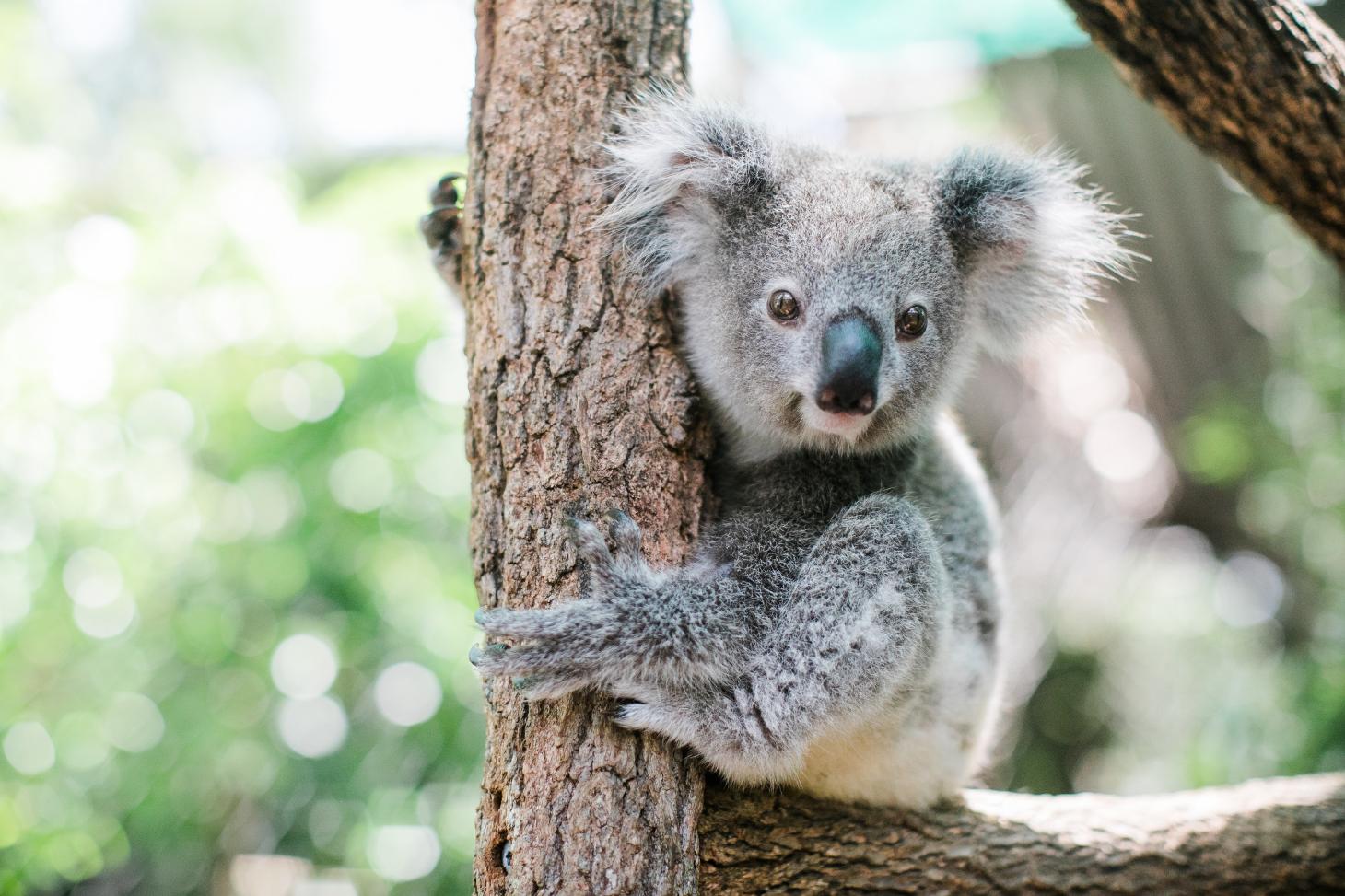
Long-Billed Corella: Birds In Your Backyard And Urban Street
The long-billed Corella or slender-billed corella (Cacatua tenuirostris) is a cockatoo native to Australia, which is similar in appearance to the little corella. This species is mostly white, with a reddish-pink face and forehead, and has a long, pale beak, which is used to dig for roots and seeds. It has reddish-pink feathers on the breast and belly.Long-billed corellas form monogamous pairs and both sexes share the task of building the nest, incubating the eggs, and caring for the young. Nests are made in decayed debris, the hollows of large old eucalypts, and occasionally in the cavities of loose gravely cliffs. Breeding generally takes place in Austral winter to spring (from July to November). 2–3 dull white, oval eggs are laid on a lining of decayed wood. The incubation period is around 24 days and chicks spend about 56 days in the nest.
The long-billed corella typically digs for roots, seeds, corms, and bulbs, especially from the weed onion grass. Native plants eaten include murnong Microseris lanceolata, but a substantial portion of the bird's diet now includes introduced plants.
The call of the long-billed corella is a quick, quavering, falsetto currup!, wulluk-wulluk, or cadillac-cadillac combined with harsh screeches.
The long-billed corella can be found in the wild in Victoria and south-eastern New South Wales. It has extended its range since the 1970s into Melbourne, Victoria and can now be found in Tasmania, South Australia and southeast Queensland.
Long-billed corellas are now popular as pets in many parts of Australia, although they were formerly uncommon, and their captive population has stabilised in the last decade. This may be due to their ability to mimic words and whole sentences to near perfection. The long-billed corella has been labelled the best "talker" of the Australian cockatoos, and possibly of all native Psittacines.
Photo: A J Guesdon
Sulphur-Crested Cockatoo (Cacatua Galerita) Swinging On Norfolk Pine Branch: Summer 'Larking' About
Like all parrots, cockatoos are zygodactyl (of a bird's feet; having two toes pointing forward and two backward). This, along with the use of their beak, gives them the ability to use their feet much like we use our hands and helps make them terrific climbers! Having the ability to climb is a necessity for birds that live and nest in thick forests. It’s hard to fly through dense, leafy branches, and even tougher to get to the fruit or nuts that are their primary foods, but because cockatoos can climb through tree branches so well, they can easily get to the treats they want. These birds are also able to hold their food in one foot while balancing on the other.
The Sulphur-crested Cockatoo's normal diet consists of berries, seeds, nuts and roots. It also takes handouts from humans. Feeding normally takes place in small to large groups, with one or more members of the group watching for danger from a nearby perch.
Cockatoos often “play” with each other, performing intricate aerial manoeuvres or crazy antics, such as hanging upside down while perched, just for the “fun” of it - as this one was this week! These activities serve as a form of exercise for the birds, and strengthen social bonds. - Info: BirdLife Astralia
When not feeding, these birds will bite off smaller branches and leaves from trees, an activity that may help to keep the bill trimmed and from growing too large. This one can also be seen cleaning out its toes after its 'swinging display':
Photos: A J Guesdon
Cicada 'Rain': Summer Of 2022
Although it's not as deafening under the Pittwater Spotted Gums in our yard in recent weeks, it has been VERY LOUD from early January as masses of Black Prince Cicadas (Psaltoda plaga) emerged to 'sing'. Only the male cicadas sing, gathering in large numbers in trees and make their calls using organs on either side of the body called tymbals, amplifying the sound by their hollow abdomen. Cicadas have been recorded 'singing at up to 96 decibels - 70 is around the noise made by your vacuum cleaner. There are two components of the call; a rhythmic revving, which is more prevalent when the weather is cooler, and a continuous call, more common in hot weather. They make this noise to attract females. When you hear an insect at night it's usually a cricket or katydid. Cicadas love the sun, so rain and cloudy skies will decrease the likelihood they will sing. Temperature also affects whether or not they will sing. If it is too cold they won't sing.
These cicadas have provided a feast for the birds that live here, including those born in this yard as shared so far this Summer; Summer Babies: Butcher Bird + A 1953 Insight On These By Bill Grayden and Summer Babies 2022: Channel-Billed Cuckoo Pair Being Fed By Currawong + Dollarbird Babies.
They are also food for noisy miners, blue-faced honeyeaters, little wattlebirds, grey and pied butcherbirds, magpie-larks, Torresian crows, white-faced herons and even the nocturnal tawny frogmouth, have all been reported as significant predators. At night we have had numerous flying foxes visiting to feed on them too.
Even our dog, Matilda Mae, has been feasting on them - going out to catch those that land before bringing them inside to eat them on the rug or chasing those that fly in at night, attracted by the lights on. She only eats the abdomen though, meaning we have to clean up the wings - a nice crunchy mess underfoot!
Cicadas constantly drink tree sap which makes for a 'cicada rain' as they urinate - when you have masses of cicadas in your trees you are likely to experience this. They drink tree fluid to cool down on warm days, which causes them to pee excessively. Cicada pee, like these insects, is harmless, and is even called 'honeydew' by some.
Some experts state they are peeing on you on purpose. Others say the cicadas squirt fluids at other males, animals and people as a defence mechanism.
We think they just have to urinate all that tree sap out as, as can be seen in this photo, they pee all day long even when no one and nothing else is around:
The cicada spends seven years underground in nymph form drinking sap from the roots of plants before emerging from the ground as an adult, although here we hear and see them every year. Species on which it feeds include weeping willow, river sheoak, rough-barked apple and various eucalypts. The adults, which live for four weeks, fly around, mate, and breed over the summer.
The colour of adult male black prince varies with age and locality. Around Sydney north to the Hunter River, it is very dark, predominantly black, with some brown markings; the abdomen black above and brown below. The eyes are brown. Further north from Brunswick Heads to Coolum Beach, the black prince exhibits more green markings instead of brown, and is lighter overall in coloration. The female is similar but slightly smaller than the male.
male and female inside at night at our place
Adult male
The black prince was originally described by German naturalist Ernst Friedrich Germar in 1834 as Cicada argentata, the species name derived from the Latin argentum "silver". Swedish entomologist Carl Stål defined the new genus Psaltoda in 1861 with three species, including the black prince as Psaltoda argentata. Francis Walker described Cicada plaga in 1850 as well as querying further specimens as Cicada argentata. He noted in 1858 that the binomial Cicada argentata had been used by a European species, and declared that Germar's cicada needed a new name. The older combination was ruled invalid as the binomial Cicada argentata had been originally used for a European cicada now known as Cicadetta argentata, and the black prince became Psaltoda plaga. The name black prince was in popular use by 1923.
Photos: A J Guesdon
Asparagus Fern Flowering Now: Dispose Of This Weed To Stop The Spread
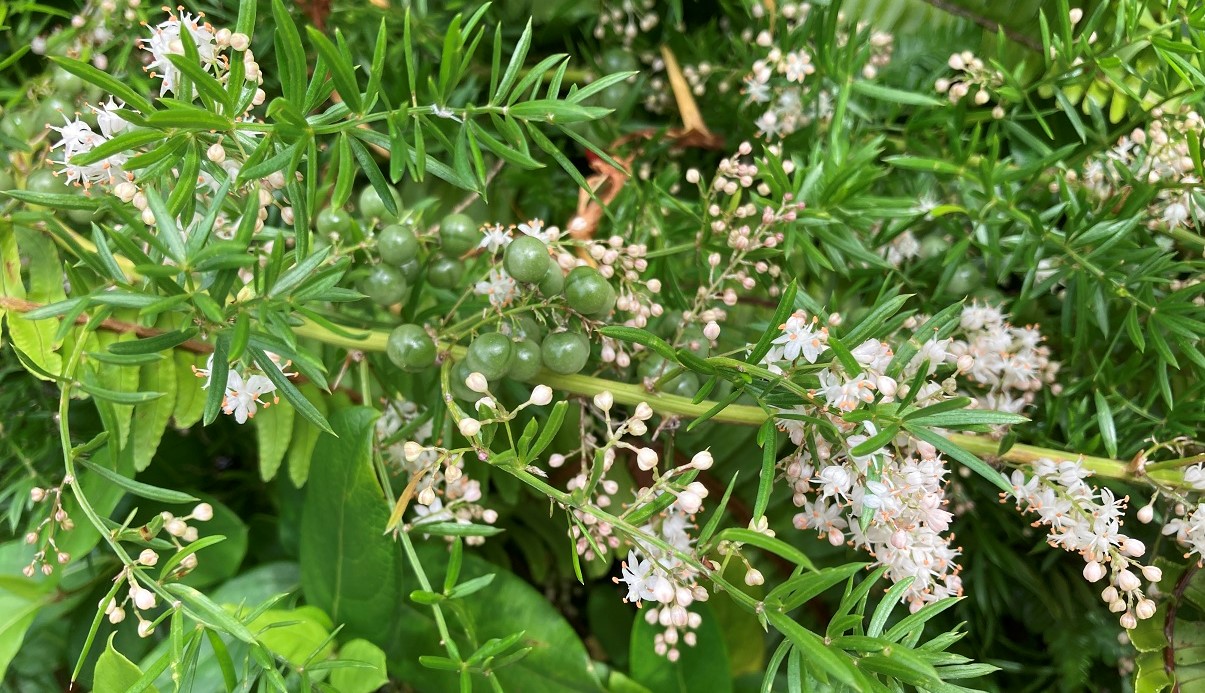
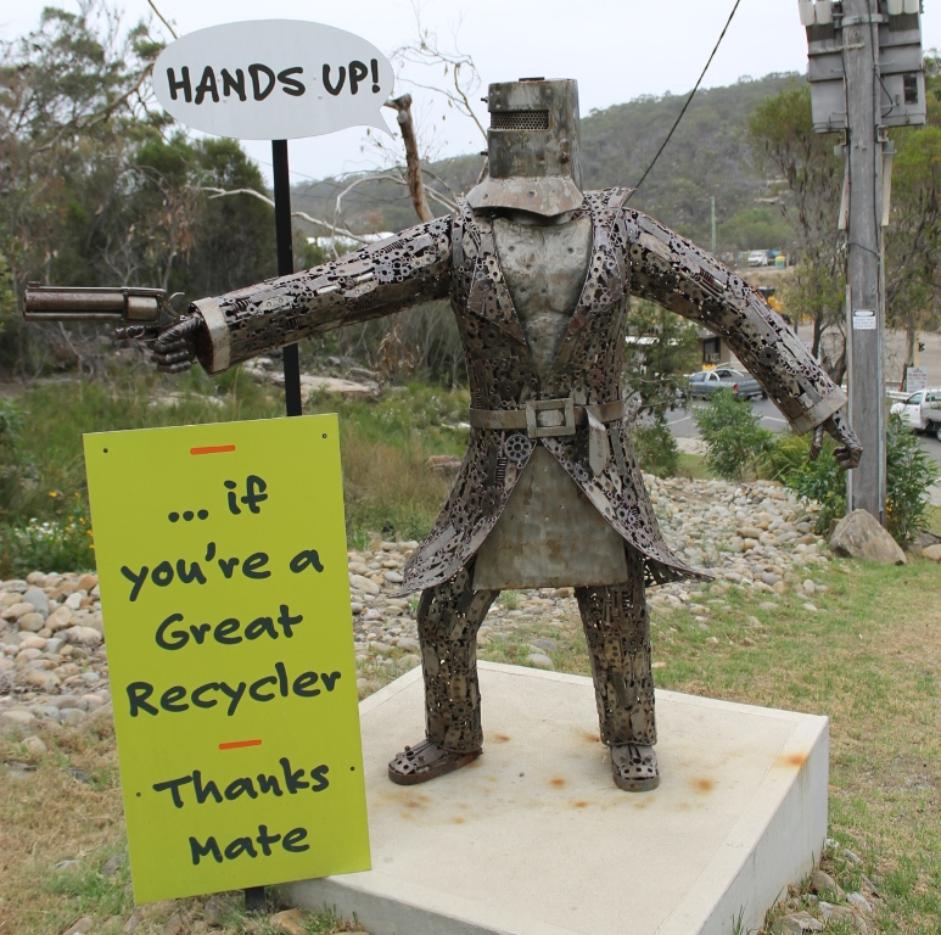
Ned Kelly sculpture at entrance to Kimbriki Resource Recovery Centre - made from discarded metals. Photo: A J Guesdon.
Friends Of Narrabeen Lagoon Catchment - Next Forum
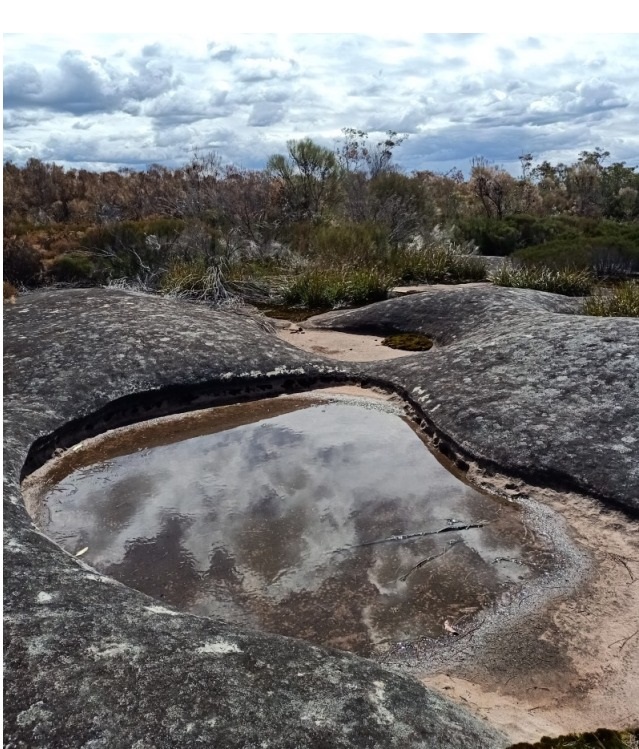
Northern Beaches Clean Up Crew Next Clean Is At: Queenscliff: Sunday 27th Of February
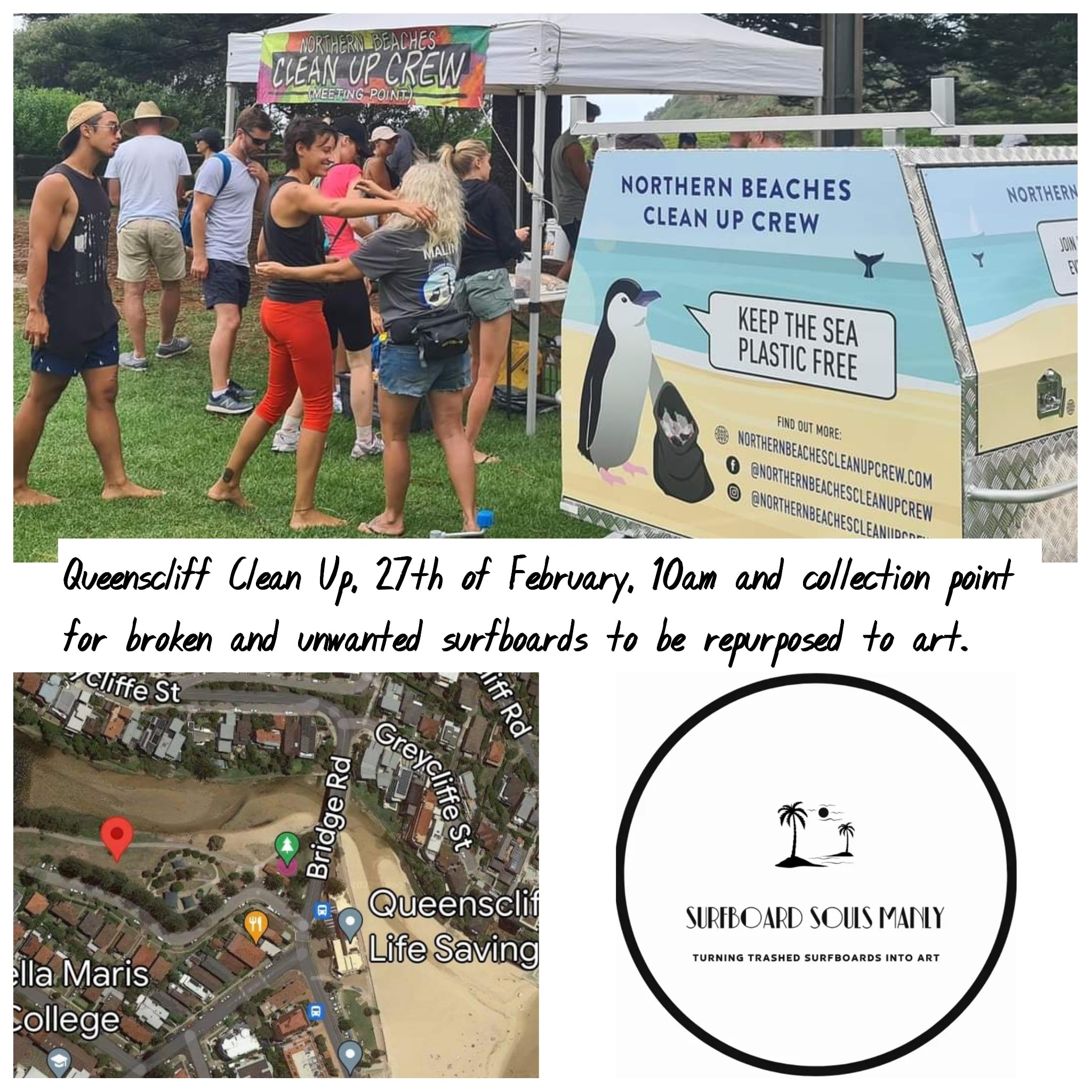
Bushcare In Pittwater
Where we work Which day What time
Avalon
Angophora Reserve 3rd Sunday 8:30 - 11:30am
Avalon Dunes 1st Sunday 8:30 - 11:30am
Avalon Golf Course 2nd Wednesday 3 - 5:30pm
Careel Creek 4th Saturday 8:30 - 11:30am
Toongari Reserve 3rd Saturday 9 - 12noon (8 - 11am in summer)
Bangalley Headland 2nd Sunday 9 to 12noon
Bayview
Winnererremy Bay 4th Sunday 9 to 12noon
Bilgola
North Bilgola Beach 3rd Monday 9 - 12noon
Algona Reserve 1st Saturday 9 - 12noon
Plateau Park 1st Friday 8:30 - 11:30am
Church Point
Browns Bay Reserve 1st Tuesday 9 - 12noon
McCarrs Creek Reserve Contact Bushcare Officer To be confirmed
Clareville
Old Wharf Reserve 3rd Saturday 8 - 11am
Elanora
Kundibah Reserve 4th Sunday 8:30 - 11:30am
 Mona Vale
Mona Vale Mona Vale Beach Basin 1st Saturday 8 - 11am
Mona Vale Dunes 2nd Saturday +3rd Thursday 8:30 - 11:30am
Newport
Bungan Beach 4th Sunday 9 - 12noon
Crescent Reserve 3rd Sunday 9 - 12noon
North Newport Beach 4th Saturday 8:30 - 11:30am
Porter Reserve 2nd Saturday 8 - 11am
North Narrabeen
Irrawong Reserve 2nd Saturday 2 - 5pm
Palm Beach
North Palm Beach Dunes 3rd Saturday 9 - 12noon
Scotland Island
Catherine Park 2nd Sunday 10 - 12:30pm
Elizabeth Park 1st Saturday 9 - 12noon
Pathilda Reserve 3rd Saturday 9 - 12noon
Warriewood
Warriewood Wetlands 1st Sunday 8:30 - 11:30am
Whale Beach
Norma Park 1st Friday 9 - 12noon
Western Foreshores
Coopers Point, Elvina Bay 2nd Sunday 10 - 1pm
Rocky Point, Elvina Bay 1st Monday 9 - 12noon
Gardens And Environment Groups And Organisations In Pittwater
Sydney Wildlife Rescue: Helpers Needed
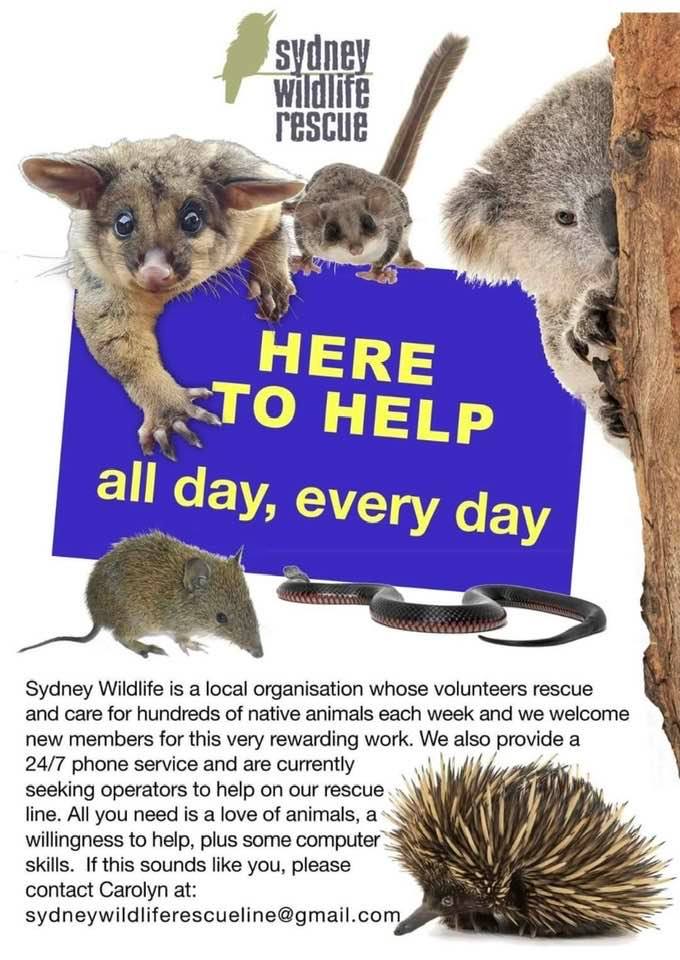
Back From The Brink: Bettongs, Numbats And Phascogales Flourish
February 9, 2022
A groundbreaking project helping mammals avoid extinction in NSW national parks is delivering great gains, with 150 animals since August released into a feral predator-free area.
On a visit to the Pilliga State Conservation Area site, Environment Minister James Griffin said the NSW Government-funded program removes feral cats and foxes from the landscape, creating safe refuges for endangered mammals.
The Pilliga and Mallee Cliffs National Park locations are just 2 of 7 feral-predator free areas already operational or being established, funded by the NSW Government and managed in partnership by the National Parks and Wildlife Service, Australian Wildlife Conservancy and Wild Deserts, led by UNSW.
'I can’t overstate how important this project is for protecting biodiversity – it’s one of the most ambitious mammal rewilding programs in Australia,' Mr Griffin said.
'Here at the Pilliga, we’ve seen the endangered bridled nailtail wallaby population double since it was reintroduced to this now feral-free area in August 2019, from 42 to about 90 at the latest estimate, including many females with joeys in pouches.
'This number is expected to eventually grow to more than 2000.'
In the Mallee Cliffs National Park, 60 vulnerable red-tailed phascogales were recently released back into the wild after an absence of almost 150 years.
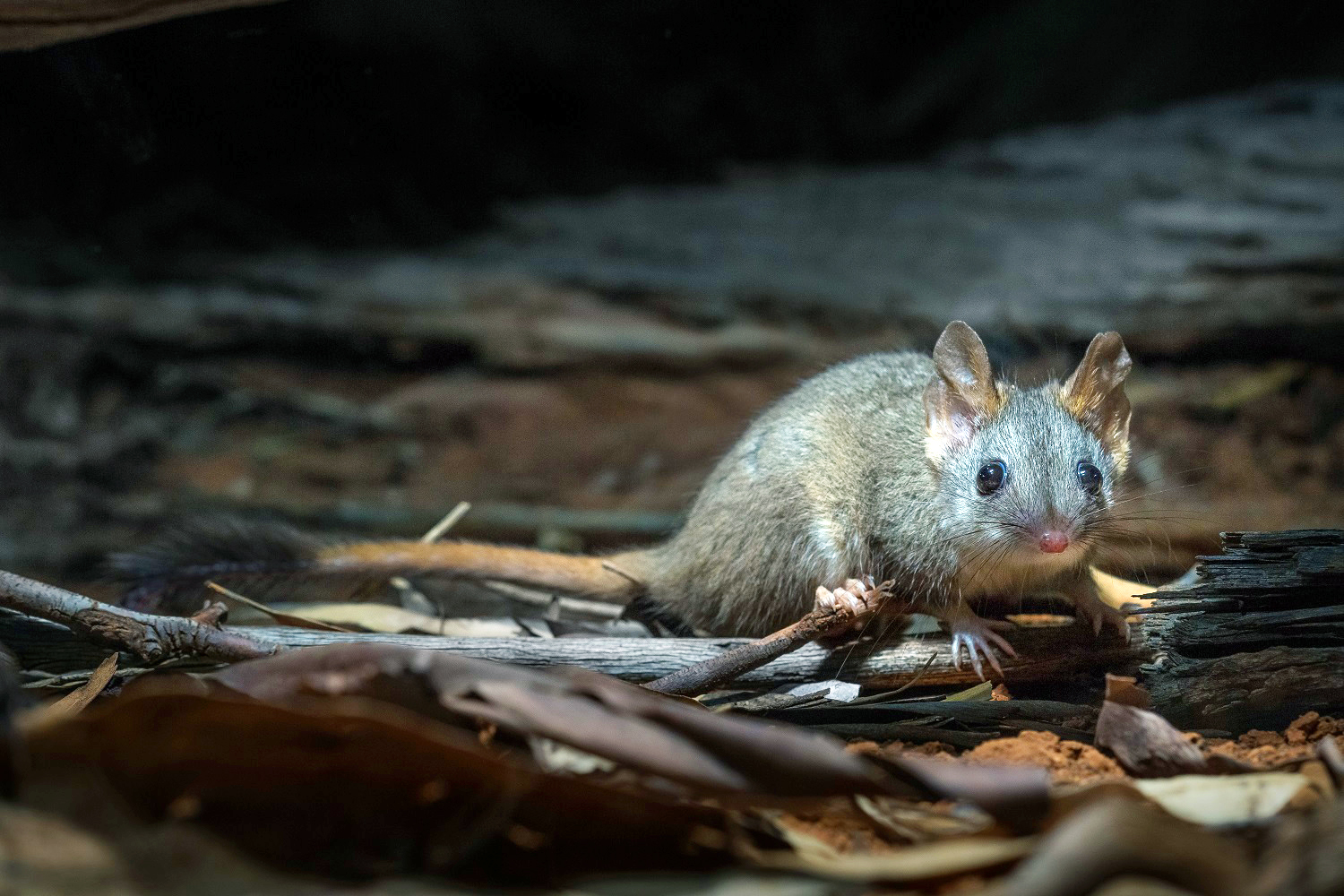
red-tailed phascogale. Photo: Dr Laurence Berry / AWC
This population of tree-dwelling carnivores, which are related to the Tasmanian devil, is expected to grow to more than 1500 animals once established.
The phascogales were joined by 70 brush-tailed bettongs and another 20 numbats, the latter boosting a founding population established at Mallee Cliffs in 2020.
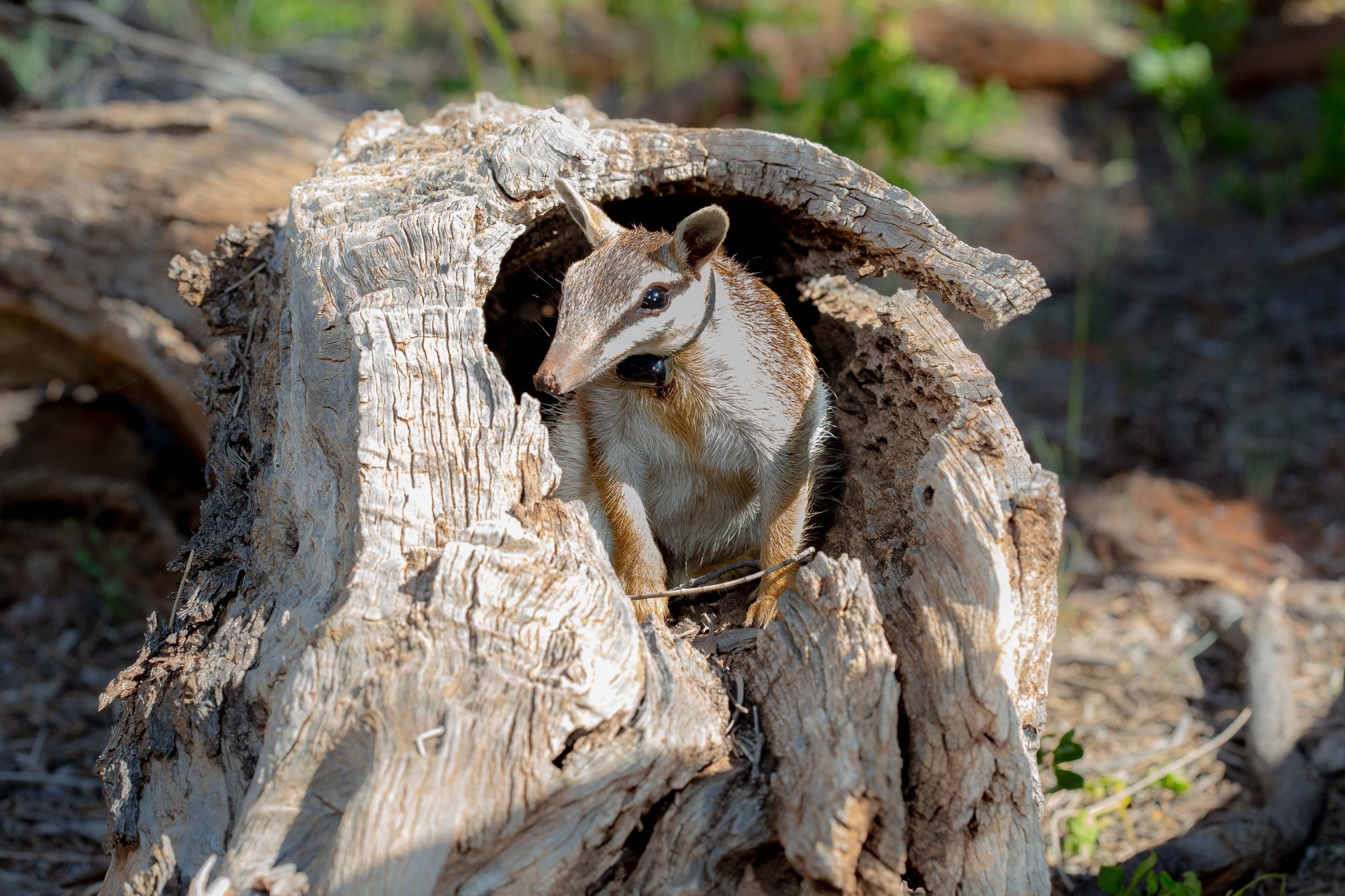
Numbat. Photo: Brad Leue / AWC;
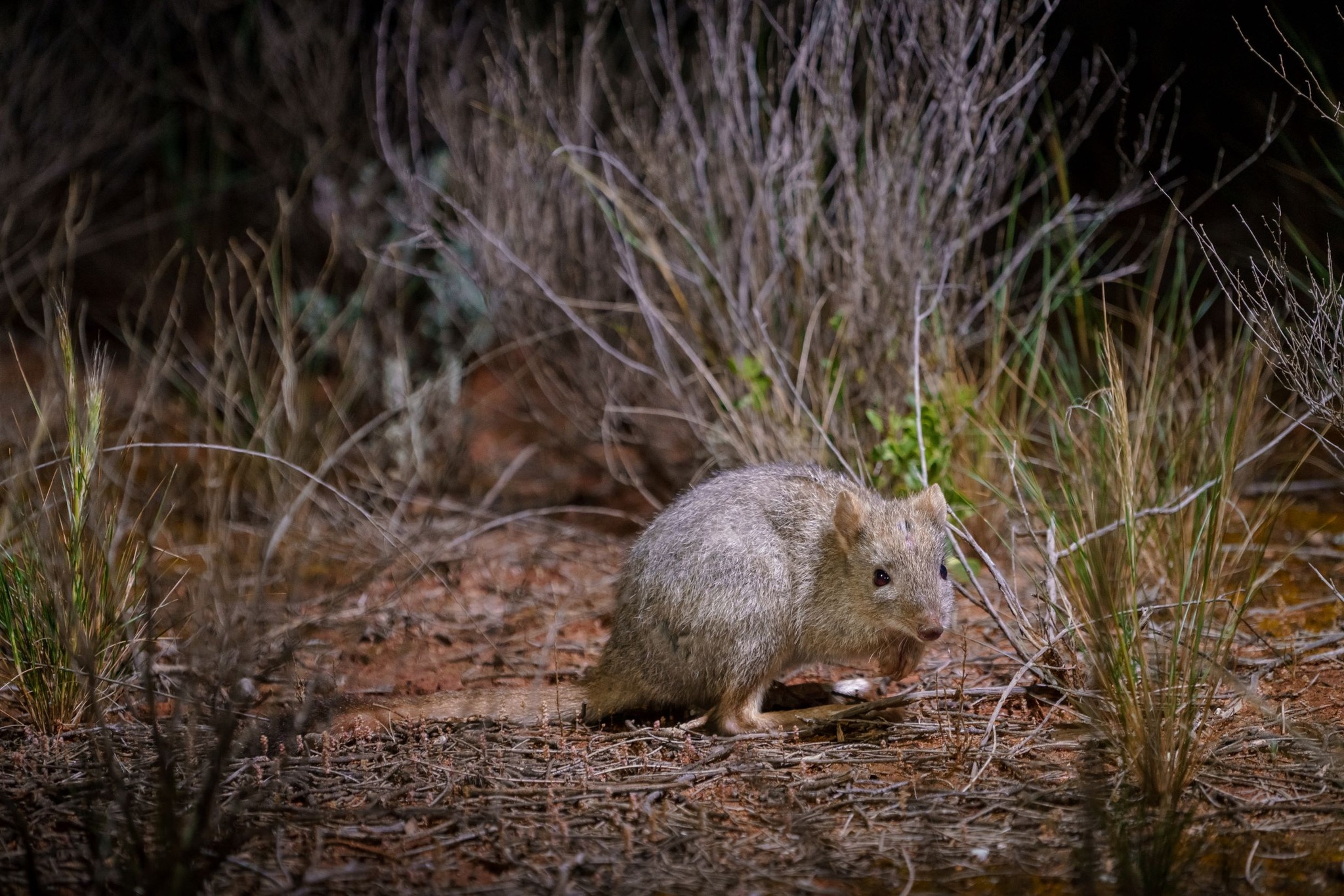
Bettong. Photo: AWC
'The phascogale is the eighth mammal listed as extinct in New South Wales that has been returned to NSW national parks in the past 3 years,' Mr Griffin said.
'Within a few years, we hope to remove at least 10 mammals from the NSW extinct list – the first time that will have happened anywhere in the world.
'Many of these and other species already reintroduced to these feral-free areas have not been seen in our national parks for more than a century, largely because of foxes and feral cats. Feral cats kill over 1.5 billion native animals nationally every year.
'With these projects, we’re restoring ecosystems to health, giving locally extinct animals a second chance and, in time, offering the community the chance to see the bush at its best.'
Statewide there will soon be 65,000 hectares of feral predator-free areas on national park estate, including these 2 project sites. They’re being established as an essential part of the NSW Government’s conservation strategy, aiming to prevent extinction.
Photos: Red-tailed phascogale: Dr Laurence Berry / AWC; Numbat: Brad Leue / AWC; Bettong: AWC
Billagoe Listed On State Heritage Register
February 10, 2022
The Billagoe (Mount Drysdale) Cultural Landscape has been listed on the NSW State Heritage Register, recognising its long and diverse history.
Heritage Minister James Griffin said he was proud to action the recommendation to list Billagoe Cultural Landscape, which is an outstanding example of a spiritual and cultural landscape.
"Billagoe (Mount Drysdale) has rich cultural significance to the Indigenous people of the Ngemba-Ngiyampaa-Wangaaybuwan-Wayilwan and Baiame, the ancestral creator of landscapes and resources," Mr Griffin said.
"It's important that we recognise and preserve the deep history of this site and I am pleased that my first listing as Heritage Minister is one that celebrates NSW's rich Aboriginal heritage.
"The site forms part of the Baiame cycle of creation stories and is linked to other significant places such as Cobar, Gundabooka National Park, Byrock Rockholes Aboriginal Place and the nationally and state listed Ngunnhu (Brewarrina Fishtraps)."
Billagoe (Mount Drysdale) Cultural Landscape is of state significance for its rare Aboriginal archaeology linked to ceremony, axe manufacturing, trade and social sites.
The site also includes examples of 19th-early 20th century gold mining infrastructure and Chinese market gardens, and a rare surviving example of a government caretaker's cottage, built in circa 1895.
As a multi-layered cultural landscape with shared history, it also has the ability to demonstrate the technology of water storage in an arid landscape, a theme that links the Indigenous, pastoral, mining and Chinese history.
"The listing of Billagoe (Mount Drysdale) Cultural Landscape celebrates and helps to protect unique and culturally important aspects of the Aboriginal and non-Aboriginal history of NSW," Mr Griffin said.
Morrison government spends $50 million saving koalas while taking away their homes
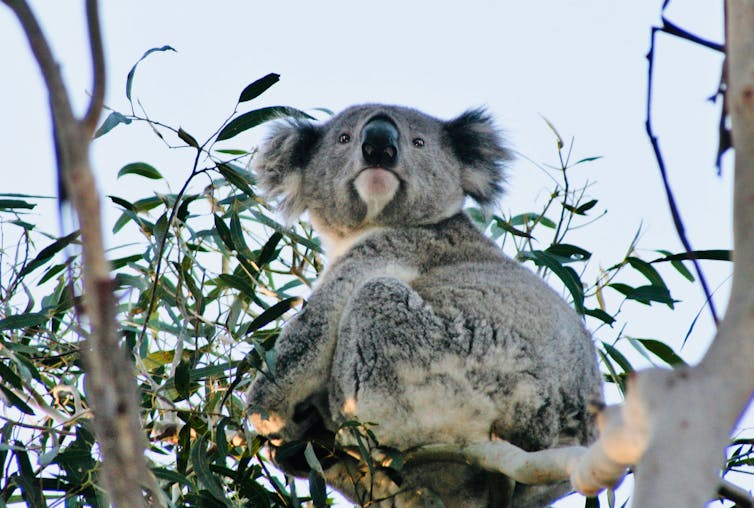
Federal Environment Minister Sussan Ley is reportedly poised to decide whether some koala populations should be listed as endangered, as new research shows her government continues to approve land clearing in koala habitat.
Analysis released by the Australian Conservation Foundation (ACF) on Tuesday found that in the decade since koalas were declared vulnerable to extinction, the federal government had approved the clearing of 25,000 hectares of the species’ habitat.
It follows the Morrison government’s announcement last month of A$50 million to restore koala habitat, monitor populations and research the animals’ health.
But until the problems of habitat loss and land clearing are addressed, national koala populations will continue to dwindle. And as our recent research shows, much of the new funding is inadequate at the scale required.
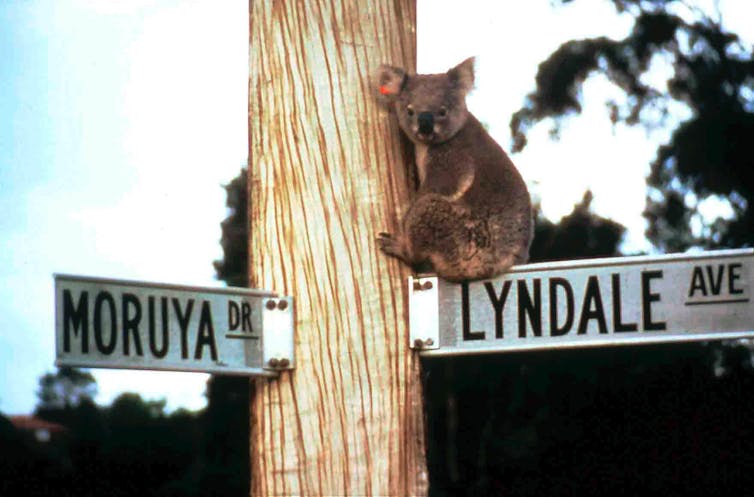
Koala Cash-Splash
The Threatened Species Scientific Committee, which advises the federal government, has recommended the status of koalas in Queensland, New South Wales and the ACT be upgraded from vulnerable to endangered.
Ley is expected to respond to the recommendation by next month. Listing the koala as endangered would be a serious escalation in its threat status.
The federal government’s recent $50 million of koala funding supports various initiatives. They include:
$20 million for large habitat and health protection projects delivered by Indigenous groups, industry, state and territory governments and non-government organisations
$10 million for community-led habitat restoration, health and care facilities, and citizen science projects
$10 million to extend the National Koala Monitoring Program
$2 million to fund applied research in koala health
$1 million to fund vet staff and koala care, treatment and triage.
These are important investments. But we see two major issues with the federal government’s approach.
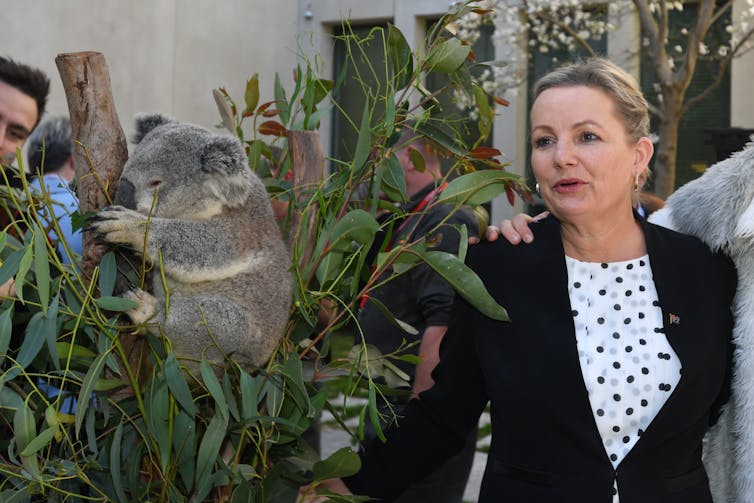
Habitat Loss: The Biggest Problem
Until koala habitat is protected, conservation efforts – largely funded by the taxpayer – will continue to be undermined.
Other recent federal koala funding includes $24 million after the Black Summer bushfires.
The NSW government wants to double the number of koalas in that state by 2050. To that end, it pledged $193 million over five years in the current budget. This followed the $44.7 million of koala funding it announced in 2018.
All this comes on top of the millions of dollars in international and national community donations for koala conservation efforts after the Black Summer bushfires.
But the primary driver of koala population decline is the clearing of its habitat. No amount of money can save koalas unless we tackle this.
The ACF research released on Tuesday confirmed the extent of the problem. The federal government approved the clearing of 25,000 hectares of koala habitat in the past decade, comprising 63 projects.
Most were mining projects, followed by land transport and housing developments.
Two recent federal decisions demonstrate this active undermining of koala conservation efforts:
approval to clear more than 75 hectares of critical koala habitat for housing west of Brisbane, reportedly in breach of the government’s own policy
approval of the Brandy Hill Quarry, which would clear 52 hectares of koala habitat to produce gravel and stone.
These projects were also approved by respective state governments, and were enabled by weak koala protections under both national and state environment laws.
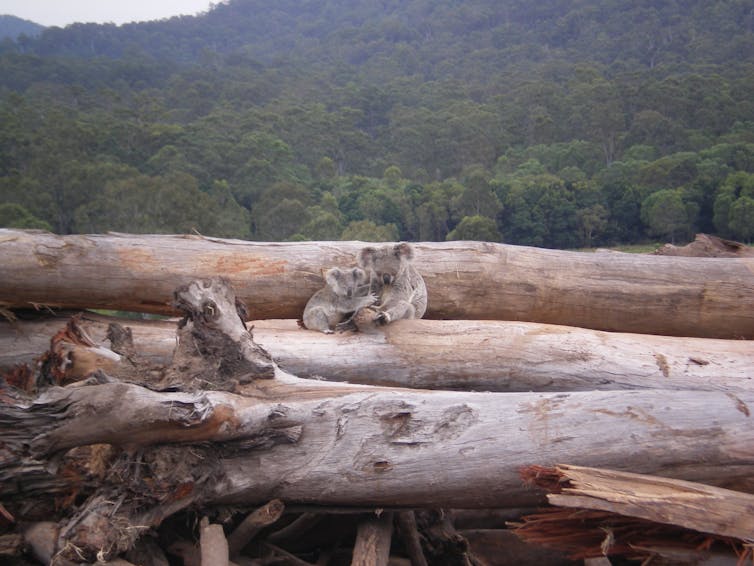
Barely Scratches The Surface
Second, the federal funding for koala monitoring is inadequate.
We recently modelled the costs of conducting large-scale koala population surveys with methods that could be incorporated into the National Koala Monitoring Program.
We examined the cost of surveying 1.9 million hectares of fire-affected places in NSW considered “high and very high suitability” koala habitat.
We put the price tag at $9.5 million to $11.5 million for on-ground techniques, or about $7 million for efficient and cost-effective drone thermal imaging.
That’s just for one survey round. Even if the 1.9 million hectares was fairly distributed to key sampling areas, which is likely, the surveys must still be repeated at regular intervals to monitor koala populations over time.
The latest funding announcement for the National Koala Monitoring Program brings the total to $12 million since the initiative was announced in 2020. Given the vast extent of the koala’s range across five states and territories, this monitoring funding barely scratches the surface.
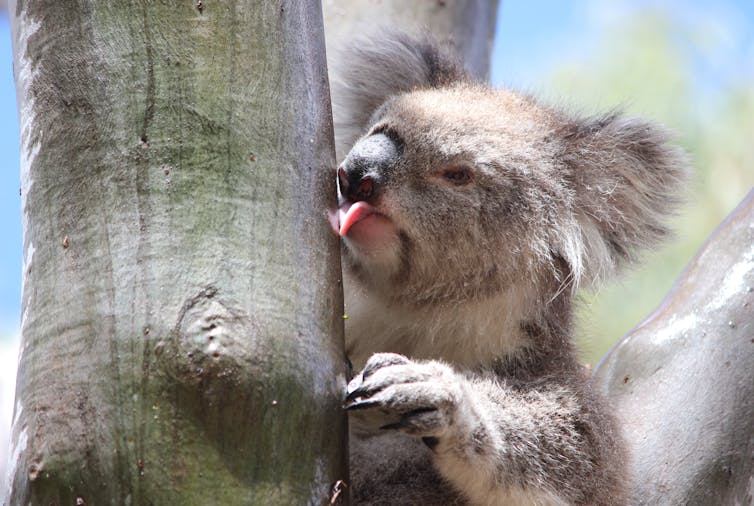
The Federal Government Must Step Up
Koala conservation is largely funded by the taxpayer and koalas receive far more funding than other threatened species.
So it’s only fair to expect this funding to deliver results. To protect the important public and community investment in koalas, the federal government must:
review current funding levels and provide adequate investment to support all Australia’s wildlife, including koalas
endorse the expert recommendation to list the koala as endangered in parts of Australia
finalise the Draft National Recovery Plan for the koala, which has been pending since 2012
enforce strong protections for koalas and other native wildlife, with independent oversight. The measures should follow the recommendations in Professor Graeme Samuel’s review of federal environment law.
In this, an election year, the Morrison government has the chance to show Australians it’s committed to saving our threatened wildlife. ![]()
Lachlan G. Howell, Research Fellow | Centre for Integrative Ecology, Deakin University; Ryan R. Witt, Postdoctoral Researcher and Honorary Lecturer | School of Environmental and Life Sciences, University of Newcastle, and Shelby A. Ryan, PhD Candidate | School of Environmental and Life Sciences, University of Newcastle
This article is republished from The Conversation under a Creative Commons license. Read the original article.
Native birds have vanished across the continent since colonisation. Now we know just how much we’ve lost

In the 250 years since Europeans colonised Australia, native birdlife has disappeared across the continent. Our new research has, for the first time, registered just how much Australia has actually lost – and our findings are astonishingly sad.
We focused on 72 species of birds faced with extinction today, including the Kangaroo Island glossy black cockatoo, regent honeyeater, and night parrot. We found 530 million hectares, or 69%, of Australia, has lost at least one bird species. In some parts of the country, we’ve lost up to 17 birds.
Land clearing, along with threats such as cat predation, have driven ten birds to disappear from over 99% of their historical habitat. Indeed, we show the last 250 years has seen more than 100 million hectares of now-threatened bird habitat cleared on mainland Australia – that’s 15% of Australia’s landmass.
For many of the species we examined, their remaining habitats occur in patches surrounded by farmland, towns and cities. To give birds and other animals a chance at survival, we need effective national leadership not only to protect existing habitats, but also to restore lost habitat and manage future habitat under climate change.
Lost, But Not Forgotten
In the last 250 years, 22 native birds have gone extinct. We found two more currently listed as threatened under Australia’s environmental legislation may also be now extinct.
One is the eastern star finch. This bird was once found from northern New South Wales to Queensland’s Burdekin River. A victim of overgrazing, it has not been seen since 1995. Surprisingly, this bird is only listed as “endangered” rather than “critically endangered” under [Australian law]
The other is the Tiwi Islands hooded robin, which has not been seen for 27 years. Changed fire patterns from European colonisation and invasive species such as cats and weeds have likely driven it to extinction.

Other species are on their last legs. The western ground parrot, for example, once swept across large parts of Western Australia, but are now in just two locations: Cape Arid National Park and Nuytsland Nature Reserve.
They’ve become locally extinct across more than 99% of their historical habitat because of habitat destruction, invasive species, and changed fire patterns. They’re at significant risk from isolated catastrophic events such as major bushfires. For example, the 2019-2020 fires alone destroyed 40% of the bird’s last remaining habitat.
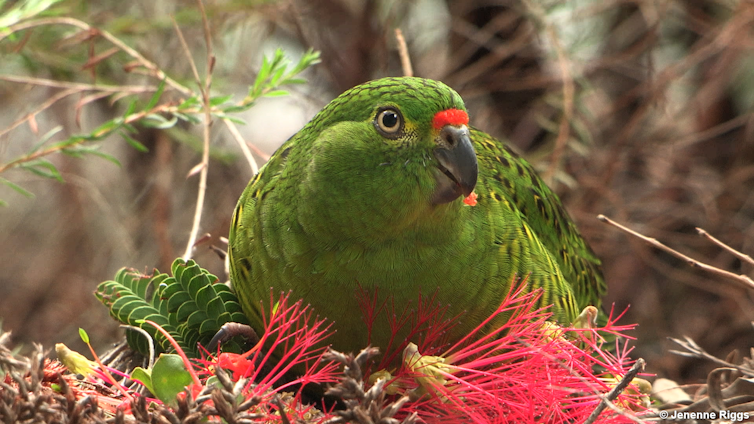
The plight of the regent honeyeater is another tragic story of decline. Flocks of thousands once occurred from Adelaide to north of Brisbane, with the naturalist John Gould writing in 1865:
I met with it in great abundance among the brushes of New South Wales […] I have occasionally seen flocks of from fifty to a hundred in numbers, passing from tree to tree as if engaged in a partial migration from one part of the country to another, or in search of a more abundant supply of food.
Today, only 100 breeding pairs are left, and almost all breed in just three sites in NSW. The species has lost more than 86% of its historical habitat, with land clearing the main driver of decline. So few remain that young birds cannot learn to sing properly, so have trouble attracting a mate.
The Extinction Wave
Our research used a combination of historical field guides, reference books, research papers, government records, spatial data, and expert elicitation to create maps of past habitats, and compared those to current habitats.
We found certain areas across continental mainland Australia to be in worse shape than others.
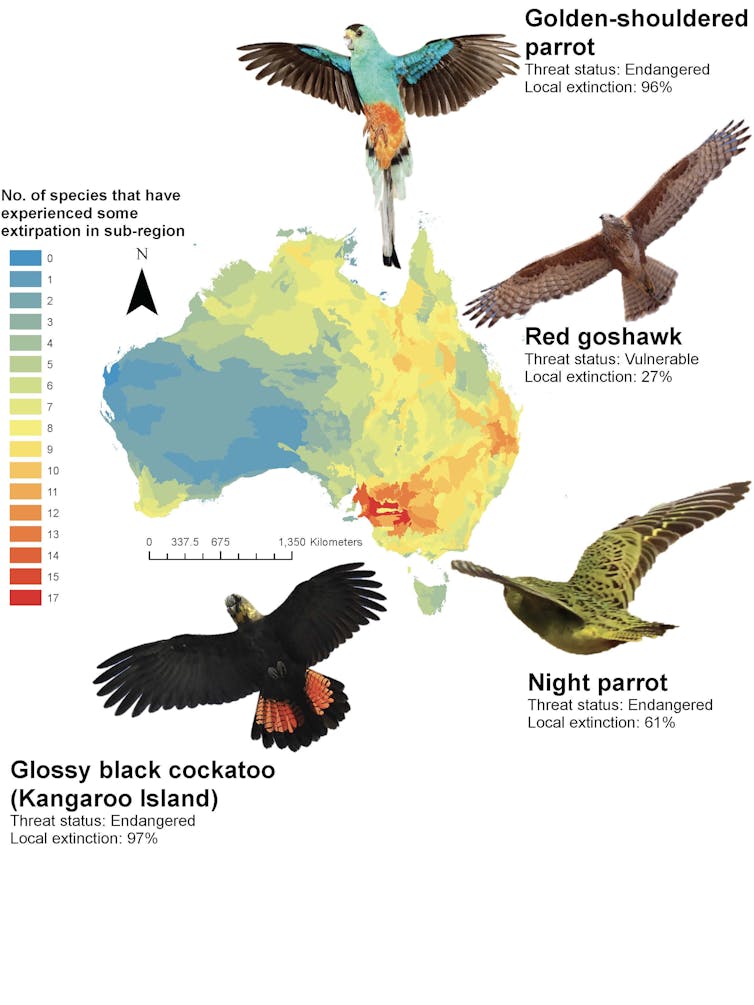
For example, we revealed extinction hotspots in areas between Swan Hill in Victoria and Marmon Jabuk range in South Australia. In this region, up to 17 birds have gone extinct (red areas in map), such as the black-eared miner.
Likewise, over the last century, almost 10% of all known breeding land-based birds have vanished in SA’s Mount Lofty ranges. This includes the rufous fieldwren, bush stone-curlew, ground parrot, king quail, azure kingfisher, barking owl, regent honeyeater, and swift parrot.
The story of decline is not limited to only threatened species, with more common birds such as willie wagtails, brolgas, boobook owls, and even magpies now disappearing from many places they were once common.
Indeed, the loss of so many species is the canary in the coal mine of total ecosystem collapse. And total ecosystem collapse poses an existential threat to food systems, water quality and climate stability.
If we don’t make fundamental changes in the way we manage and use landscapes, the extinction wave will continue to inundate Australia.
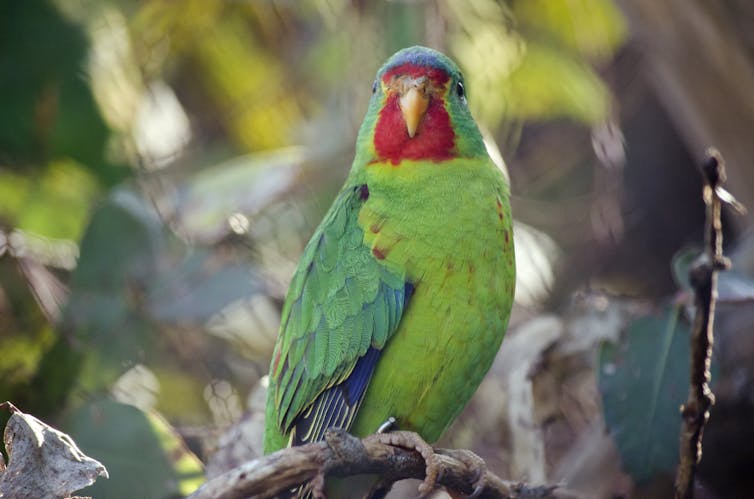
What Can We Do About It?
We need federal leadership to curb the extinction crisis, and an important start is to implement promises we’ve already signed up to in, for example, the UN’s Aichi biodiversity targets.
At the ongoing international biodiversity conference – COP15 – a key ask is for countries to halt human-induced species extinctions from now onwards, to bring the overall risk of species extinctions to zero, and to bring population abundance of native species back to 1970s levels by 2050. This is a basic commitment to Australia’s heritage and culture.
Crucially, we need fundamental reform of Australia’s key environment legislation: the Environment Protection and Biodiversity Conservation (EPBC) Act.
A major, independent review last year revealed that the EPBC Act has failed native wildlife. One of its key recommendations was to implement strong national environmental standards, such as not allowing any degradation of critical habitat.
These standards must be put in place as a matter of urgency. They must be legally enforceable, concise, specific, and focused on the conservation outcomes to properly protect Australian biodiversity and reverse the decline of our iconic places.
A huge thank you to all my wonderful co-authors, without which, this research would not be possible: James E.M. Watson, Hugh P. Possingham, Stephen T. Garnett, Martine Maron, Jonathan R. Rhodes, Chris MacColl, Richard Seaton, Nigel Jackett, April E. Reside, Patrick Webster, Jeremy S. Simmonds.![]()
Michelle Ward, PhD Candidate, The University of Queensland
This article is republished from The Conversation under a Creative Commons license. Read the original article.
Is the buff-breasted button-quail still alive? After years of searching, this century-old bird mystery has yet to be solved
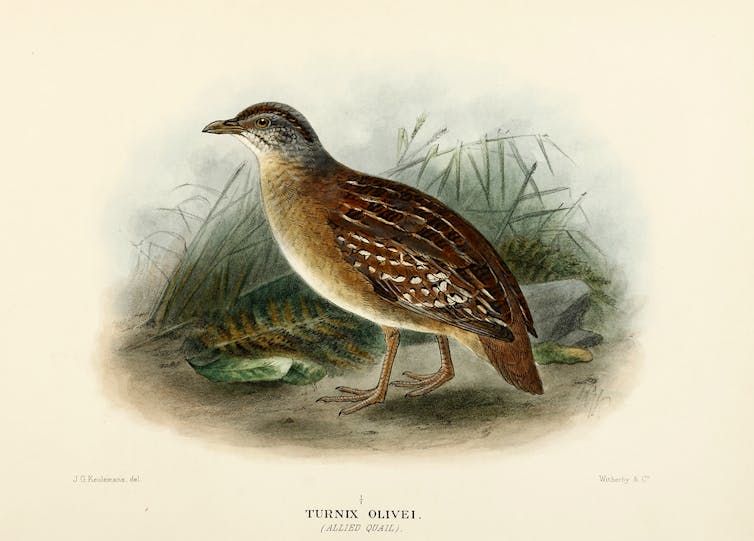
In humid savanna on Cape York Peninsula, February 5, 1922, a man was on the hunt with a local Indigenous guide. They had just heard their quarry calling among the tall grass – a low “oomm, oomm, oomm” – before it burst into view with a flurry of wingbeats. A loud shotgun blast, and the bird dropped to the ground.
The bird was a buff-breasted button-quail, and the collector was Australian field naturalist William Rae McLennan. Later that evening he would have skinned and stuffed the bird, turning it into a museum specimen, before describing the encounter in his diary.
This skin was the last of the species ever collected. A century later, we have still yet to confirm any sightings of this mysterious, native bird.
I’ve spent four years searching for the buff-breasted button-quail, walking hundreds of kilometres and spending months scouring practically every locality where the species had ever been reported. All I’ve been able to find is its more common cousin: the painted button-quail.
Still, my ongoing research has brought us a step closer to solving this mystery and I remain hopeful the bird is still in existence. If it is, it urgently needs our help.

Searching For A Lost Species
McLennan’s diary from that wet season of 1921-1922 has remained the only detailed descriptions of the buff-breasted button-quail’s ecology. Some 60 years later in 1985, it was “rediscovered” just west of Cairns, and this launched dozens of new sightings by birdwatchers and several research projects over the next few decades.
Unfortunately, none of these reports or research endeavours produced anything more than brief sightings of the bird, typically only split-second views as it flew off from under their feet. No photos, no specimens, nor any other verifiable evidence has been produced.
For my doctoral project on the species, I joined the RARES research group at the University of Queensland in 2018. Our research team aimed to find a population, study its ecology, determine what threatening processes had led to its rarity, and learn how it could be conserved.
There were a few times in far north Queensland’s wet-season – supposedly the best time of year to see buff-breasted button-quail – when I saw birds fitting its widely accepted description: they were large, with sandy rufous (reddish brown) back and rumps, and contrasting dark primary feathers.
But whenever I thought I saw one on the ground, it turned out to be a painted button-quail. These differ by having a bright red eye and a grey breast.
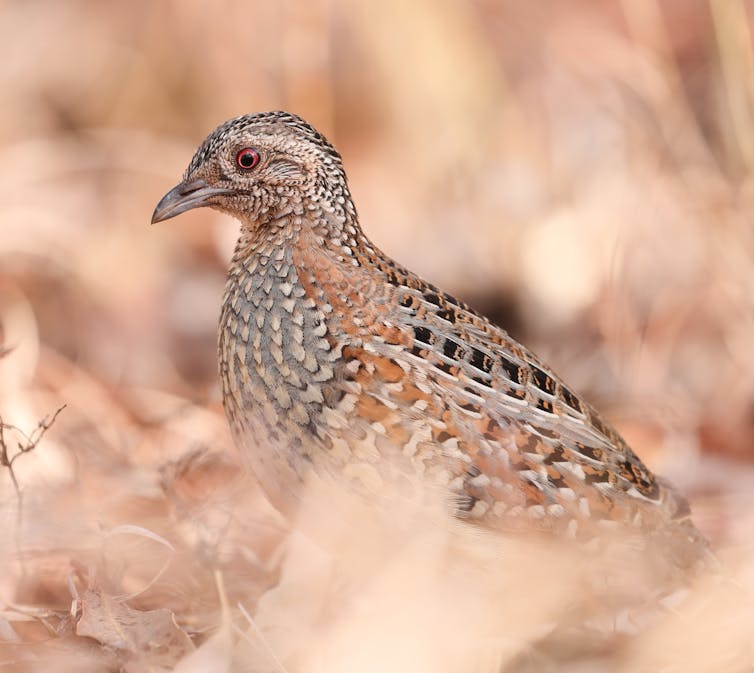
Given there had been numerous reported sightings of buff-breasted button-quails from the region in the years prior, finding only painted button-quails was surprising, confusing and raised serious concerns.
Indeed, my research team and I became increasingly apprehensive about the status of the buff-breasted button-quail, and began questioning the features used to separate them from painted button-quail. This prompted a thorough investigation of all historical reports, and the reliability of characteristics used to identify the two birds in the field.
Has The Bird Been Misidentified?
To determine how best to separate these two species in the field, I examined over 100 button-quail skins in museum collections worldwide. I also caught and photographed painted button-quail throughout north Queensland. What I discovered was intriguing.
Several supposedly key characteristics of the buff-breasted button-quail either did not exist, or were actually features of the painted button-quail.
For instance, it was commonly reported that buff-breasted button-quail were much bigger than painted button-quail. My study of museum specimens, which is not yet published, showed the two are actually the same size.
I also discovered a previously undocumented colour variation in the plumage of painted button-quail. At the start of the wet season when they begin breeding, the female’s typical grey plumage is replaced by a much brighter rufous plumage. This brighter plumage is very similar to the sandy rufous colour expected of a buff-breasted button-quail.
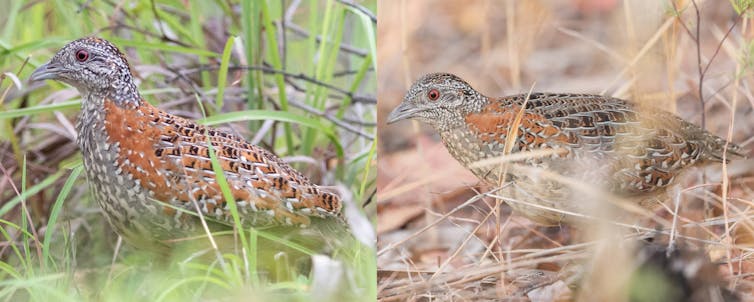
This apparently breeding-related change in plumage was completely unknown, and its seasonal timing coincided with an increase in reports of the buff-breasted button-quail.
In short, with no hard evidence of the buff-breasted button-quail’s existence for 100 years, many of the most recent sightings of the species could actually have been the much more common painted button-quail.
This means the buff-breasted button-quail is likely far rarer than we could ever have ever feared.
What Does Its Future Hold?
When McLennan collected the last buff-breasted button-quail skin, the Tasmanian tiger roamed Tasmania’s forests, and the paradise parrot was still nesting in termite mounds in south east Queensland.
We realised too late that these unique species were in decline. Have we made the same mistake with the buff-breasted button-quail?
We already knew the bird was rare, but was our confidence in the species’ status misplaced, propped up by misidentifications of a more common species?
Aside from a clutch of eggs collected in 1924, there has been no incontrovertible proof the species continues to exist. Our extensive searches at sites where it was once found have failed.
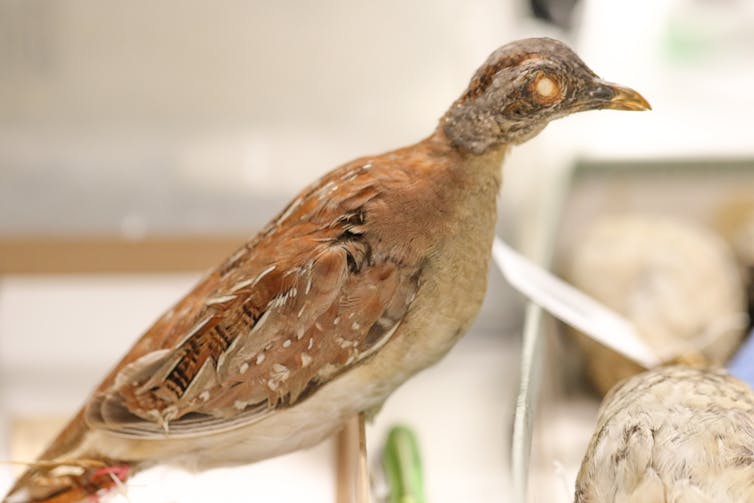
We also know the bird communities of Cape York have been changing at a rapid rate, mostly due to the impact of changed fire patterns and cattle grazing. Other iconic Cape York species – such as the golden-shouldered parrot and red goshawk – have also declined over the past decades.
It seems likely the buff-breasted button-quail has suffered the same fate. It may not be extinct, but our research suggests it may only be hanging on by a thread, at best.
This 100-year anniversary is an opportunity to recognise the bird’s dire situation. Our new findings should prompt the federal and Queensland governments to act.
First, they should invoke the precautionary principle, which is to improve conservation actions for the species in light of its uncertain status. They should also immediately up-list the species to critically endangered, as right now it’s listed only as endangered.
Second, they should urgently provide the resources needed to re-evaluate the species’ conservation needs, as the status quo is not working.
We hope these efforts will prove the species is still in existence – perhaps living in a previously unsurveyed part of Cape York – and not another one that has disappeared on our watch.![]()
Patrick Webster, PhD candidate, The University of Queensland
This article is republished from The Conversation under a Creative Commons license. Read the original article.
‘Time is their secret weapon’: the hidden grey army quietly advancing species discovery in Australia
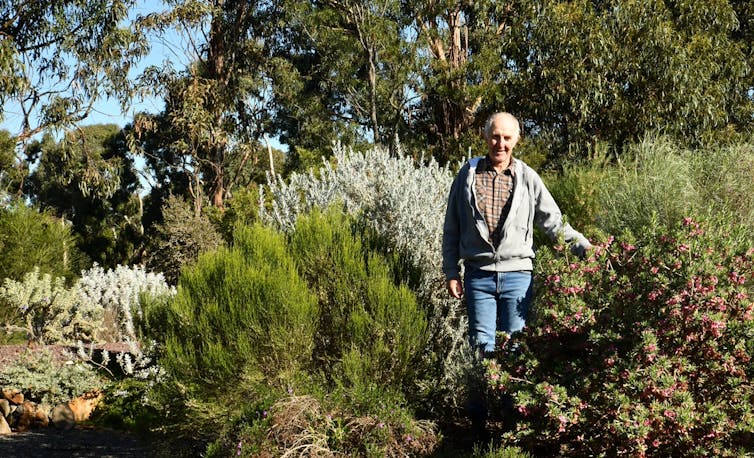
Each year, many new species of Australian plants, animals and fungi are discovered and described. It’s detailed, time-consuming work, and much of it could not be done without the contribution of older Australians.
I’m an evolutionary botanist and I use DNA sequencing to better understand relationships between plant species – a field known as phylogenetics. My job involves collecting plant specimens in the furthest corners of Australia.
Time and again I’m helped by older, generally retired Australians with a passion for the plants I’m working on. In their own time and with their own resources, they take it upon themselves to explore and document a particular geographic area or group of plants.
Many have a professional scientific background, although not necessarily in the field they now contribute to. For these dedicated men and women, passion is their driver and time their secret weapon.
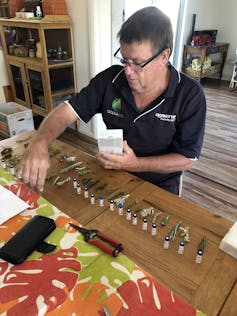
Without these older Australians, my research wouldn’t be where it is today. So let me introduce you to a few of them.
Bevan Buirchell, Ron Dadd And Russell Wait
From opposite sides of the country – Bevan and Ron in Western Australia and Russell in Victoria – these three collectors discover, sample and grow extensive collections of emu bush (Eremophila).
More than 200 species of emu bush have been described, and many are rare, threatened or endangered.
Emu bush is a culturally important plant for many Indigenous Australians, and recent research has revealed the genus contains many new chemical compounds of interest for medicinal use.
Each year, the trio spends weeks four-wheel driving in arid and remote parts of Australia where emu bush is thought to be found.
When the men come across something interesting, they record scientific details and collect a cutting for propagation in their own or each other’s gardens.
Between them, Bevan, Ron and Russell have collections of almost every described species of emu bush, and new species awaiting formal description. So far, Bevan has described 16 new species or subspecies.
In this way, their gardens are like living museums of species diversity. They’re a great resource for the inclusion of species in phylogenetic research.
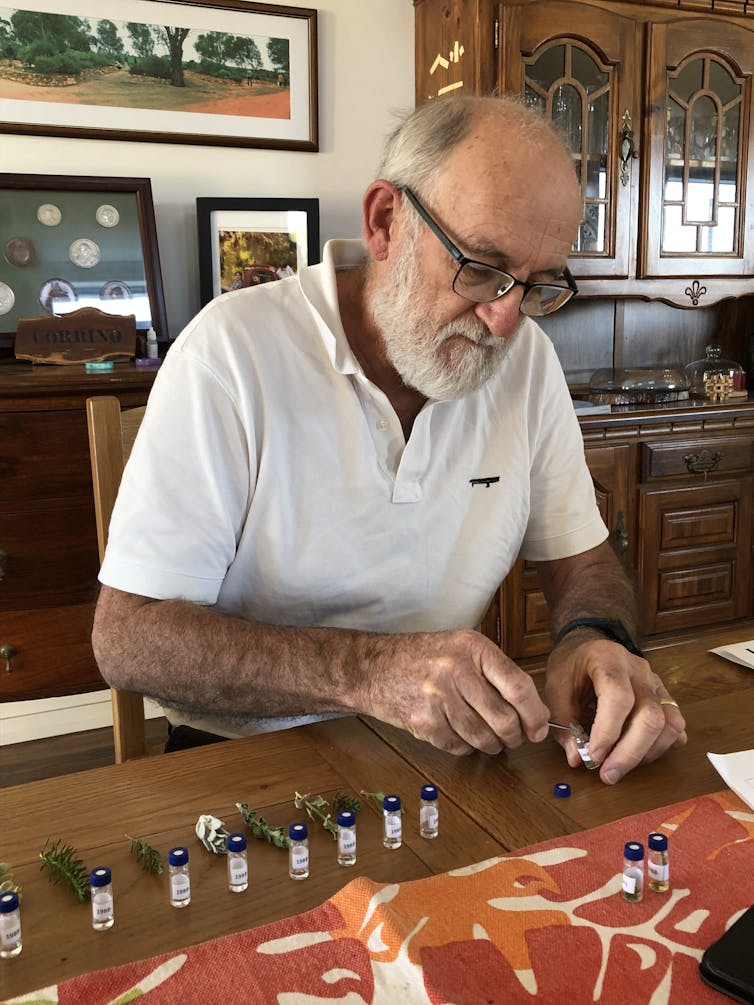
Don Franklin
In the tablelands of Far North Queensland, retired ecologist Don Franklin spends his time expanding his knowledge of eucalypts.
A colleague put me in touch with Don when I was planning fieldwork to collect eucalypt species for my latest research project. Don was happy to help, assisting me with planning my collection route to ensure I sampled not just every species possible, but all the interesting variants he knows from different regions.
This on the ground experience is invaluable for my work, and impossible to gain from published literature alone.
Don is writing a comprehensive field study for eucalypt species spanning about 80,000 square kilometres. Over the past five years he’s travelled every road in the area, marking species distributions, morphological variants and regions of hybrid zones.
Don was my guide and assistant for a few weeks of field work, and my understanding of this group of plants benefited immeasurably.
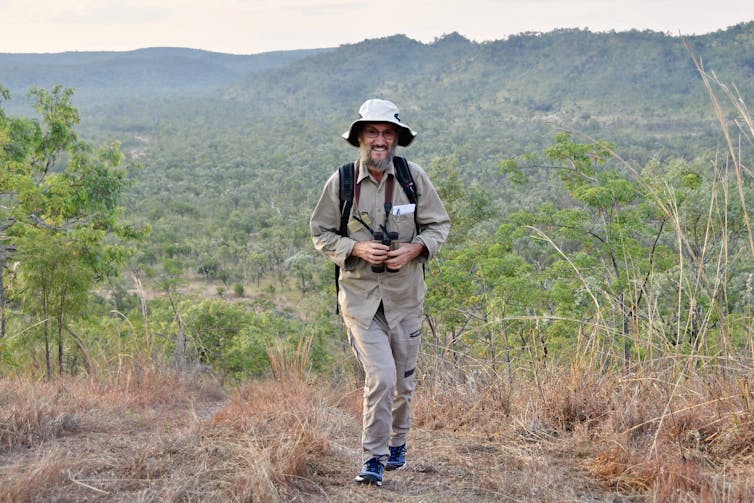
Margaret Brookes
Margaret is a retired horticulturalist. For the past decade she’s volunteered at the National Herbarium of Victoria and the University of Melbourne Herbarium, where she helps curate the collections.
Over this period, Margaret’s work has included mounting thousands of new specimens submitted by researchers like me, and processing the backlog of old collections. Margaret has also transcribed historical field notes for plant collectors in decades and even centuries past.
Margaret’s work makes these plant collections accessible to researchers and the general public all over the world.
Continual advances in genetic sequencing technology mean we can increasingly access DNA from older and older dried specimens. In this way, the work done by Margaret and other herbarium volunteers becomes even more essential in discovering and classifying new species.
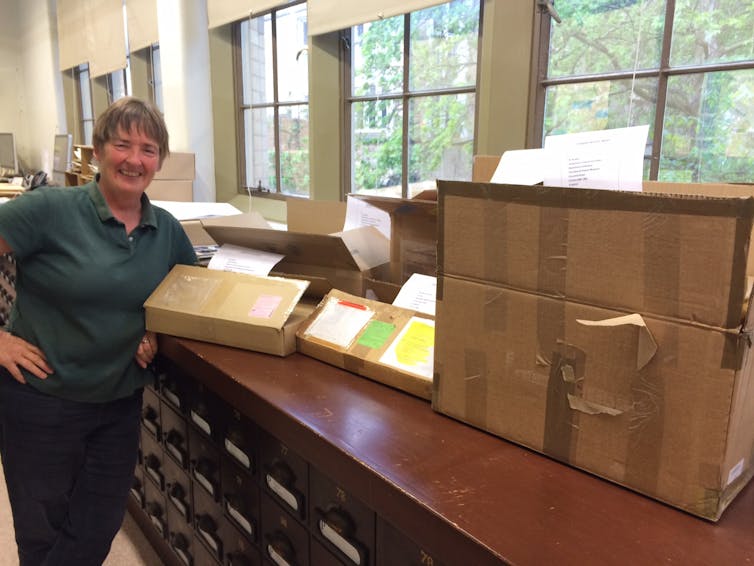
Combining Forces With Senior-Citizen Scientists
As an early career researcher I am bound by two to three year funding contracts. In that short time, samples must be collected and genetically sequenced, then analysed and the results interpreted.
And to come up with plausible hypotheses to understand species’ relationships, my expertise must be broad. I’ve got to be good in the lab, proficient at analysis and across the latest literature.
To produce high-quality work in such tight time frames, I rely on the hidden “grey army” of older people such as those described above.
And while I can only speak from personal experience, I daresay many fields of natural science also benefit from a dedicated older generation quietly contributing to the body of scientific knowledge.
We must recognise the invaluable contributions made by older volunteer researchers. And if we’re to have any chance of better understanding the estimated 70% of Australia’s biodiversity unknown to science, their continued involvement is imperative.
For those interested in volunteering or citizen science projects, try contacting your nearest herbaria. You could also check out the Atlas of Living Australia’s DigiVol volunteer portal or the Australian Citizen Science Association.![]()
Rachael Fowler, Post doctoral research fellow plant evolution, The University of Melbourne
This article is republished from The Conversation under a Creative Commons license. Read the original article.
The stunning recovery of a heavily polluted river in the heart of the Blue Mountains World Heritage area

For more than 40 years, an underground coal mine discharged poorly treated wastewater directly into the Wollangambe River, which flows through the heart of the Blue Mountains World Heritage area.
Much of this spectacular wild river was chronically polluted, with dangerously high levels of zinc and nickel. Few animals were able to survive there.
My colleagues and I had been calling for tougher regulations to clean-up the wastewater flow since 2014, after we first sampled the river for our research. Finally, with the Blue Mountains community rallying behind us, the New South Wales Environment Protection Agency (EPA) enforced stronger regulations in 2020.
Our latest research paper documents the Wollangambe River’s recovery since. Already we’ve seen a massive improvement to the water quality, with wildlife returning to formerly polluted sites in stunning numbers.
In fact, the long fight for the restoration of this globally significant river is the focus of a new documentary, Mining the Blue Mountains, released this week (and online in coming days).
But while the recovery so far is promising, it remains incomplete. Much more action is needed to return the river to its former health.
How Bad Was The River?
When the federal government nominated the Blue Mountains to be inscribed on the World Heritage list in 1998, it claimed “some coal mining operations occur nearby, but do not affect the water catchments that drain to the area”.
Our research has shown this not to be true, and the pollution of this river has generated international concern. In 2020, the International Union for Conservation of Nature – an official advisor to UNESCO – identified the coal mine as a major threat to the conservation values of the Greater Blue Mountains World Heritage area.
So, how bad was the pollution? Our previous survey conducted nine years ago investigated both water quality and river invertebrates – mostly aquatic insects.
Wastewater from the underground coal mine Clarence Colliery entered the Wollangambe River about 1.5 kilometres upstream of the World Heritage area boundary. The nature of the pollution was complex, but of most serious concern was the increased concentrations of nickel and zinc in the river.
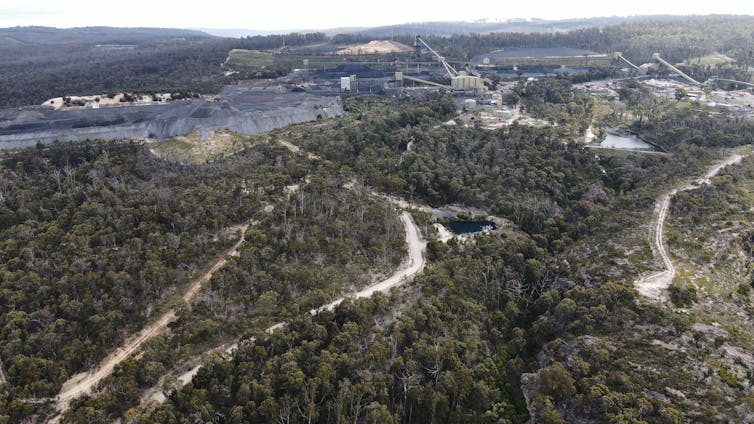
These metals were unusually enriched for coal wastewater, with both at concentrations more than 10 times known safe levels. The pollution remained dangerous for more than 20km downstream, deep within the World Heritage area.
Compared to upstream and unaffected reference streams, we found the abundance of invertebrates in the Wollangambe fell by 90%, with the diversity of invertebrate families 65% lower below the mine waste outfall.
There was also a build-up of contaminants into the surrounding foodchain. For example, one of our studies detected metals accumulated in plants growing on the river bank. Another found a build-up in the tissue of aquatic beetles below the mine outfall.
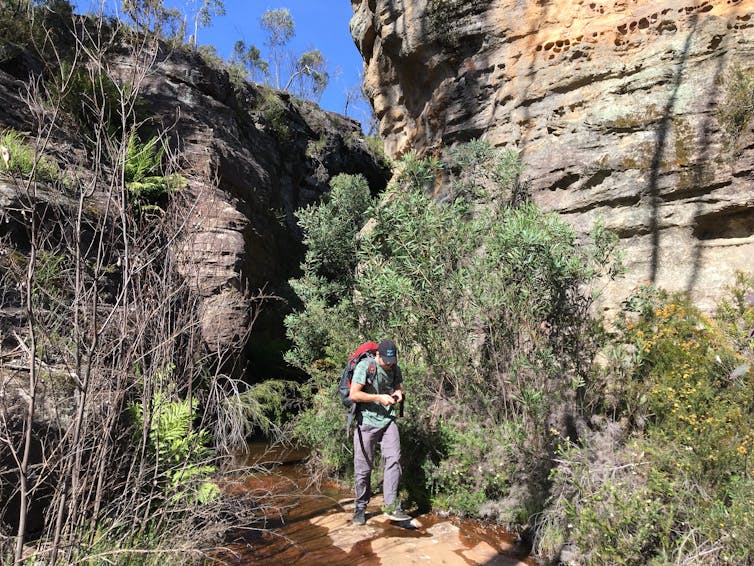
Life Returns To The River
In 2014 we not only shared our published research findings with the NSW EPA, but also with the Blue Mountains community. This triggered a letter writing campaign from the Blue Mountains Conservation Society urging the EPA to take action.
After five long years, the EPA finally issued stringent regulations requiring Clarence Colliery to make enormous reductions in the release of pollutants, particularly zinc and nickel, in the colliery waste discharge.
And it worked! We collected samples 22km downstream of the river, and were very surprised at the speed and extent of ecological recovery. Not only has water quality improved, but animals are coming back, too.

The improved treatment resulted in a very significant reduction of zinc and nickel concentrations in the mine’s wastewater, which continues to be closely monitored and publicly reported by the colliery.
The most pollution-sensitive groups of invertebrates – mayflies, stoneflies and caddisflies – had a steep increase (256%) in their abundance compared to when we conducted our earlier research in 2012 and 2013.
This could have positive implications for the surrounding plants and animals, as river invertebrates are a major food source for water birds, lizards, fish and platypus.

However, the road to recovery is a long one. River sediments remain contaminated by the build-up of four decades of zinc and nickel enrichment, up to 2km downstream of the mine outfall.
To help speed up the river’s recovery, contaminated sediment should be removed from the river below the mine outfall, similar to a 12-month clean-up operation conducted after a major spill from the mine in 2015.
Pollution Doesn’t Often End When Mines Do
Sadly, there are closed mines in the Blue Mountains that continue to release damaging pollution, such as Canyon Colliery and several in the Sunny Corner gold mine area, as the documentary explores.
Canyon Colliery closed in 1997, and contaminated groundwater continues to be discharged from its drainage shafts into the Grose River, which is part of the Blue Mountains World Heritage Area.
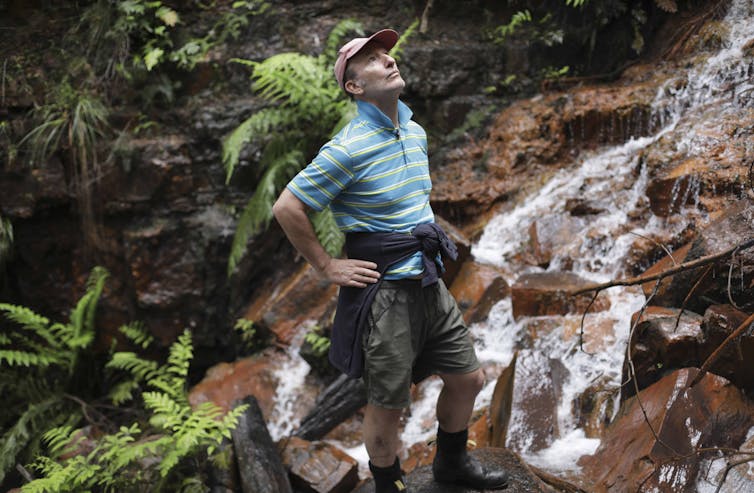
Likewise, most Sunny Corner mines closed over a century ago, and yet severe pollution still seeps from the mines into waterways.
The pollution here is at extreme concentrations and includes arsenic, copper, lead and zinc. It’s dangerous to life in waterways, surrounding soil and contact with this pollution is hazardous to human health.
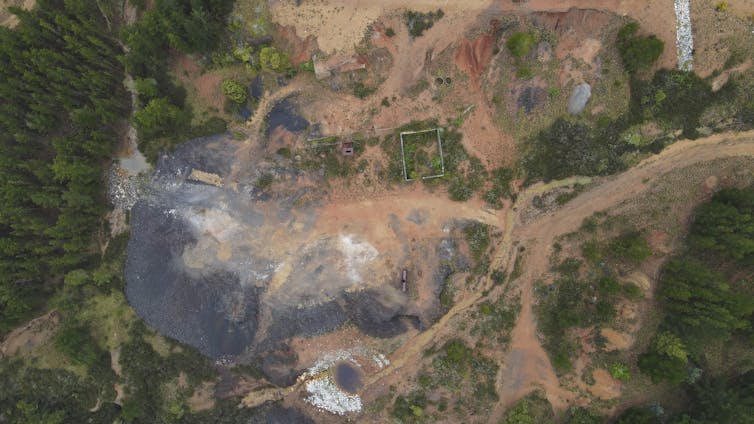
What Can We Learn From This?
Rehabilitating these closed mines are expensive, and often with limited success. But the Wollangambe River case study is an encouraging sign that clean-up is possible for even the most polluted environments.
Solid independent scientific research and community involvement are critical for these efforts. The community is the eyes and ears of the environment, and has an important role holding industry and government regulators to account.
The environmental regulators, such as NSW EPA, have enormous power to address pollution and trigger positive change. It’s important researchers and the community engages with them – and it helps to be patient as action can take years to happen.
And finally, we congratulate Centennial Coal, the owners of the Clarence Colliery, for making enormous improvements to their operation and complying with tough new environmental regulations.![]()
Ian Wright, Senior Lecturer in Environmental Science, Western Sydney University; Jason Reynolds, Senior Lecturer, Western Sydney University, and Leo Robba, Lecturer, Visual Communications / Social Design, Western Sydney University
This article is republished from The Conversation under a Creative Commons license. Read the original article.
Just 16% of the world’s coastlines are in good shape – and many are so bad they can never fully recover
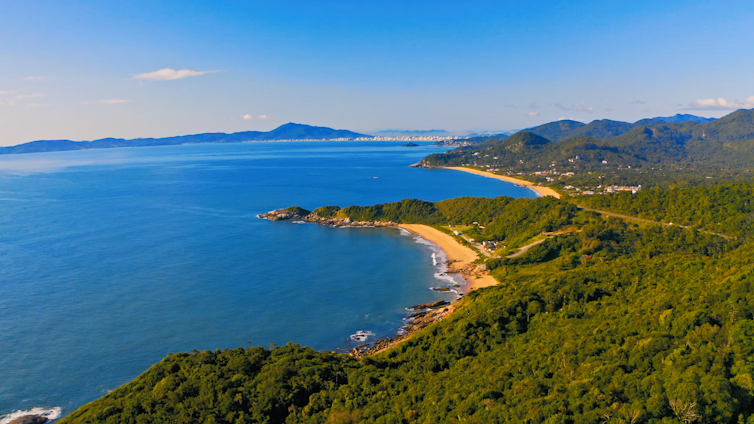
Only about 16% of the world’s coastal regions are in relatively good condition, according to our world-first research released today, and many are so degraded they can’t be restored to their original state.
Places where the land meets the sea are crucial for our planet to function. They support biodiversity and the livelihoods of billions of people. But to date, understanding of the overall state of Earth’s coastal regions has been poor.
Our research, involving an international team of experts, revealed an alarming story. Humanity is putting heavy pressure on almost half the world’s coastal regions, including a large proportion of protected areas.
All nations must ramp up efforts to preserve and restore their coastal regions – and the time to start is right now.
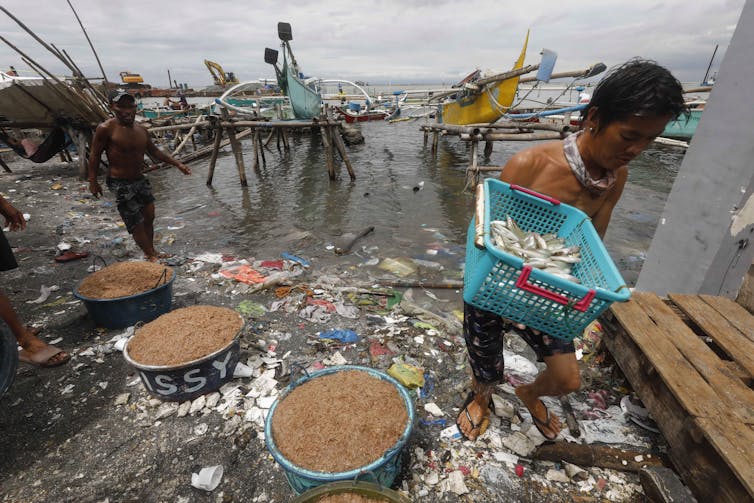
Our Coasts Are Vital – And Vulnerable
Coastal regions encompass some of the most diverse and unique ecosystems on Earth. They include coral reefs, kelp forests, seagrass, tidal flats, mangroves, estuaries, salt marshes, wetlands and coastal wooded habitat.
Many animal species, including those that migrate, rely on coastlines for breeding, foraging and protection. Coastal sites are also where rivers discharge, mangrove forests exchange nutrients with the ocean, and tidal flows are maintained.
Humans also need coastlines. Among other functions, they support our fisheries, protect us from storms and, importantly, store carbon to help mitigate climate change.
As much as 74% of the world’s population live within 50 kilometres of the coast, and humans put pressure on coastal environments in myriad ways.
In marine environments, these pressures include:
- fishing at various intensities
- land-based nutrient, organic chemical and light pollution
- direct human impacts such as via recreation
- ocean shipping
- climate change (and associated ocean acidification, sea-level rise and increased sea surface temperatures).
On land, human pressures on our coastlines include:
- built environments, such as coastal developments
- disturbance
- electricity and transport infrastructure
- cropping and pasture lands, which clears ecosystems and causes chemical and nutrient runoff into waterways.
To date, assessments of the world’s coastal regions have largely focused solely on either the land or ocean, rather than considering both realms together. Our research sought to address this.

A Troubling Picture
We integrated existing human impact maps for both land and ocean areas. This enabled us to assess the spectrum of human pressure across Earth’s coastal regions to identify those that are highly degraded and those intact.
Both maps use data up to the year 2013 – the most recent year for which cohesive data is available.
No coastal region was free from human influence. However, 15.5% of Earth’s coastal regions remained intact – in other words, humans had exerted only low pressure. Many of the intact coastal regions were in Canada, followed by Russia and Greenland.
Large expanses of intact coast were also found elsewhere including Australia, Indonesia, Papua New Guinea, Chile, Brazil and the United States.
Troublingly, 47.9% of coastal regions have been exposed to very high levels of human pressure. And for 84% of countries, more than half their coastal regions were degraded.
What’s more, human pressures were high in about 43% of protected coastal regions – those regions purportedly managed to conserve nature.
Coastal regions containing sea grasses, savannah and coral reefs had the highest levels of human pressure compared to other coastal ecosystems. Some coastal regions may be so degraded they cannot be restored. Coastal ecosystems are highly complex and once lost, it is likely impossible to restore them to their original state.
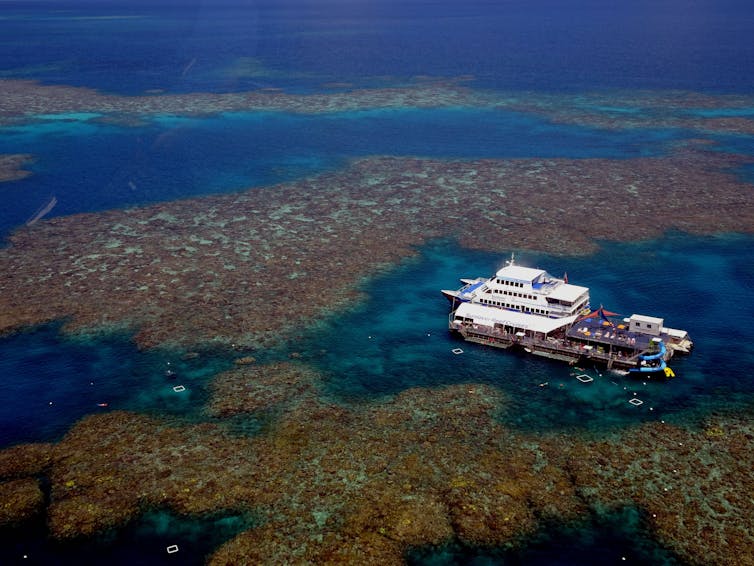
So Where To Now?
It’s safe to say intact coastal regions are now rare. We urge governments to urgently conserve the coastal regions that remain in good condition, while restoring those that are degraded but can still be fixed.
To assist with this global task, we have made our dataset publicly available and free to use here.
Of course, the right conservation and restoration actions will vary from place to place. The actions might include, but are not limited to:
improving environmental governance and laws related to encroaching development
increasing well-resourced protected areas
mitigating land-use change to prevent increased pollution run-off
better community and local engagement
strengthening Indigenous involvement in managing coastal regions
effective management of fishing resources
addressing climate change
tackling geopolitical and socioeconomic drivers of damage to coastal environments.
In addition, there’s an urgent need for national and global policies and programs to effectively managing areas where the land and ocean converge.
Humanity’s impact on Earth’s coastal regions is already severe and widespread. Without urgent change, the implications for both coastal biodiversity and society will become even more profound.![]()
Brooke Williams, Postdoctoral research fellow, The University of Queensland; Amelia Wenger, Research fellow, The University of Queensland, and James Watson, Professor, The University of Queensland
This article is republished from The Conversation under a Creative Commons license. Read the original article.
COP26 Deal Sparks Hope For Positive Tipping Points
February 8, 2022
The Breakthrough Agenda agreed at COP26 could help trigger positive tipping points to tackle the climate crisis, researchers say. At the summit in Glasgow, leaders of countries covering 70% of world GDP pledged to "make clean technologies and sustainable solutions the most affordable, accessible and attractive option in each emitting sector globally before 2030."
This signals a key shift in thinking -- instead of focussing directly on emissions targets, it aims to tip economic sectors into a new state where the "green" option is cheapest and easiest.
A tipping point occurs when a small intervention sparks a rapid, often irreversible transformation -- and a new paper offers a "recipe" for finding and triggering positive tipping points.
"The only way we can get anywhere near our global targets on key issues like carbon emissions and biodiversity is through positive tipping points," said lead author Professor Tim Lenton, Director of the Global Systems Institute (GSI) at the University of Exeter.
"The challenges are enormous -- we need to cut greenhouse gas emissions in half by 2030, and reverse biodiversity loss to make our impact 'nature-positive'.
"The Breakthrough Agenda is the first time a large group of countries has agreed joint climate change goals in the form of economic tipping points.
"We argued for precisely this in a previous paper, and we are heartened to see world leaders adopting this approach.
"Our new paper shows a variety of ways that tipping points can be activated.
"Societies worldwide will need to put all of these into action to bring about low-carbon transitions at the pace and scale required to avoid dangerous climate change."
The paper examines the "enabling conditions" for a tipping point (such as the declining price of a green technology), and how the tipping point can be triggered (for example by coalitions of committed individuals).
Combinations of factors such as cost and public attitude have helped to trigger tipping points in electric vehicles and solar energy, and both are rapidly advancing around the world -- which in turn leads to feedbacks of technological improvements and lower costs.
Greta Thunberg's climate protest triggered a global surge of activism that continues to grow, with diverse impacts.
Asked about positive tipping points that could soon be triggered -- or might already be tipping -- Professor Lenton highlighted the growth and uptake of plant-based diets, including meat substitutes.
Co-author Scarlett Benson, from global sustainability consultancy SYSTEMIQ, said: "Policymakers have a critical role in triggering the shift away from meat-rich diets, for example by investing the trillions of dollars of public R&D spend into the development of plant-based and cell-based meat and dairy alternatives, and by directing the trillions of dollars of public procurement spend towards these products to stimulate demand and drive down costs."
Co-author Dr Tom Powell, from GSI, added: "In other cases, transformation can start with grassroots communities.
"For subsistence farmers facing land degradation and drought, regenerative farming methods can help rebuild the health of their soils and ecosystems, making them more resilient. A farmer-led scheme called TIST has spread to over 150,000 subsistence farmers in East Africa, because it supports farmers to share these practices and learn from one another.
"International voluntary carbon markets have enabled TIST members to collectively access payments for carbon sequestered in trees on their land, building in a further reinforcing feedback."
The researchers say positive tipping points can help to counter widespread feelings of disempowerment in the face of global challenges, and they stress that everyone can play a part in triggering positive tipping points.
"These changes often start with small groups of people with a big idea," said Professor Lenton.
"These can become networks of change that grow into large movements with a major impact.
"Public and private money is also important. Public money is often first, funding research and development, and private finance then comes to drive an idea at scale."
The paper notes the importance of equity when seeking to trigger tipping points. The authors write: "It is vital to consider what social safety nets can help ensure a just transformation."
The researchers say their framework for finding and triggering tipping points needs "testing and refining," adding: "There is no better way forward than to learn by doing.
"Continuing to delay action to accelerate a just transformation towards global sustainability will only accentuate the need to find and trigger even more dramatic positive tipping points in the future."
The paper, written by a team including researchers from Hamburg University and University College London and published in the journal Global Sustainability, is entitled: "Operationalising Positive Tipping Points towards Global Sustainability."
Timothy M. Lenton, Scarlett Benson, Talia Smith, Theodora Ewer, Victor Lanel, Elizabeth Petykowski, Thomas W. R. Powell, Jesse F. Abrams, Fenna Blomsma, Simon Sharpe. Operationalising positive tipping points towards global sustainability. Global Sustainability, 2022; 5 DOI: 10.1017/sus.2021.30
Lotus Effect: Self-Cleaning Bioplastics Repel Liquid And Dirt
Pacific Ocean As The Greatest Theatre Of Bird Migration
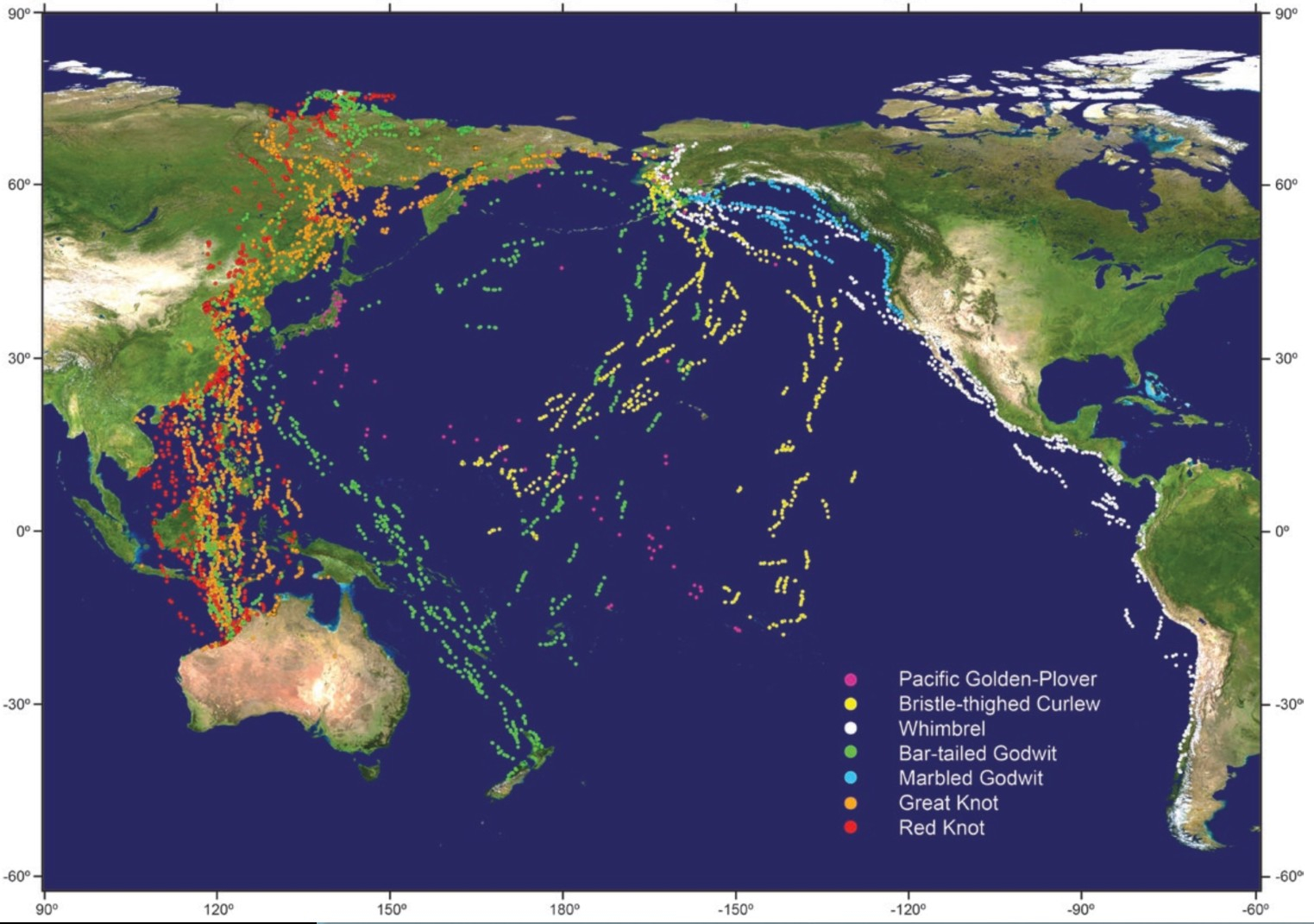
Pink Pumice Key To Revealing Explosive Power Of Underwater Volcanic Eruptions
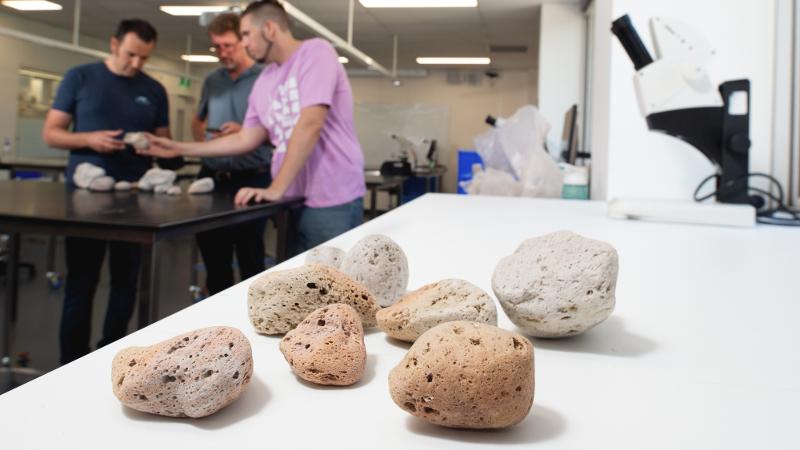 In research published in the Nature portfolio journal Communications Earth and Environment, the researchers including Professor Scott Bryan, Dr Michael Jones and PhD candidate Joseph Knafelc, were intrigued by the occurrence of pink pumice within the massive pumice raft that resulted from the Havre 2012 deep-sea eruption.
In research published in the Nature portfolio journal Communications Earth and Environment, the researchers including Professor Scott Bryan, Dr Michael Jones and PhD candidate Joseph Knafelc, were intrigued by the occurrence of pink pumice within the massive pumice raft that resulted from the Havre 2012 deep-sea eruption.
Unique Seagrass Nursery Aims To Help Florida's Starving Manatees
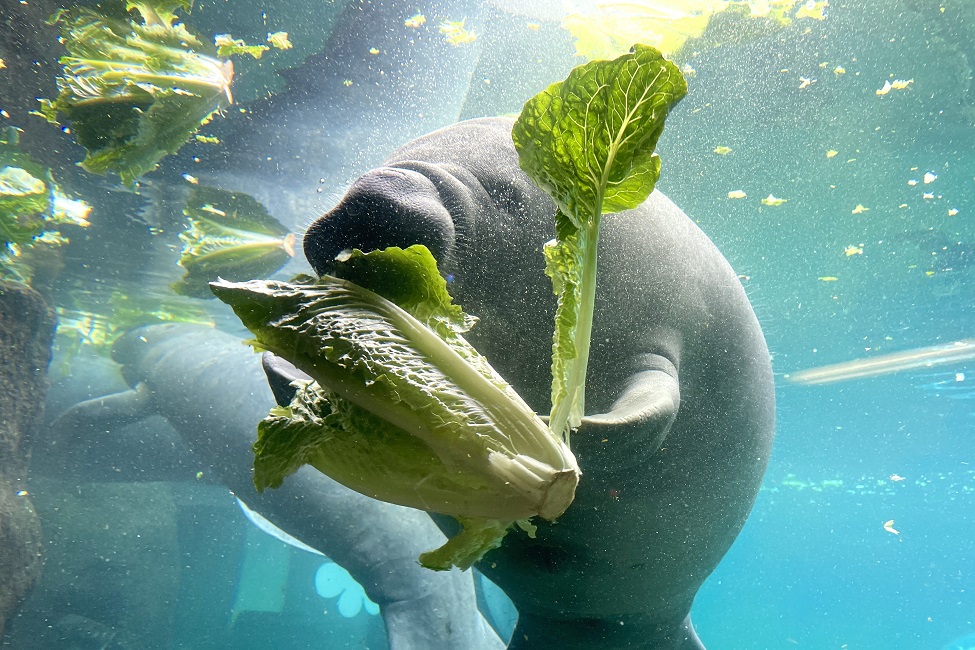
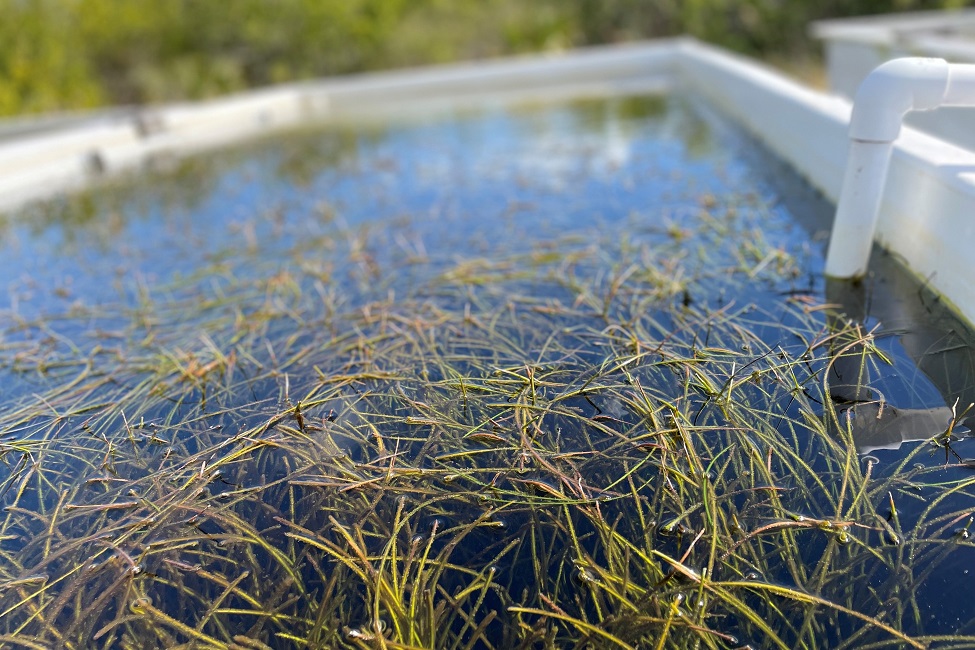
Genome Of Steller’s Sea Cow Decoded
February 8, 2022
During the Ice Age, giant mammals such as mammoths, sabre-toothed cats and woolly rhinoceroses once roamed Northern Europe and America. The cold oceans of the northern hemisphere were also home to giants like Steller's sea cow, which grew up to eight meters long and weighed up to ten tons, and has been extinct for around 250 years. Now an international research team has succeeded in deciphering the genome of this ice-age species from fossil bones. They also found an answer to the question of what the genome of this extinct species of sea cow reveals about present-day skin diseases.
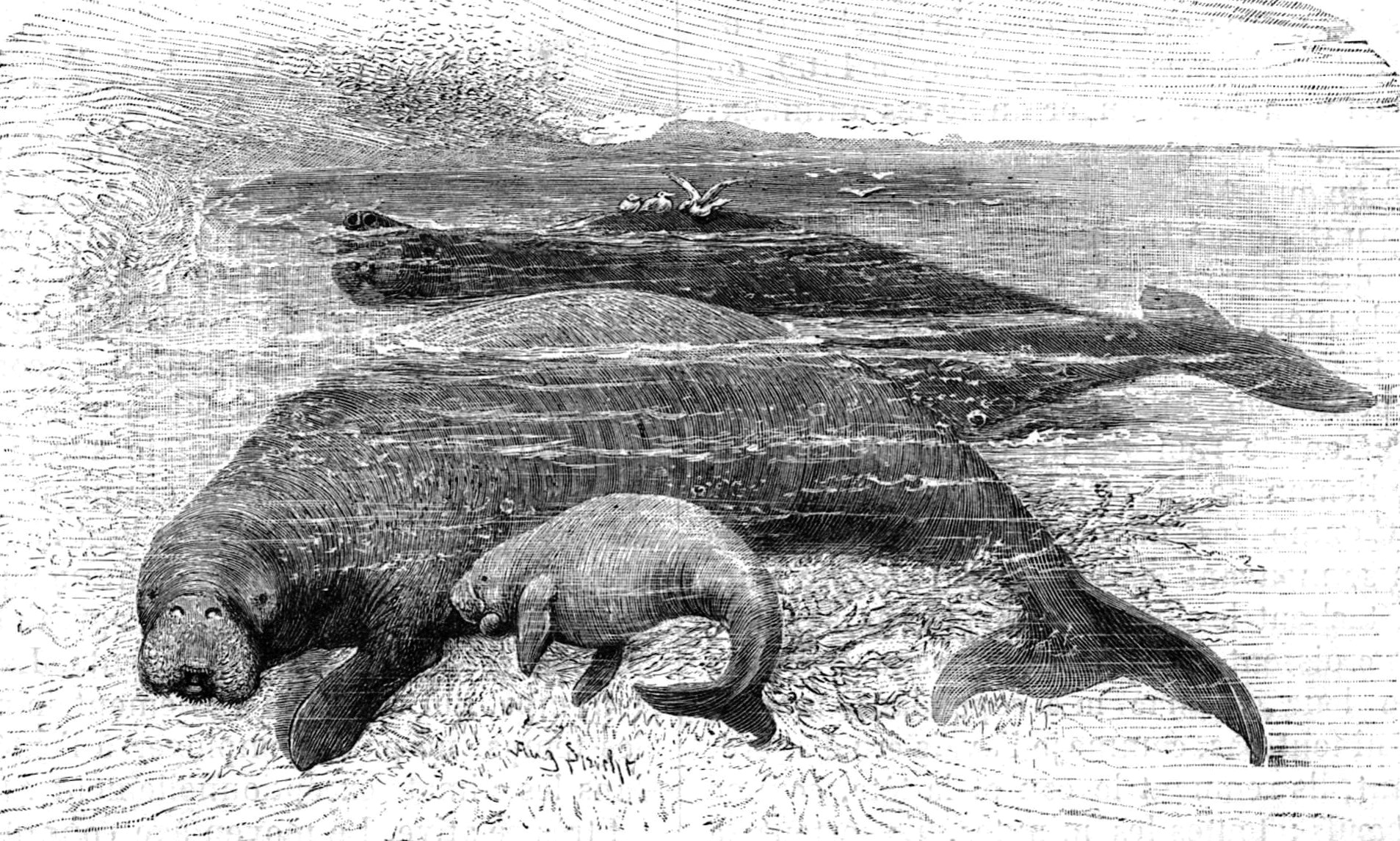
1898 illustration of a Steller's sea cow family
The giant sea cow from the Ice Age was discovered in 1741 by Georg Wilhelm Steller and later named after him. The 18th-century naturalist was interested not only in the enormous size of this animal species but also in its unusual, bark-like skin. He described it as "a skin so thick that it is more like the bark of old oaks than the skin of an animal."
Such a bark-like structure of the epidermis is not found in related sirenians, which today live exclusively in tropical waters. In scientific circles, it was previously assumed that the bark-like epidermis was the result of parasite feeding, but also insulated heat and thus protected the sea cow well from the cold during the Ice Age and from injuries in the polar seas.
In the current study, the scientists led by Dr Diana Le Duc and Professor Torsten Schöneberg from Leipzig University, Professor Michael Hofreiter from the University of Potsdam and Professor Beth Shapiro from the University of California, show that the palaeogenomes of Steller's sea cow reveal functional changes. These changes were responsible for the bark-like skin and the adaptation to cold.
To find this out, an international research team from Germany and the US reconstructed the genome of this extinct species from fossil bone remains of a total of twelve different individuals.
"The most spectacular result of our investigations is that we have clarified why this giant of the sea had bark-like skin," said Diana Le Duc from the Institute of Human Genetics at Leipzig University Hospital. The scientists found inactivations of genes in the sea cow genome that are necessary for the normal structure of the outermost layer of the epidermis. These genes are also used in human skin.
"Hereditary defects in these so-called lipoxygenase genes lead to what is known as ichthyosis in humans. This is characterised by a thickening and hardening of the top layer of skin with large scales, and is sometimes also known as 'fish scale disease'," said Schöneberg from the Rudolph Schönheimer Institute of Biochemistry.
"The results of our research thus also sharpen our view of this clinical picture," explained the biochemist, adding: "Here may lie the key to new therapeutic approaches."
The scientists pinpointed the genetic defect by comparing the genome with that of the closest relative, the dugong. The researchers received support with their investigations from the Max Planck Institute for Evolutionary Anthropology in Leipzig, which contributed its bioinformatics expertise in the analysis of ancient DNA. As a result, they identified important evidence of genetic changes that may have contributed to adaptation to the cool North Pacific habitat.
"This is an impressive example of how gene defects can not only cause disease, but also have advantages depending on the habitat," said Hofreiter from the University of Potsdam. Furthermore, the genome data revealed a dramatic reduction in population size. This began 500,000 years before the species was discovered and may have contributed to its extinction.
Hofreiter summed it up as follows: "With today's molecular genetic clarification, our study closes the circle of an exact observation by a German naturalist in the early 18th century."
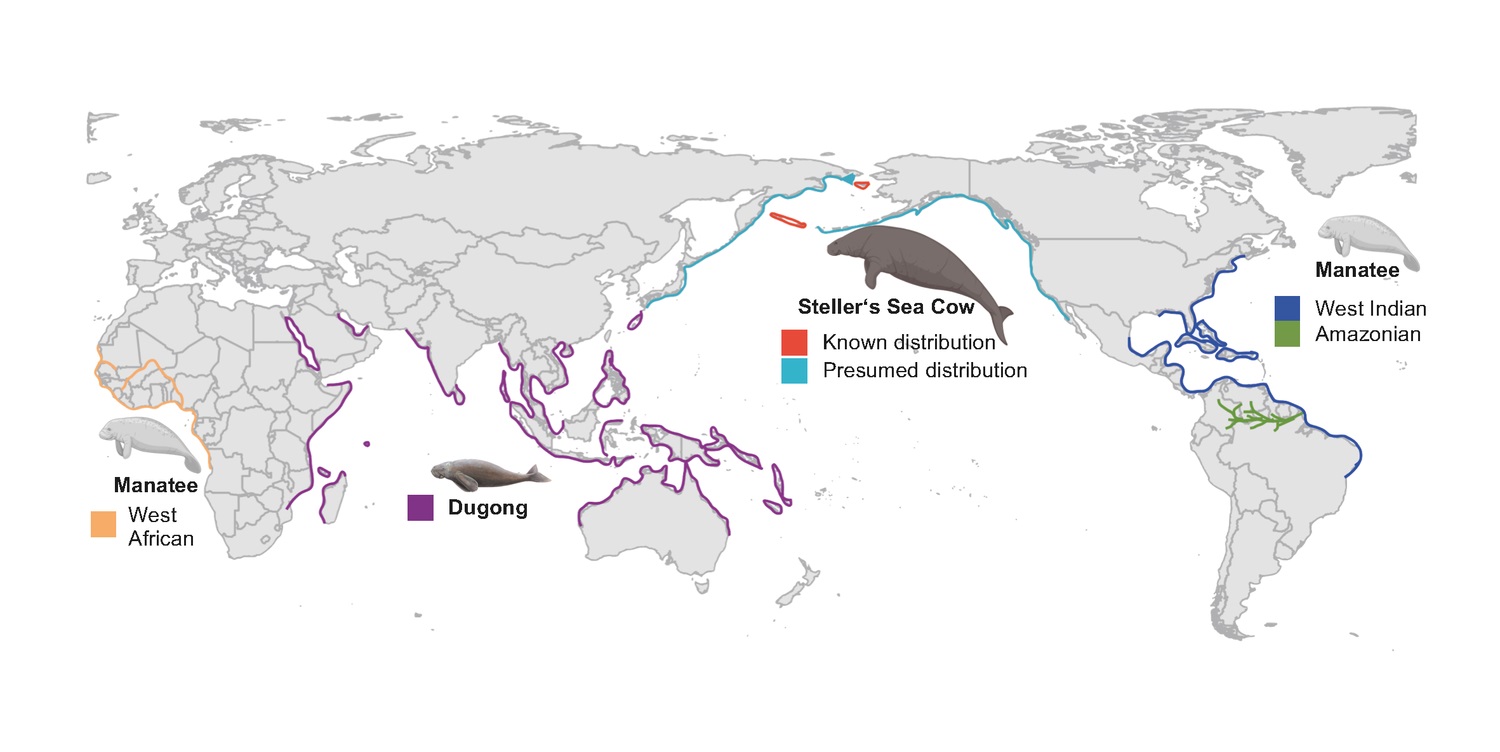
Distribution of sea cow species in the world’s oceans. Image: Diana Le Duc
Diana Le Duc, Akhil Velluva, Molly Cassatt-Johnstone, Remi-Andre Olsen, Sina Baleka, Chen-Ching Lin, Johannes R. Lemke, John R. Southon, Alexander Burdin, Ming-Shan Wang, Sonja Grunewald, Wilfried Rosendahl, Ulrich Joger, Sereina Rutschmann, Thomas B. Hildebrandt, Guido Fritsch, James A. Estes, Janet Kelso, Love Dalén, Michael Hofreiter, Beth Shapiro, Torsten Schöneberg. Genomic basis for skin phenotype and cold adaptation in the extinct Steller’s sea cow. Science Advances, 2022; 8 (5) DOI: 10.1126/sciadv.abl6496
Gabon Provides Blueprint For Protecting Oceans
February 8, 2022
Gabon's network of Marine Protected Areas (MPAs) provides a blueprint that could be used in many other countries, experts say. Since announcing a new MPA network in 2014, Gabon has created 20 protected areas -- increasing protection of Gabonese waters from less than 1% to 26%.
The new paper -- by Gabonese policymakers, NGOs and researchers from the University of Exeter -- highlights the lessons from this work and its relevance elsewhere.
"A combination of factors made this MPA network possible, but a crucial first step was the creation by President Ali Bongo Ondimba of a government-led initiative called 'Gabon Bleu' in 2013," said Dr Kristian Metcalfe, of the Centre for Ecology and Conservation at Exeter's Penryn Campus in Cornwall.
"This sent out a clear signal that the Gabonese government wanted to develop an MPA network.
"That ensured all sectors -- from government agencies to ocean resource users -- were engaged in the planning process, and it gave confidence to external funders and the private sector to support the research that underpins the MPAs.
Dr Emma Stokes, Wildlife Conservation Society Regional Director for Central Africa & Gulf of Guinea, added: "This political will and long-term engagement was vital -- creating a 'tipping point' towards effective change.
"Collective action has accelerated progress, and the country has now committed to the 30x30 pledge to protect 30% of its oceans by 2030."
Global MPA coverage is still short of a 10% target set in 2010, partly due to limited progress in many low-income and middle-income countries.
However, a few of these countries -- including Gabon -- have met or exceeded international commitments on land and sea.
The MPAs are based on detailed evidence, resulting in an inter-connected network tailored to protect important habitats, as well as globally important populations of sea turtles and marine mammals, with protected zones extending from north to south, and from coastal waters to 200 nautical miles offshore.
The new paper argues that lessons from Gabon can be used to inform Post-2020 global biodiversity commitments and implementation.
It suggests a four-step approach for countries and donors:
- Governments must build and maintain their research and implementation capacity, ensuring scientific evidence underpins policy decisions.
- Countries should make public pledges on marine conservation targets, signalling their commitment to the international community and potential donors.
- The conservation community should respond by helping to create or strengthen the country's environmental agencies either directly or, if financial safeguards are weak, via international organisations.
- Each implementation agency should lead on developing national marine conservation frameworks, working with stakeholders and donors to produce plans that are ambitious but politically feasible, combining top-down initiatives with bottom-up approaches as much as possible.
In Gabon, crucial implementation work was led by the national parks agency, ANPN.
Professor Lee White, Gabon's Minister of Forests, Oceans, Environment and Climate Change and former Executive Secretary (head) of ANPN, said: "We learnt from the process that resulted in the creation of Gabon's terrestrial national parks by Omar Bongo in 2007 and were able to provide the scientific and legal framework to make President Ali Bongo Ondimba's vision for a sustainable blue economy a reality."
Professor Brendan Godley, of the University of Exeter, added: "By scaling conservation and fisheries management measures across the entirety of its EEZ, Gabon has made significant steps to ensure the long-term persistence of its marine biodiversity and fisheries resources, and should be celebrated as a global exemplar."
The University of Exeter's work was funded by the UK government's Darwin Initiative.
.JPG.png?timestamp=1644446248220)
Fisheries bycatch in Gabonese waters. Credit Tim Collins WCS
Kristian Metcalfe, Lee White, Michelle E. Lee, J. Michael Fay, Gaspard Abitsi, Richard J. Parnell, Robert J. Smith, Pierre Didier Agamboue, Jean Pierre Bayet, Jean Hervé Mve Beh, Serge Bongo, Francois Boussamba, Godefroy De Bruyne, Floriane Cardiec, Emmanuel Chartrain, Tim Collins, Philip D. Doherty, Angela Formia, Mark Gately, Micheline Schummer Gnandji, Innocent Ikoubou, Judicael Régis Kema Kema, Koumba Kombila, Pavlick Etoughe Kongo, Jean Churley Manfoumbi, Sara M. Maxwell, Georges H. Mba Asseko, Catherine M. McClellan, Gianna Minton, Samyra Orianne Ndjimbou, Guylène Nkoane Ndoutoume, Jean Noel Bibang Bi Nguema, Teddy Nkizogho, Jacob Nzegoue, Carmen Karen Kouerey Oliwina, Franck Mbeme Otsagha, Diane Savarit, Stephen K. Pikesley, Philippe du Plessis, Hugo Rainey, Lucienne Ariane Diapoma Kingbell Rockombeny, Howard C. Rosenbaum, Dan Segan, Guy‐Philippe Sounguet, Emma J. Stokes, Dominic Tilley, Raul Vilela, Wynand Viljoen, Sam B. Weber, Matthew J. Witt, Brendan J. Godley. Fulfilling global marine commitments; lessons learned from Gabon. Conservation Letters, 2022; DOI: 10.1111/conl.12872
Arctic Winter Warming Causes Cold Damage In The Subtropics Of East Asia
February 8, 2022
Due to climate change, Arctic winters are getting warmer. An international study by UZH researchers shows that Arctic warming causes temperature anomalies and cold damage thousands of kilometres away in East Asia. This in turn leads to reduced vegetation growth, later blossoming, smaller harvests and reduced CO2 absorption by the forests in the region.
During the past few days, the east coast of the United States experienced heavy snowfall and low temperatures as far south as Florida. Warmer Arctic winters are now also triggering extreme winter weather of this kind in East Asia, an international team of researchers from Switzerland, Korea, China, Japan and the United Kingdom has found.
The cooler southern winters reduce vegetation activity in the evergreen subtropics, and continue to negatively affect ecosystems in the spring, for example due to branches broken under heavy snowfall or frost-damaged leaves.
First author Jin-Soo Kim of the Department of Evolutionary Biology and Environmental Studies at the University of Zurich says: "The cooler winters also reduce agricultural productivity of cereals, fruits, root vegetables, and legumes."
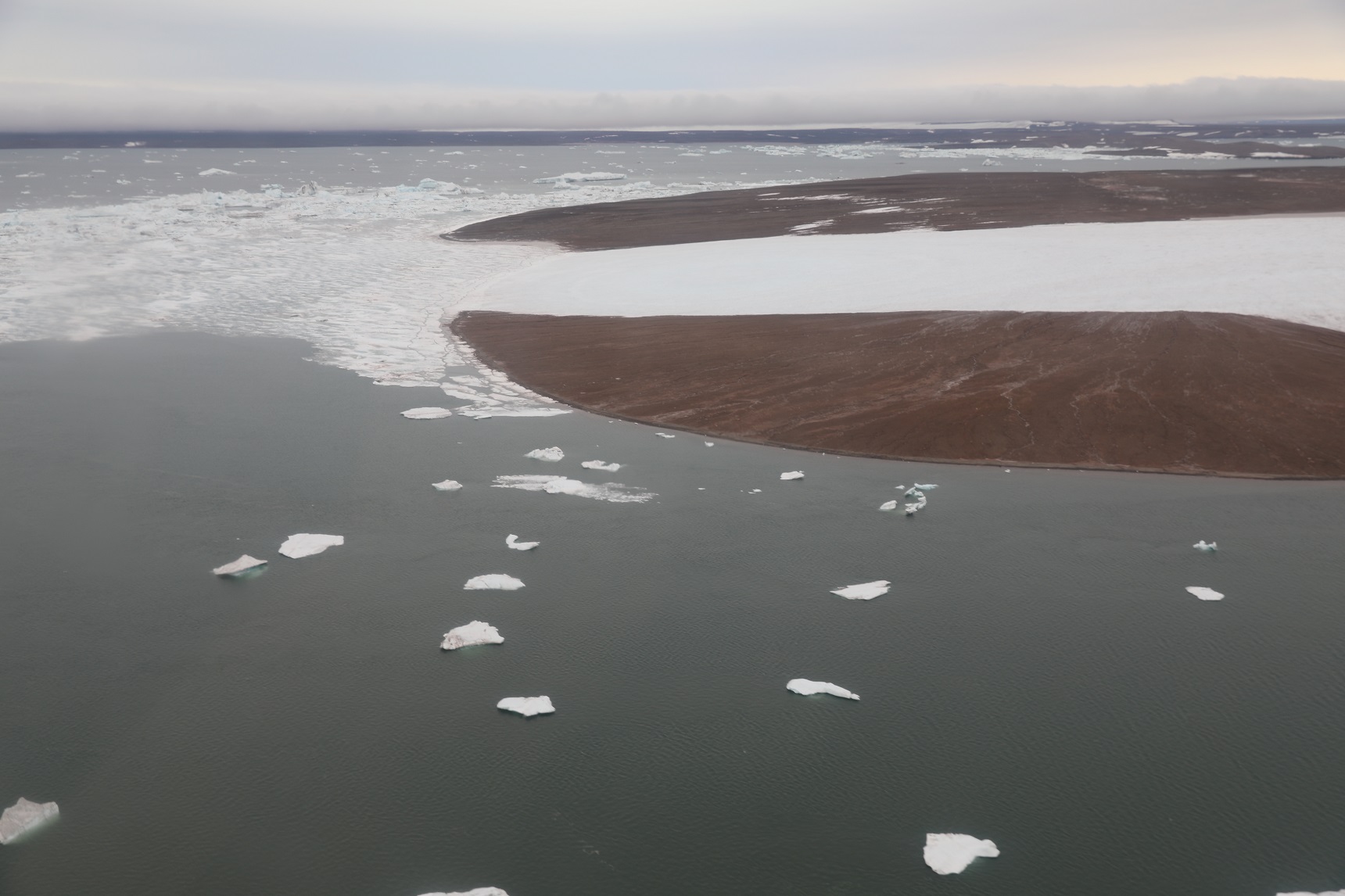
Melting ice on the islands of Severnaya Zemlya (Barents and Laptev Sea region). Image: Gabriela Schaepman-Strub, Arctic Century Expedition, 2021
Globally connected weather events
The scientists combined earth system modelling, satellite data and local observations for the study. They also analysed an index of sea surface temperatures from the Barents-Kara Sea and found that in years with higher than average Arctic temperatures, changes in atmospheric circulation resulted in an anomalous climate throughout East Asia.
In particularly cold years, the unfavourable conditions adversely affected vegetation growth and crop yields, and delayed blossoming. Moreover, the researchers estimated a decrease in carbon uptake capacity in the region of 65 megatons of carbon during winter and spring (by way of comparison, fossil fuel emissions in Switzerland are 8.8 megatons of carbon per year).
The reduction in carbon absorption capacity caused by climate change is thus another issue that must be taken into account when discussing carbon neutrality.
Climate change causes ecological and socioeconomic damage
The warming of the Arctic caused by human greenhouse gas emissions is causing social and economic harm to humans as far south as the subtropics.
Gabriela Schaepman-Strub, co-author of the study, says: "This study highlights how complex the effects of climate change are. While we observe strong warming in the Arctic system, especially over the Barents-Kara Sea, we have now discovered that this warming affects ecosystems thousands of kilometres away and over multiple weeks through climate teleconnections. Arctic warming is not only threatening the polar bear, but will affect us in many other ways."
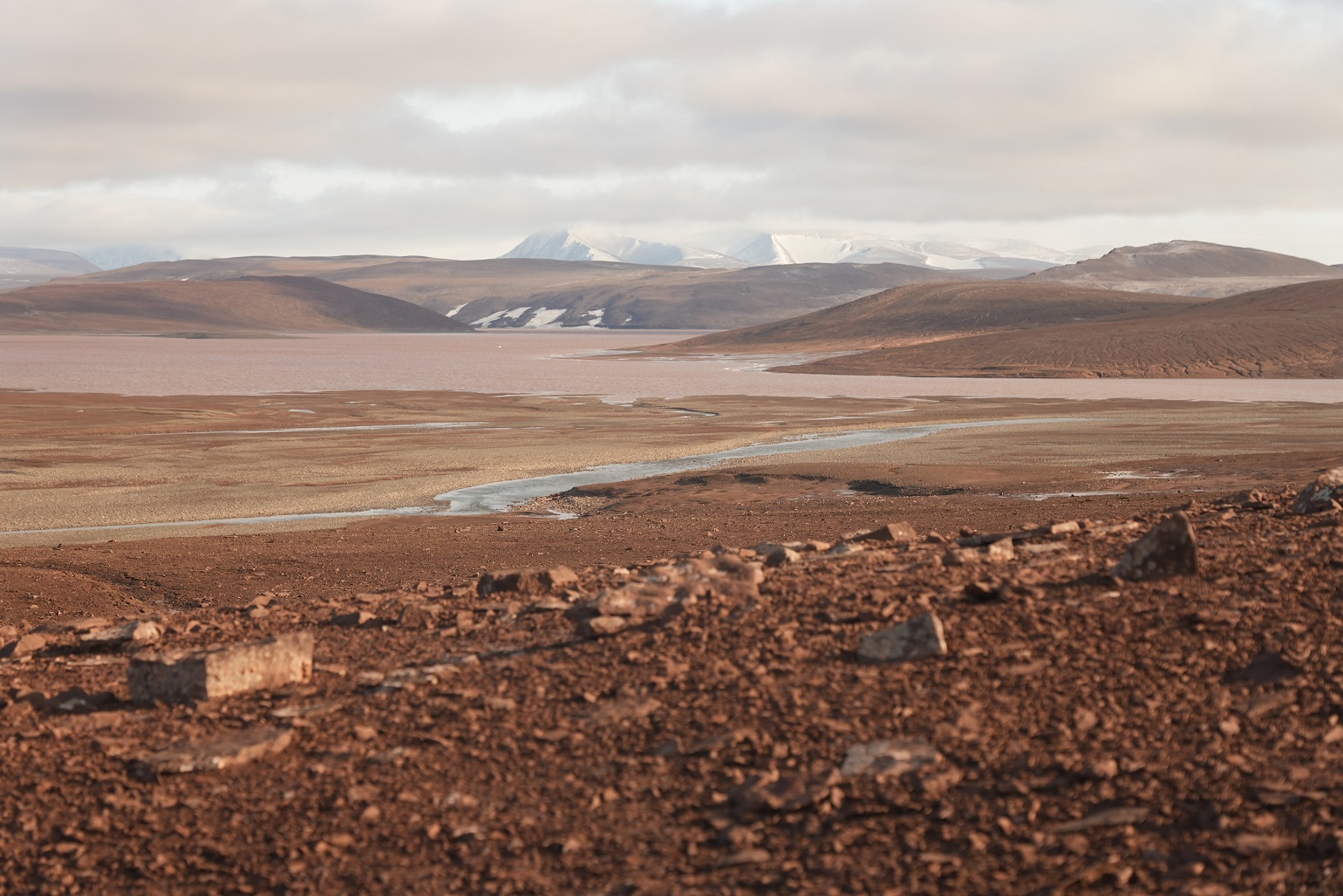
The rapidly melting ice caps on the islands of Severnaya Zemlya leave behind landscapes like those on Mars. Image: Jón Björgvinsson © 2021 Swiss Polar Institute (CC BY 4.0), Arctic Century Expedition, 2021
Jin-Soo Kim, Jong-Seong Kug, Sujong Jeong, Jin-Ho Yoon, Ning Zeng, Jinkyu Hong, Jee-Hoon Jeong, Yuan Zhao, Xiaoqiu Chen, Mathew Williams, Kazuhito Ichii, Gabriela Schaepman-Strub. Arctic warming-induced cold damage to East Asian terrestrial ecosystems. Communications Earth & Environment, 2022; 3 (1) DOI: 10.1038/s43247-022-00343-7
Golfing Cockatoos Ability To Use Combined Tools
February 8, 2022
Cockatoos have shown an extraordinary ability to complete a task by combining simple tools, demonstrating that this cognitive ability is not found only in primates. According to researchers at the University of Veterinary Medicine, in Vienna, the University of Birmingham, and the University of Vienna, the findings could shed new light on how our ancestors evolved the ability to design and use tools.
The research, published in Scientific Reports, is also part of a wider international and interdisciplinary project comparing children's innovation and problem solving skills with those of cockatoos.
Tool use is rare in animals, and particularly compound tools where two elements are fixed together, such as a spear, or an axe, or composite tools, where two items -- for example a stick and a rock -- are used together. These types of tools have evolved into recreational activities, such as hockey, cricket or golf, and it was this that inspired the study design.
In their experiment, the team devised a game of golf for one species of bird, the Goffin's cockatoo, which is known for its problem solving skills and its ability to use single tools such as sticks to open up nut and seed shells.

Credit: Goffin Lab
The birds had to manipulate a ball through a hole into a closed box, and then use a stick to push the ball to one side of the box where it triggers a trapdoor mechanism. This in turn releases a cashew nut for the bird.
Three of the cockatoos figured out how to use the stick to manoeuvre the ball into the right position to release the treat -- showing a high level of tool innovation.
Lead researcher Dr Antonio Osuna-Mascaró, from the University of Veterinary Medicine, in Vienna, said:
"One of the most amazing aspect of the process was to observe how these animals each invented their own individual technique in how to grip the stick and hit the ball, sometimes with astonishing dexterity. One of the birds operated the stick while holding it between the mandibles, one between the beak tip and tongue and one with his claw, similar to a primate."
Sarah Beck, Professor of Cognitive Development in the School of Psychology at the University of Birmingham, is a co-author and collaborator on this work, focusing on the associations between children and birds in learning how to use tools.
Prof. Beack said:
"Although children are very good at using tools and technology in their lives (think spoons and ipads!), our research has shown that young children often find it hard to invent novel solutions to problems involving tool use. In fact, children under 8 can really struggle to solve problems that cockatoos can master.
"So while this study is the first to show that cockatoos can coordinate tools to solve a problem, it also feeds into our ongoing work with children. Tempting as it might be -- it's not simply a question of who is the cleverest: children or cockatoos -- instead comparing such different species helps us understand how humans and some other species develop impressive technological skills."
Professor Alice Auersperg, another author and head of the Goffin Lab at the Messerli Research Institute in Vienna's University of Veterinary Medicine, comments:
"I believe that studying which spatial relationships animals are attending to and how they are using them for enabling tool innovations will be key to getting us better insight into the evolution of technology. Enhancing our understanding of the onset of complex tool use in particular is thus currently a focus of our research team"
Antonio J. Osuna-Mascaró, Roger Mundry, Sabine Tebbich, Sarah R. Beck, Alice M. I. Auersperg. Innovative composite tool use by Goffin’s cockatoos (Cacatua goffiniana). Scientific Reports, 2022; 12 (1) DOI: 10.1038/s41598-022-05529-9
7 reasons Australia is the lucky country when it comes to snakes
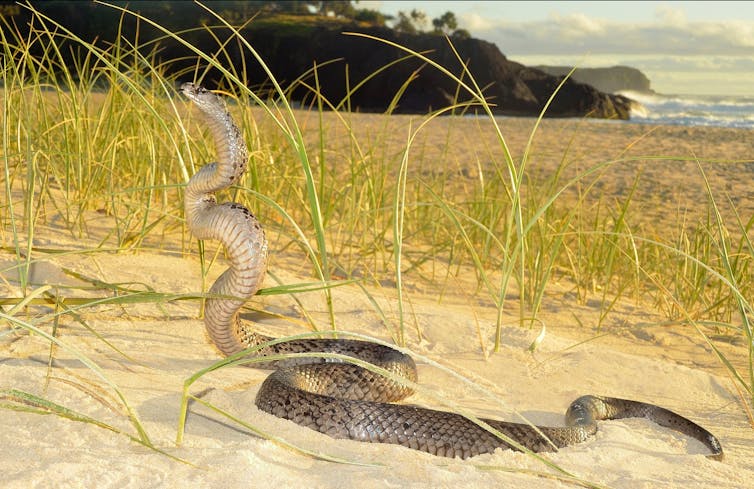
Australia has a global reputation as a land full of danger, where seemingly everything is out to kill you. Crocodiles lurk in estuaries, large spiders hide in bathrooms, and we share our suburbs with some of the world’s most venomous snakes.
Snakes hold a particular fear and fascination for many people. The bite of an eastern brown snake can kill an adult in under an hour. And that’s just one of more than 150 venomous snakes inhabiting the island continent across land and sea. Australian snakes are well and truly overrepresented out of the world’s top 25 most venomous snakes.
Terrifying, right? Not quite. Australians are actually extremely lucky when it comes to snakes. Here are seven reasons why.
1) Our Snakes Bolt Away From Us
The best way to survive a snakebite is of course not to be bitten. Keeping your distance is the easiest way to avoid a bite.
But what if you’re walking through the bush and don’t see the snake? Luckily, most Australian snakes will rapidly slither away from us.
It could be much worse. Imagine if most of our snakes were like vipers or rattlesnakes, which hold their ground and can be easily trodden on. And imagine if our venomous snakes could sense our body heat, as pit vipers and rattlesnakes do with their heat-sensing pits. For Australians, simply staying still can keep you safe.
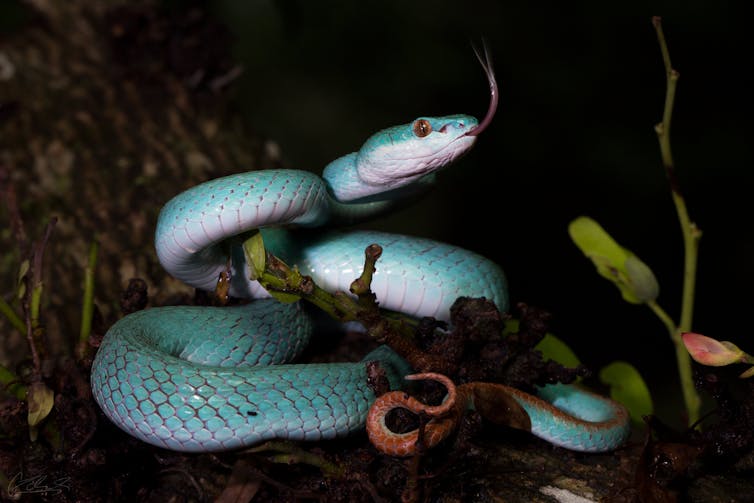
2) We Have Very Few Snakebite Deaths
Compared to other countries with many snake species, Australia has orders of magnitude fewer snakebites and related deaths. South Africa has 476 snakebite deaths on average every year. By contrast, Australia has two or three.
3) If You Do Get Bitten, You’re Very Unlikely To Lose A Limb
Most snakebites in Australia are completely painless. This is in part due to the short fangs of our brown snakes (Pseudonaja spp.), who are responsible for most bites in Australia, but mainly because most Australian snakes have venom which works internally, rather than locally at the bite site. This means snakebites in Australia very rarely result in amputations.
By contrast, across sub-Saharan Africa it is sadly common, with almost 2400 amputations reported in Africa’s most populous country, Nigeria, every year. Unfortunately, the people most at risk of snakebite are the ones least able to afford the high treatment costs.
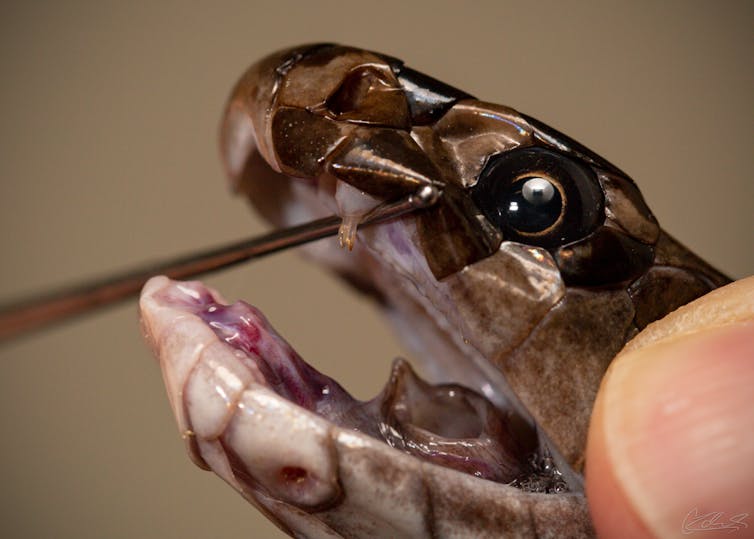
4) We Have Great Access To Excellent Antivenom And Other Treatments
For snakebites, antivenom is the only specific treatment. If you’re unlucky enough to be bitten by a highly venomous snake, getting the antivenom as quickly as possible is vital. Luckily, antivenoms work quickly, and ours are high quality.
Antivenom is often produced from purified horse antibodies. It’s well known antivenom can cause anaphylaxis, which occurs around 10% of the time in Australia. These reactions can be quickly reversed by adrenaline administered in a hospital.
By contrast, some other countries have alarmingly ineffective antivenoms as well as triggering anaphylaxis 57% of the time.
You can get antivenom at 750 hospitals across Australia. For more remote regions, snakebite victims benefit from proven pressure-immobilisation which should be applied before the Royal Flying Doctors come to the rescue.

5) We Have The World’s Only Snake Venom Detection Kits
Using the wrong antivenom can lead to the treatment failing. So how do doctors know which antivenom to administer? It’s not via snake identification by the victim because, more often than not, Australians get it wrong.
In 1979, Australia became the first country in the world to have a commercial snake venom detection kit to make antivenom choice more accurate. Even now, we’re the only ones with this option.
Every other country has to rely on more dangerous options. Either the victim brings the snake to hospital for a professional ID, or doctors have to rely on the patient’s symptoms and location where they were bitten to take an educated guess as to which antivenom will work.
As you’d expect, this can be a challenge. Why? Because there can be a great deal of overlap of symptoms caused by venom from unrelated species. Plus, picking the species responsible can take years of experience treating snakebite which many doctors do not have.
In Australia, there’s another option if the kit is unavailable: polyvalent antivenom, effective against all our most dangerous snakes.
6) Snakebites Are Covered By Medicare
Antivenom can be prohibitively expensive, costing thousands of dollars per dose.
Our nearest neighbour, Papua New Guinea, is a snakebite hotspot. But many people simply do not have the money to pay for the antivenom. In some areas, taipans kill more people than malaria due to the cost of treatment.
In Australia, treatment for a bite may cost around AUD$6,000, but this cost is covered by Medicare. In my lab, we’re working to make snakebite treatment more affordable by testing next-generation snakebite treatments.
7) Snake Venom Is Actually Saving Lives
To top it all off, snake venom is saving lives. There are six therapeutic drugs on the global market derived from snake venoms, with another two in clinical trials.
Our many venomous snake species hold in their venom glands a mini drug library, a cornucopia for scientists to trawl through looking for promising new therapeutic drugs. In fact, a toxin from the venom of eastern brown snakes (P. textilis) is being tested as a drug used to reverse life-threatening bleeding complications.
Rather than fearing our venomous snakes, let’s try seeing them as they are.
They pose little risk to us. They flee from us. Their bites can usually be cured quickly. Their venom holds therapeutic promise. And they play a vital role in keeping down the numbers of introduced rats and mice.
So let’s take a moment to appreciate Australia’s wealth of beautiful snakes.![]()
Christina N. Zdenek, Lab Manager/Post-doc at the Venom Evolution Lab, The University of Queensland
This article is republished from The Conversation under a Creative Commons license. Read the original article.
How Australia can boost the production of grains, while lowering its carbon footprint

The need to feed a rising global population means agriculture is one of the most difficult sectors to decarbonise. This is especially true for growing grains – think wheat, barley, legumes and canola.
Australia is the third largest exporter of wheat after Russia and the US, with 11% of the world’s wheat trade shipped from our shores in 2017. Likewise, Australia is responsible for up to 20% of the world’s barley exports.
But our new report, published today, has found a way to potentially increase grain production by up to 40%, while reducing the carbon footprint per tonne of grain by up to 15%. The key is improving our use of fertiliser.
To produce the world’s grains with as few greenhouse gas emissions as possible, all countries, including Australia, need to play their part. The carbon footprint (greenhouse gas intensity) of Australian grain is lower than elsewhere, so on a global scale we have some room to increase production to help meet the demands of a growing population, ensuring Australian grains remain competitive in the global market.
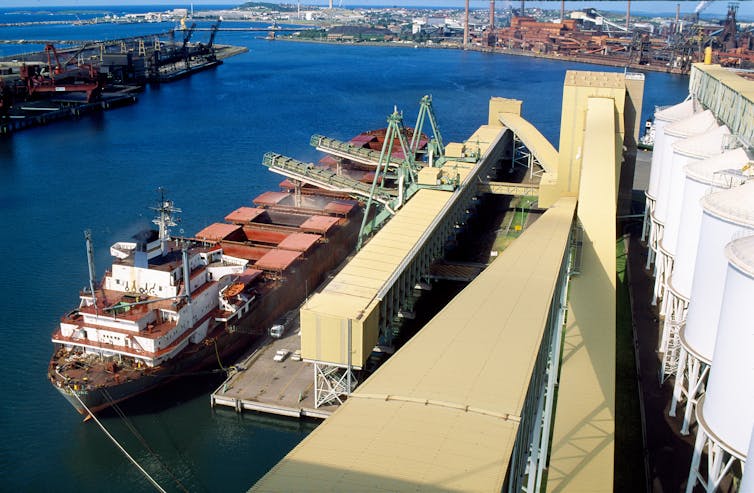
Emissions From The Grain Sector
Our initial task was to estimate the greenhouse gas emissions the grains sector released in 2005. This is because 2005 is the standard baseline year we compare Australia’s emissions to today, in line with our obligations under the Paris Agreement.
We found the sector released 13.75 million tonnes of carbon dioxide equivalent in 2005. Grain emissions in 2005 were primarily under two categories: on-farm emissions (61%) and “embedded” emissions (39%). This breakdown is likely to be very similar for today’s grain sector emissions, but this needs to be confirmed with further data collection.
On-farm emissions are dominated by applying fertiliser, and the breakdown of plant residue, such as stalks, roots and grain that falls to the ground during harvest. On-farm emissions alone are responsible for 1.7% of Australia’s total.
Embedded emissions are associated with the supply chain of a product, such as the manufacturing of fertiliser and chemicals. We found the production of fertiliser was the largest contributor to embedded emissions.
It’s clear how we use and produce fertiliser is greenhouse gas intensive. However, fertilisers – along with the the breakdown of plant residue – are key in improving productivity on farms.
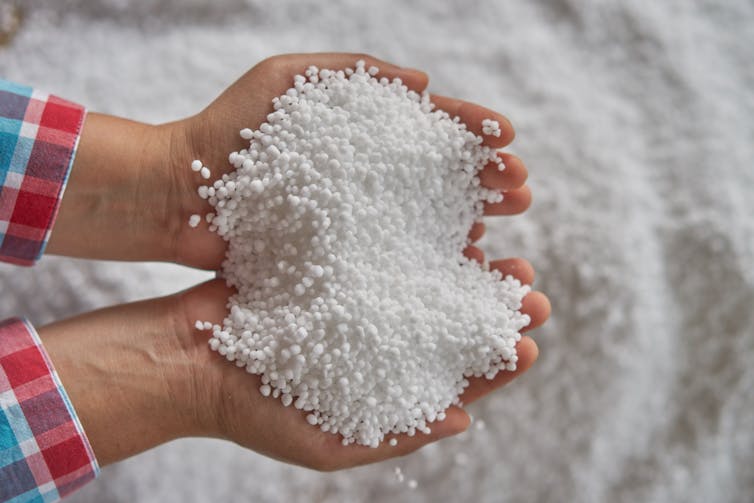
Grappling With Fertiliser
Nitrogen from fertilisers and carbon from plant residues link two important greenhouse gases: nitrous oxide and carbon dioxide.
The relationship between nitrogen in fertiliser and carbon in plants is tightly interwoven – changing levels of nitrogen inputs will change the levels of carbon in the system, and vice versa.
To unpack this complex system, we ran simulations for different farm management practices. Our findings were surprising.
Counter-intuitively, we found increasing fertiliser (in a way that minimises nitrogen losses) sees almost constant net on-farm emissions, while considerably increasing the production of grains. This translates to a lower greenhouse gas intensity (carbon footprint). Let’s explore why.
Plants need nitrogen to grow. If not enough fertiliser is applied, the plants will take it from the soil. And when the soil loses nitrogen, carbon dioxide is also released into the atmosphere to balance the soil’s nitrogen and carbon levels.
Applying fertiliser in way that results in more efficient use of nitrogen will lead to greater plant growth and avoid depleting the soil. This will, in turn, see more plant residue go into the soil, again increasing the soil’s carbon levels.
But there’s a catch. Because those extra fertilisers must be manufactured, embedded emissions increase. Nevertheless, we found the increase in total emissions to be smaller than the increase in total production. Therefore, the greenhouse gas intensity associated with the production of a tonne of grain decreases.

Where To From Here?
These findings are a small but important part of the global effort to reduce emissions from the agriculture sector and maintain Australian industry competitiveness.
The next step is to conduct further research and develop technology to put our findings into practice, as well as develop more targeted incentives for customers, investors and other stakeholders.
With the increase in emissions taking place in the manufacture of fertiliser, rather than on the farm itself, it’s important the industry helps drive those embedded emissions down.
Some initiatives are already happening, especially the development of green hydrogen. Hydrogen is a key ingredient in the manufacture of fertiliser, so using green hydrogen can reduce fertiliser embedded emissions. ![]()
Maartje Sevenster, Research Scientist Climate Smart Agriculture, CSIRO; Aaron Simmons, Adjunct Senior Research Fellow, University of New England, and Lindsay Bell, Research scientist, CSIRO
This article is republished from The Conversation under a Creative Commons license. Read the original article.
National parks are not enough - we need landholders to protect threatened species on their property
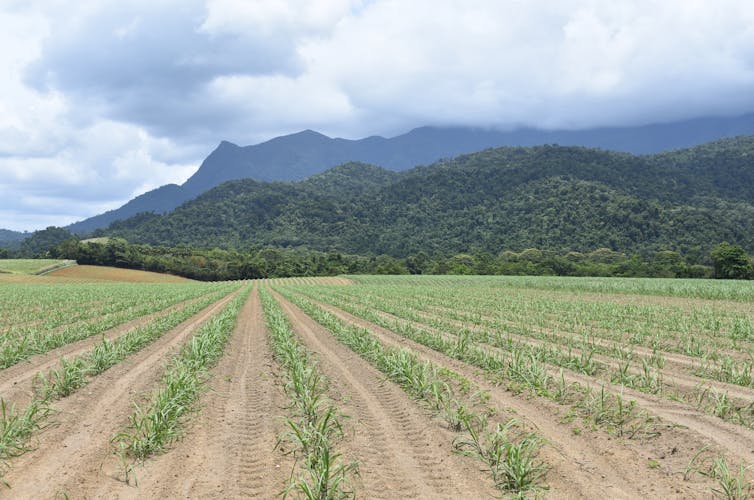
Over the last decade, the area protected for nature in Australia has shot up by almost half. Our national reserve system now covers 20% of the country.
That’s a positive step for the thousands of species teetering on the edge of extinction. But it’s only a step.
What we desperately need to help these species fully recover is to protect them across their range. And that means we have to get better at protecting them on private land.
Our recent research shows this clearly. We found almost half (48%) of all of our threatened species’ distributions occur on private freehold land, even though only 29% of Australia is owned in this way.
By contrast, leasehold land – largely inland cattle grazing properties – covers a whopping 38% of the continent but overlaps with only 6% of threatened species’ distributions. And in our protected reserves? An average of 35% of species’ distribution.
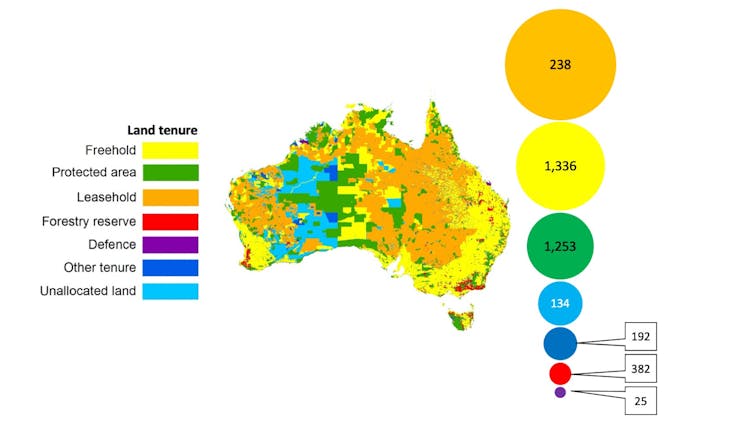
Why Do We Need More? Aren’t Our Protected Areas Enough?
When most of us think of saving species, we think of national parks and other safe refuges.
This is the best known strategy, and efforts to expand our network are laudable. New additions include the Narriearra Caryapundy Swamp National Park in northwest New South Wales, Dryandra Woodland National Park in Western Australia, and several Indigenous Protected Areas around Australia, which will ensure greater protection for some species.
But relying on reserves is simply not enough. From the air, Australia is a patchwork quilt of farms, suburbs and fragmented forests. For many species, it has become difficult to find food sources and mates.
Since European colonisation began, we have lost at least 100 species, including three species since 2009.
Almost 2,000 plant and animal species are threatened with extinction, with dozens of reptile, frog, butterfly, fish and bird and mammal species set to be lost forever without a step change in resourcing and conservation effort.
What We Do On Our Properties Matters To Nature
Freehold land is home to almost half our threatened species. Species like the pygmy blue-tongue lizard (Tiliqua adelaidensis) and giant Gippsland earthworm (Megascolides australis) occur almost entirely on privately owned lands.
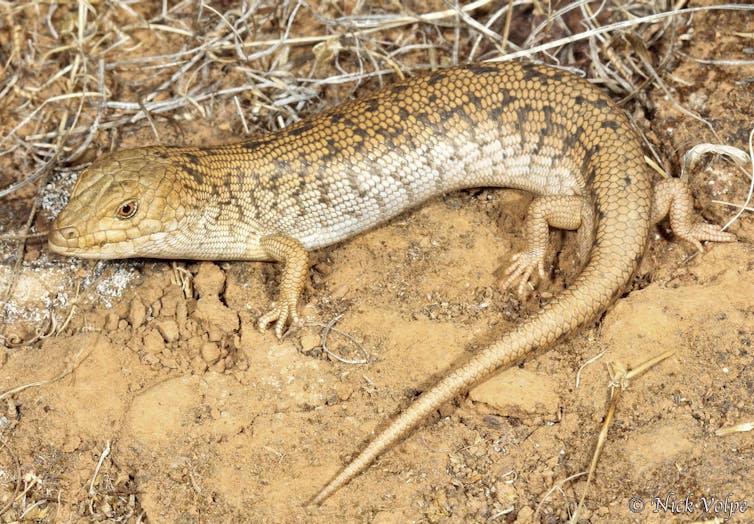

By contrast, leasehold land overlaps with only 6% of species’ distributions. Though that might sound low, species like the highly photogenic Carpentarian rock-rat (Zyzomys palatalis) rely entirely on leased land.
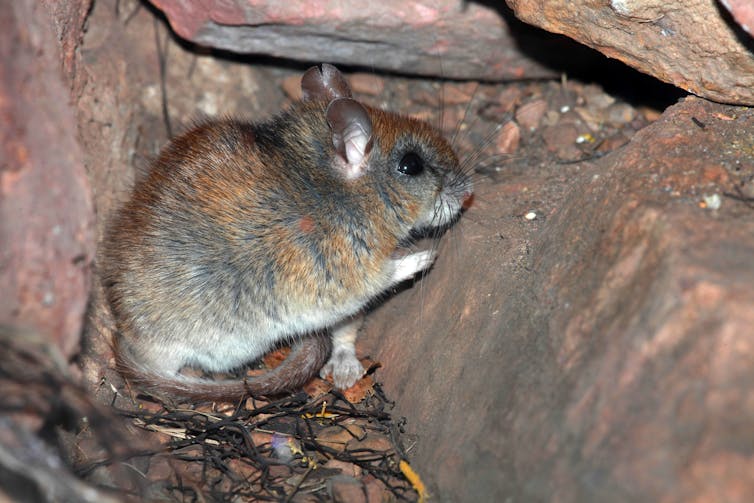
What about the 1.4% of Australia set aside for logging in state forests? These, too, provide the main habitat for threatened species such as Simson’s stag beetle (Hoplogonus simsoni), which has over two-thirds of its distribution in state forests in Tasmania’s northwest. Similarly, the Colquhoun Grevillea (Grevillea celata) is known only from a state forest in Victoria’s Gippsland region.
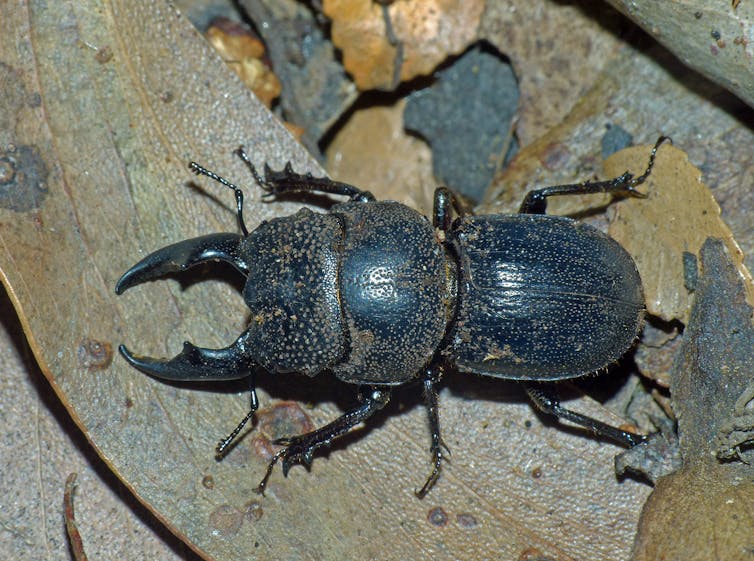
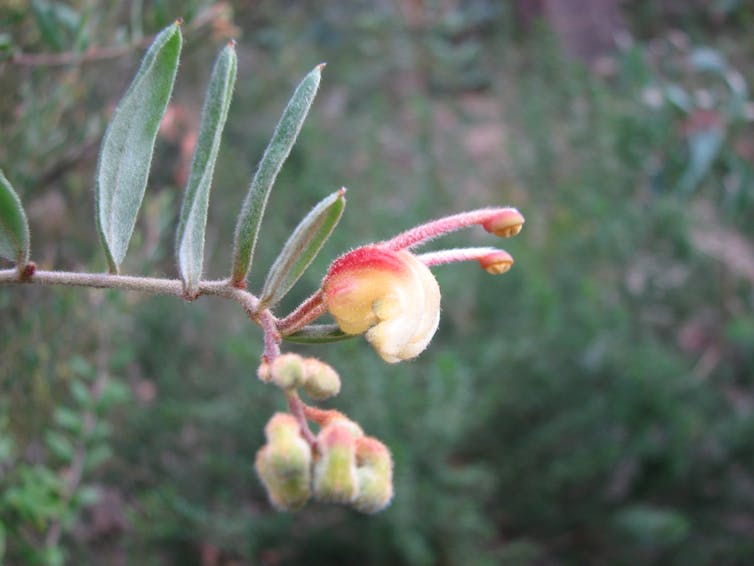
Even defence lands – covering less than 1% of Australia – are the only home some species have. Take the Cape Range remipede (Kumonga exleyi), known only from an air force bombing range near Exmouth, Western Australia, or the Byfield Matchstick shrub (Comesperma oblongatum), which survives in Queensland’s highly biodiverse Shoalwater Bay Military Training Area.
The Indigenous estate across Australia intersects with almost all of these tenure types, and also has critical importance for half of Australian threatened species distributions as shown by previous research.
We Need All Hands On Deck To Keep Our Threatened Species Persisting
It is late in the day to save Australia’s threatened species, as climate change multiplies the challenges they face. If we are to have any real chance at turning the tide, we must do much more.
To staunch the heartbreaking flow of species into extinction means we have to actively manage multiple threats to their existence across many different types of land tenure.
Logging of native forest and some methods of intensive farming continue to endanger many threatened species, particularly those which rely on these land types for their survival.
Over 380 threatened species have part of their range in land set aside for logging. It should be no surprise that logging is a key threat for 64 of these endangered species.
How Can We Achieve Better Conservation Outside Protected Areas?
Many landholders are acutely aware of the species they share the land with, and are already taking action to protect them. One key method is the use of land partnerships, in which landowners and custodians work with conservationists.
Take Sue and Tom Shephard, who run a large cattle property on Cape York. Their station is home to some of the last remaining golden-shouldered parrots (Psephotus chrysopterygius). The Shephards are working to bring the species back from the brink through careful management of grazing, fire and feral animals.
Similarly, the work of hundreds of rice growers is helping save the endangered Australian bittern (Botaurus poiciloptilus). Every year, up to a third of the remaining population descends on New South Wales rice fields to breed. Rice farmers are accommodating these birds by ensuring there is early permanent water, reducing predator numbers and boosting their habitat.
We’re seeing successes even on defence force land. The Yampi Sound Training Area in the Kimberley is a biodiversity hotspot. A partnership between the Department of Defence and the Australian Wildlife Conservancy is helping protect these species alongside defence force use. This model could be rolled out across other areas of defence land.
What’s Stopping More People Taking Action?
While many landowners may want to help, financial constraints, a lack of knowledge or concerns over implications for resale of the land can be barriers.
If we want to encourage more landowners to directly conserve species on their land, we must begin by understanding what they want. Only then can we design initiatives to help these species, as well as benefit and engage landowners.
What does this look like? Picture financial incentives to join conservation programs. Or workshops where landowners can see the very real benefit to their own land by reducing erosion, keeping rabbit numbers under control, protecting waterways from silt or water-sucking introduced trees, or reducing wind and dust through setting aside land for trees.
If a farmer or landowner can clearly see the benefit for wildlife and for their own use, they are much more likely to take part.
Incentives don’t have to be financially based, either. If landowners understand what works and feel capable of action after training, and have technical support and assistance to draw on, they’re more likely to start down the path of making their land more friendly to threatened species.
If we really want to protect our species, we must do more to bring in Australia’s farmers, landowners and other custodians of land. We cannot rely on protected areas alone. We need to make the land safer for our species most at risk, wherever they occur.
CSIRO’s Josie Carwardine and Anthea Coggan contributed to this research![]()
Stephen Kearney, PhD student, The University of Queensland; April Reside, Lecturer, The University of Queensland; James Watson, Professor, The University of Queensland; Rebecca Louise Nelson, Associate Professor in Law, The University of Melbourne; Rebecca Spindler, Adjunct Professor, UNSW Sydney, and Vanessa Adams, Senior Lecturer, Discipline of Geography and Spatial Sciences, University of Tasmania
This article is republished from The Conversation under a Creative Commons license. Read the original article.
Exploring Antarctica’s hidden under-ice rivers and their role in future sea-level rise
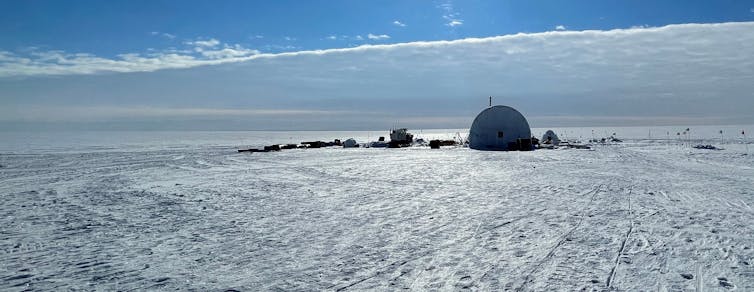
Underneath Antarctica’s vast ice sheets there’s a network of rivers and lakes. This is possible because of the insulating blanket of ice above, the flow of heat from within the Earth, and the small amount of heat generated as the ice deforms.
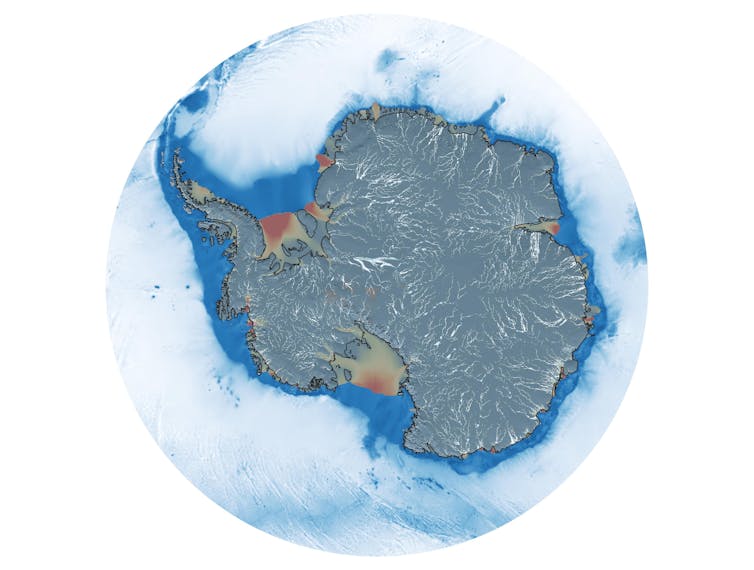
Water lubricates the base of the ice sheets, allowing the ice to slide towards the ocean at speeds of many hundreds of metres per year. When the water emerges from beneath the ice, it enters a cold and salty cavity underneath ice shelves, the floating extensions of ice sheets that fringe the continent.
Here the water mixes, releases nutrients and sediment, and melts the underside of the ice shelves, which act as buttresses and hold back the flow of the ice sheets.
How these processes play out over the next centuries is a major factor in understanding sea-level rise. Unfortunately, this is also one of the least-explored parts of our planet.
Our Aotearoa New Zealand Antarctic Science Platform project is the first direct survey of an Antarctic under-ice river, and it supports earlier research suggesting these sub-glacial rivers form estuaries as they flow into the ocean, albeit at 82.5 degrees south, hidden under 500m of ice and about 500km from the open ocean.
Exploring An Under-Ice River
Our team has just returned from Kamb Ice Stream on the West Antarctic Ice Sheet (WAIS). Kamb is a sleeping giant.
This massive river of ice lies on the other side of the WAIS from Thwaites Glacier, Antarctica’s “doomsday” glacier which has been losing ice rapidly. Kamb used to flow fast, but this ceased about 160 years ago because of changes in how water was distributed at the base of the ice.
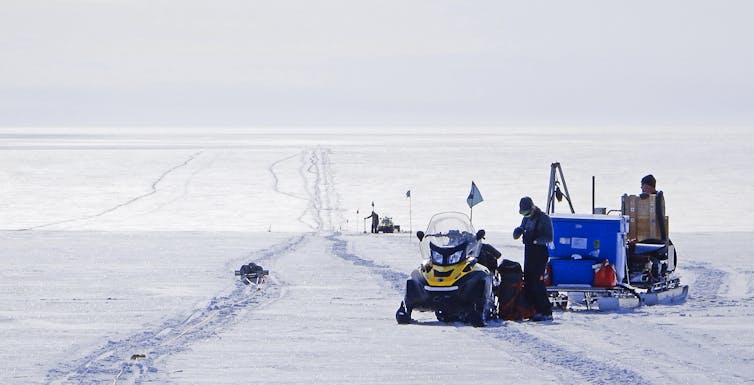
While the Kamb region isn’t vulnerable to ocean warming at the present time, it currently offsets much of the ice loss happening elsewhere in Antarctica. Changes at Kamb will herald major changes for Antarctica’s ice sheets and oceans.
One challenge is that ice sheets respond to external changes, such as rising ocean temperatures, but also to difficult-to-predict internal changes, such as flood events that occur when sub-ice rivers and lakes “burst their banks”.
Getting There
The COVID pandemic has been hard on national Antarctic programmes and the field science they support. Global supply and freight delays kept our team on the edge in the lead-up to our season.
This summer, New Zealand started the rebuild of its main Antarctic station, Scott Base, and has been developing an over-snow traverse to deploy large teams across great distances. Our Kamb team was one of the first to benefit from this new capability, with a camp operating for months, more than 900km from New Zealand’s permanent station.
There’s an art to drilling through Antarctic ice. In reality, we melt our way through with recycled hot water.
Once on site, the team was able to drill through 500m of the ice shelf and keep a 0.4m-diameter hole open for nearly two weeks. This allowed us to take samples and gather observations for a diverse range of science projects.
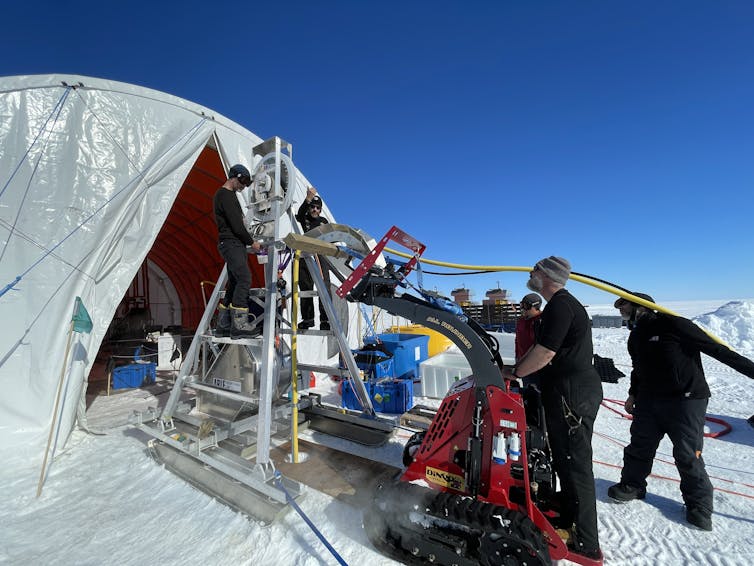
A Hidden River
Almost a decade of research paid off when the team pinpointed the exact spot to drill to hit the onset of the narrow river beneath. This was even more impressive than initially thought, with borehole surveys revealing a river more than 240m high but less than 200m wide – a much narrower target than indicated by the surface icescape.
Working from a borehole means we can only look in one spot. As an antidote to this limitation, colleagues from Cornell University deployed their ocean robot Icefin to study the space below the ice.
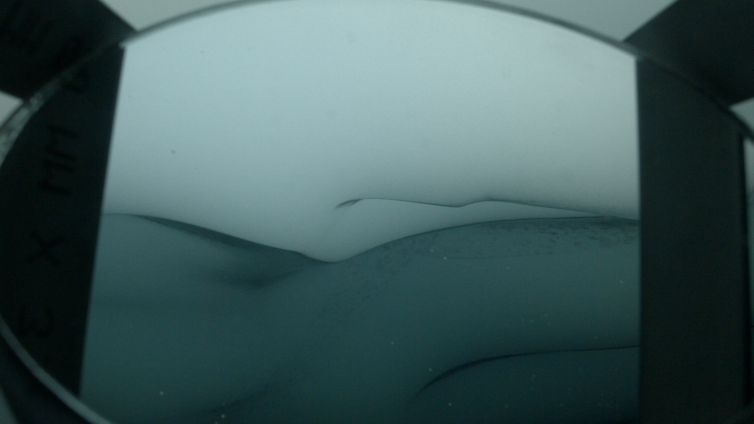
One of the discoveries that will keep the team going for some time is a dense community of likely amphipods, which we spotted when we lowered cameras to the seafloor. The swarm was so dense, we first thought there was something wrong with our equipment.
The last task the team completed was to deploy an ocean mooring beneath the ice. These instruments will continue to report back on ocean conditions over the coming years.
Only five days after deployment, we detected the tsunami from the Hunga Tonga-Hunga Ha'apai volcanic eruption.
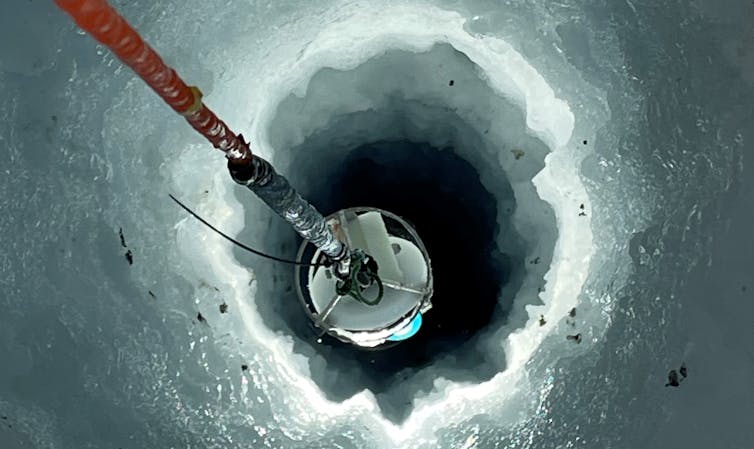
Apart from baseline observations, such discoveries provide strong motivation for deploying long-term monitoring equipment. The team will be watching closely over the coming years for any changes in the under-ice river flow, including flood events.![]()
Huw Joseph Horgan, Associate Professor of Geophysical Glaciology, Te Herenga Waka — Victoria University of Wellington and Craig Stevens, Professor in Ocean Physics, National Institute of Water and Atmospheric Research
This article is republished from The Conversation under a Creative Commons license. Read the original article.
Avalon Golf Course Bushcare Needs You


Pittwater Reserves + Others
A History Of The Campaign For Preservation Of The Warriewood Escarpment by David Palmer OAM and Angus Gordon OAM
Angophora Reserve - Angophora Reserve Flowers
Annie Wyatt Reserve - A Pictorial
Avalon's Village Green: Avalon Park Becomes Dunbar Park - Some History + Toongari Reserve and Catalpa Reserve
Bairne Walking Track Ku-Ring-Gai Chase NP by Kevin Murray
Bangalley Headland Bangalley Mid Winter
Banksias of Pittwater
Barrenjoey Headland: Spring flowers Barrenjoey Headland after fire
Bayview Baths
Bayview Wetlands
Beeby Park
Bilgola Beach
Botham's Beach
Bungan Beach Bush Care
Careel Bay Saltmarsh plants
Careel Bay Birds
Careel Bay Clean Up day
Careel Bay Playing Fields History and Current
Careel Creek
Careel Creek - If you rebuild it they will come
Centre trail in Ku-ring-gai Chase National Park
Chiltern Track- Ingleside by Marita Macrae
Clareville Beach
Clareville/Long Beach Reserve + some History
Coastal Stability Series: Cabbage Tree Bay To Barrenjoey To Observation Point by John Illingsworth, Pittwater Pathways, and Dr. Peter Mitchell OAM
Cowan Track by Kevin Murray
Curl Curl To Freshwater Walk: October 2021 by Kevin Murray and Joe Mills
Currawong and Palm Beach Views - Winter 2018
Currawong-Mackerel-The Basin A Stroll In Early November 2021 - photos by Selena Griffith
Currawong State Park Currawong Beach + Currawong Creek
Deep Creek To Warriewood Walk photos by Joe Mills
Drone Gives A New View On Coastal Stability; Bungan: Bungan Headland To Newport Beach + Bilgola: North Newport Beach To Avalon + Bangalley: Avalon Headland To Palm Beach
Dunbar Park - Some History + Toongari Reserve and Catalpa Reserve
Dundundra Falls Reserve: August 2020 photos by Selena Griffith - Listed in 1935
Elsie Track, Scotland Island
Elvina Track in Late Winter 2019 by Penny Gleen
Elvina Bay Walking Track: Spring 2020 photos by Joe Mills
Elvina Bay-Lovett Bay Loop Spring 2020 by Kevin Murray and Joe Mills
Fern Creek - Ingleside Escarpment To Warriewood Walk + Some History photos by Joe Mills
Ingleside
Ingleside Wildflowers August 2013
Irrawong - Ingleside Escarpment Trail Walk Spring 2020 photos by Joe Mills
Irrawong - Mullet Creek Restoration
Katandra Bushland Sanctuary - Ingleside
McCarrs Creek
McCarr's Creek to Church Point to Bayview Waterfront Path
McKay Reserve
Mona Vale Beach - A Stroll Along, Spring 2021 by Kevin Murray
Mona Vale Headland, Basin and Beach Restoration
Mount Murray Anderson Walking Track by Kevin Murray and Joe Mills
Mullet Creek
Narrabeen Creek
Narrabeen Lagoon Catchment: Past Notes Present Photos by Margaret Woods
Narrabeen Lagoon State Park
Narrabeen Lagoon State Park Expansion
Narrabeen Rockshelf Aquatic Reserve
Nerang Track, Terrey Hills by Bea Pierce
Newport Bushlink - the Crown of the Hill Linked Reserves
Newport Community Garden - Woolcott Reserve
Newport to Bilgola Bushlink 'From The Crown To The Sea' Paths: Founded In 1956 - A Tip and Quarry Becomes Green Space For People and Wildlife
Pittwater spring: waterbirds return to Wetlands
Pittwater's Lone Rangers - 120 Years of Ku-Ring-Gai Chase and the Men of Flowers Inspired by Eccleston Du Faur
Pittwater's Parallel Estuary - The Cowan 'Creek
Riddle Reserve, Bayview
Salvation Loop Trail, Ku-Ring-Gai Chase National Park- Spring 2020 - by Selena Griffith
Stapleton Reserve
Stapleton Park Reserve In Spring 2020: An Urban Ark Of Plants Found Nowhere Else
The Chiltern Track
The Resolute Beach Loop Track At West Head In Ku-Ring-Gai Chase National Park by Kevin Murray
Towlers Bay Walking Track by Joe Mills
Trafalgar Square, Newport: A 'Commons' Park Dedicated By Private Landholders - The Green Heart Of This Community
Turimetta Beach Reserve by Joe Mills, Bea Pierce and Lesley
Turimetta Beach Reserve: Old & New Images (by Kevin Murray) + Some History
Turimetta Headland
Warriewood Wetlands and Irrawong Reserve
Whale Beach Ocean Reserve: 'The Strand' - Some History On Another Great Protected Pittwater Reserve
Winji Jimmi - Water Maze

New Shorebirds WingThing For Youngsters Available To Download
A Shorebirds WingThing educational brochure for kids (A5) helps children learn about shorebirds, their life and journey. The 2021 revised brochure version was published in February 2021 and is available now. You can download a file copy here.
If you would like a free print copy of this brochure, please send a self-addressed envelope with A$1.10 postage (or larger if you would like it unfolded) affixed to: BirdLife Australia, Shorebird WingThing Request, 2-05Shorebird WingThing/60 Leicester St, Carlton VIC 3053.

 Shorebird Identification Booklet
Shorebird Identification Booklet
The Migratory Shorebird Program has just released the third edition of its hugely popular Shorebird Identification Booklet. The team has thoroughly revised and updated this pocket-sized companion for all shorebird counters and interested birders, with lots of useful information on our most common shorebirds, key identification features, sighting distribution maps and short articles on some of BirdLife’s shorebird activities.
The booklet can be downloaded here in PDF file format: http://www.birdlife.org.au/documents/Shorebird_ID_Booklet_V3.pdf
Paper copies can be ordered as well, see http://www.birdlife.org.au/projects/shorebirds-2020/counter-resources for details.
Download BirdLife Australia's children’s education kit to help them learn more about our wading birdlife
Shorebirds are a group of wading birds that can be found feeding on swamps, tidal mudflats, estuaries, beaches and open country. For many people, shorebirds are just those brown birds feeding a long way out on the mud but they are actually a remarkably diverse collection of birds including stilts, sandpipers, snipe, curlews, godwits, plovers and oystercatchers. Each species is superbly adapted to suit its preferred habitat. The Red-necked Stint is as small as a sparrow, with relatively short legs and bill that it pecks food from the surface of the mud with, whereas the Eastern Curlew is over two feet long with a exceptionally long legs and a massively curved beak that it thrusts deep down into the mud to pull out crabs, worms and other creatures hidden below the surface.
Some shorebirds are fairly drab in plumage, especially when they are visiting Australia in their non-breeding season, but when they migrate to their Arctic nesting grounds, they develop a vibrant flush of bright colours to attract a mate. We have 37 types of shorebirds that annually migrate to Australia on some of the most lengthy and arduous journeys in the animal kingdom, but there are also 18 shorebirds that call Australia home all year round.
What all our shorebirds have in common—be they large or small, seasoned traveller or homebody, brightly coloured or in muted tones—is that each species needs adequate safe areas where they can successfully feed and breed.
The National Shorebird Monitoring Program is managed and supported by BirdLife Australia.
This project is supported by Glenelg Hopkins Catchment Management Authority and Hunter Local Land Services through funding from the Australian Government’s National Landcare Program. Funding from Helen Macpherson Smith Trust and Port Phillip Bay Fund is acknowledged.
The National Shorebird Monitoring Program is made possible with the help of over 1,600 volunteers working in coastal and inland habitats all over Australia.
The National Shorebird Monitoring program (started as the Shorebirds 2020 project initiated to re-invigorate monitoring around Australia) is raising awareness of how incredible shorebirds are, and actively engaging the community to participate in gathering information needed to conserve shorebirds.
In the short term, the destruction of tidal ecosystems will need to be stopped, and our program is designed to strengthen the case for protecting these important habitats.
In the long term, there will be a need to mitigate against the likely effects of climate change on a species that travels across the entire range of latitudes where impacts are likely.
The identification and protection of critical areas for shorebirds will need to continue in order to guard against the potential threats associated with habitats in close proximity to nearly half the human population.
Here in Australia, the place where these birds grow up and spend most of their lives, continued monitoring is necessary to inform the best management practice to maintain shorebird populations.
BirdLife Australia believe that we can help secure a brighter future for these remarkable birds by educating stakeholders, gathering information on how and why shorebird populations are changing, and working to grow the community of people who care about shorebirds.
To find out more visit: http://www.birdlife.org.au/projects/shorebirds-2020/shorebirds-2020-program
Aussie Bread Tags Collection Points

Aged Care Industry Needs A Massive Shake-Up
Eligible Aged Care Residents Receive Boosters
Aged Care Quality And Safety Commissioner Reappointed
Meritorious Service Award – Peter Robson
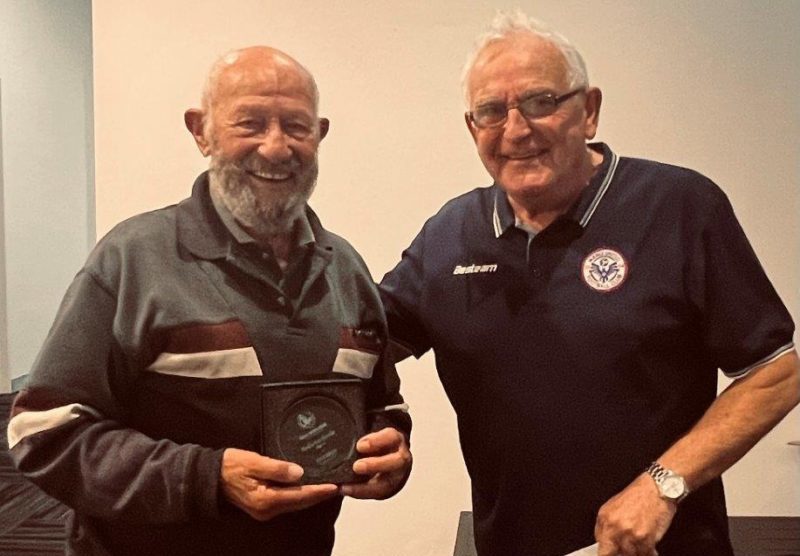
IOC Honours Tracey Holmes For Her Journalism And Leadership
 The International Olympic Committee has awarded ABC sports journalist Tracey Holmes the 2021 Women and Sports Award for Oceania.
The International Olympic Committee has awarded ABC sports journalist Tracey Holmes the 2021 Women and Sports Award for Oceania.NSW Spectacles Program
- one pair of single vision glasses, or
- one pair of bifocal glasses.
- receive a full Centrelink pension/benefit
- have no other income other than the Centrelink payments
- have financial assets less than $500 (if single) or $1000 (if married/partnered or parent/guardian)
- are a low-wage earner who earns less than:
- the JobSeeker Payment if you're under 65, or
- the aged pension if you're over 65.
Pensioner Water Rebate
- Pensioner Concession Card from Centrelink or Department of Veterans' Affairs, or
- gold Health Card (also known as a gold card) that shows:
- war widow
- war widower
- extreme disablement adjustment (EDA)
- totally and temporarily incapacitated (TTI)
- totally and permanently incapacitated (TPI).
- single dwelling
- dual occupancy
- strata or company title unit
- unit in a retirement village with a life term lease.
Concession Car Parking At NSW Health Public Hospitals
- requiring treatment over an extended period
- attending hospital more than twice a week (including carers of long term patients who visit frequently).
- ongoing cancer treatment
- treatment more than twice weekly
- daily dressing changes
- cardiac rehabilitation or health promotion classes
- Transport for NSW Mobility Parking Scheme permit
- Pensioner Concession Card
- Department of Veterans' Affairs Gold Card
- Health Care Card.
- clearly displaying and publicising concessional rates
- streamlining the concession application process with designated points of access
- validating concessional parking for the duration of a course of treatment.
The ABC’s budget hasn’t been restored – it’s still facing $1.2 billion in accumulated losses over a decade
Alexandra Wake, RMIT University and Michael Ward, University of SydneyABC Chair Ita Buttrose is “delighted” and Managing Director David Anderson says he now has “certainty” for planning. However, the Morrison government’s pre-election announcement it would restore the ABC’s budget to 2018 levels doesn’t come close to making up for what has been lost in cuts to funding and staff.
Seven weeks ahead of the budget, Communications Minister Paul Fletcher has announced the ABC will receive $3.284 billion over three years from July 2022, while SBS will receive $953.7 million over the same period.
Significantly, the government says it is scrapping its controversial indexation freeze on the ABC’s budget. This was imposed by then-Prime Minister Malcolm Turnbull in 2018 and meant the broadcaster’s funding did not keep pace with inflation. It led to drastic cuts in programming and staffing in June 2020.
Fletcher also announced the ABC funding would include $45.8 million for another three years for the broadcaster’s “enhanced news gathering” program, which is earmarked for local public interest journalism in regional communities.
However, the funding comes with strings attached.
The Morrison government has published what it calls a statement of expectations, a requirement for the ABC and SBS to provide a report each year detailing staff numbers in regional and remote Australia, as well as hours of programming tailored to those audiences.
Fletcher also said the ABC and SBS weren’t currently required to report on the number of hours of Australian drama and documentaries they show each year. Although these hours are published in the ABC annual report, the government will now require the ABC and SBS to provide further reporting on this through a national framework.
Impressive Figures But It’s Doesn’t Undo The Damage
To those who haven’t been following the ABC’s funding situation closely, the announcement may seem like impressive numbers. Certainly, the government’s line is the ABC will be “boosted” by scrapping the indexation freeze.
However, the end of the index freeze and the retention of the news gathering program still do not make up for the massive cuts already inflicted on the ABC.
As we noted in our research in 2019 and 2020, a total of $783 million was removed from ABC funding between 2014 and 2022. As the table below shows, these accumulated funding losses include a series of budget announcements, cancelled funding contracts, reduced or ended specific programs and implemented major cuts.
In fact, taking into account the government’s latest announcement, we now calculate the ABC’s accumulated lost funding from fiscal years 2014-15 to 2024-25 will reach a staggering $1.201 billion.
Tallying the ABC’s accumulated losses over a decade
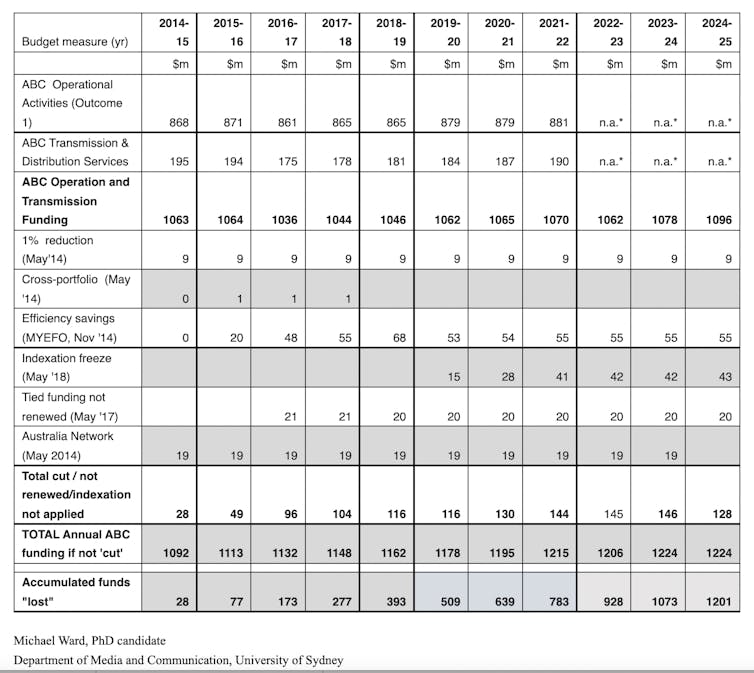
To get to this figure, we used our previous research as a baseline and factored in this week’s funding announcements. This takes account of no additional plans by the government to restore any of the earlier ABC funding cuts, and the ongoing impact of the three-year indexation pause.
While ending the freeze means future ABC funding will take some account of inflation, it does not address the impact of the freeze itself from 2019.
The ABC has said this is a problem. In answer to a Senate Estimates question in October 2021, the broadcaster said this would result in a funding shortfall of just over $40 million annually, which would continue to be felt in future years.
Our research also factors in the ABC’s loss of the ten-year Australia Network contract in 2014. This resulted in a reduction in funding of $186 million, which is represented across the balance of the contract term in the table above.
Certainly, the ABC does continue to do some international broadcasting, particularly in the Pacific, but it is no longer the dominant broadcaster in the region it once was. Restoring and even boosting the funding that was given to the Australia Network would go some way to improving Australia’s standing in the Indo-Pacific region.
We found the total lost funding continues to accumulate at well over $100 million annually through 2024-25. In other words, if the government truly wanted to restore the ABC’s funding, it would need to increase its budget by at least 10% annually.
It is difficult to be definite with the numbers because the triennial funding total announced by Fletcher lacks detail.
It is not clear, for instance, how much will be available for the broadcasters’ operations after funds are allocated for broadcast distribution and transmission contracts that go to third-party suppliers. In the ABC’s case, these contracts are worth almost $600 million over the next three-year budget cycle.
It must also be noted Fletcher rejects the assertion the ABC’s funding has been cut at all in the current three-year funding period from 2019–22.
In fairness to the minister, while the indexation freeze and other funding reductions continue to reduce the available funds to the ABC, they were not announced during the current three-year period.
The ABC Lacks Funds For Future-Proofing
This week’s announcement was warmly greeted as a significant change in the government’s position towards the public broadcasters. It is also certainly a positive response to the dire state of journalism in some areas, particularly in the suburbs and regional and remote communities, where the closure of commercial newsrooms has left many without a local journalist or any local news service.
But we’d argue more needs to be done. The ABC still gets only about half the per capita government funding other democratic countries provide to their national broadcasters.
This funding will also not future-proof the ABC or SBS with the extra resources needed to remain at the forefront of delivering digital content to Australians as they continue to change the way they access quality and trusted news and information.
The announcement may at least prevent the ABC from becoming an election issue.
The Friends of the ABC had been gearing up its campaigning across the nation, fundraising to target key marginal seats. And last week, the Guardian Australia reported the majority of Australians would support restoring funding to the ABC.
It remains to be seen if the announcement is sufficient to convince Australians who love and trust the national broadcasters that the Coalition has actually has done enough to support them.![]()
Alexandra Wake, Program Manager, Journalism, RMIT University and Michael Ward, PhD candidate, University of Sydney
This article is republished from The Conversation under a Creative Commons license. Read the original article.
From Jaws to Star Wars to Harry Potter: John Williams, 90 today, is our greatest living composer
Dan Golding, Swinburne University of TechnologyJohn Williams, the man who changed the way we hear the movies, turns 90 today.
As the key Hollywood composer during the blockbuster era of the 1970s and 1980s, Williams had an astronomical career alongside the likes of filmmakers Steven Spielberg and George Lucas.
With his music for their movies, Williams revived the romantic orchestral sound of Hollywood’s Golden Age – the sound pioneered by composers Erich Wolfgang Korngold and Max Steiner at the dawn of the talkies – and reinvented it for a new era.
“John Williams has been the single most significant contributor to my success as a filmmaker,” said Spielberg in 2012.
On the numbers alone, Williams has had a career like no other. If you were going to the movies between 1970 and 1990, every second year would have had a number one box office hit with music by Williams.
This prolific era saw Williams write music for Jaws, Star Wars, Indiana Jones, Close Encounters of the Third Kind, Superman and E.T. The Extra Terrestrial – an abundant run by any standard.
Williams today holds 52 Academy Award nominations (and five wins), the most nominations of any living human and second in history only to Walt Disney. Williams can add to that 72 Grammy Award nominations (and 25 wins), 16 BAFTA nominations (seven wins) and six Emmy nominations (three wins).
He has written music for the Olympics (in 1984, 1988, 1996 and the 2002 Winter Olympics), for a Presidential inauguration (for Barack Obama in 2009) and for the nightly news (NBC – also used by Channel Seven in Australia).
When adjusted for inflation, one-fifth of the top 100 films at the North American box office have music by Williams.
The Sound Of The Silver Screen
By re-energising the sound of the Hollywood orchestra in the 1970s, Williams linked history with the present. The films he is most associated with from this era – things like Star Wars and Indiana Jones – are deliberate throwbacks to an older form of storytelling.
Outside the multiplex in the 1970s, the public worried about Watergate, Vietnam and the threat of Cold War nuclear war. Inside cinemas however, with the music of Williams, was a moment of escape and excitement.
Then there are those melodies. By now, reading this article, it’s likely you’ve already hummed some John Williams to yourself or are suffering an earworm. Between his major hits of the blockbuster era and his later work like the Home Alone and Harry Potter franchises, Williams has written some of the most widely-recognisable melodies on earth.
This is no coincidence: despite the orchestral complexity of his music, Williams admits he often spends the most time devising his melodies and perfecting them, lifting a note here, lowering another there.
For the five note alien “hello” in Close Encounters Williams formulated hundreds of variations before settling on the one heard in the final film.
For several of his themes – The Imperial March from The Empire Strikes Back, or Superman’s theme, for example – it feels less like Williams composed them as he simply reached into our collective consciousness and redeployed what was already there.
The Art Of Homage
For much of the period of his success, Williams has been looked down upon by some in the classical establishment as writing simple popular ditties, or worse, as a rampant plagiarist of the classical canon.
It is no secret Williams’ music takes influence from the greats, like Stravinsky, Holst and Dvořák. Sometimes, the influence becomes direct allusion, as with Howard Hanson’s Romantic Symphony and the conclusion of E.T. The Extra-Terrestrial.
But these “gotcha” comparisons are superficial, dull, and miss the point.
“Any fool can see that,” Brahms is meant to have said when asked about the similarities between his second symphony and Beethoven.
Williams was writing music for films that were also deliberate throwbacks. One might as well complain about how Star Wars borrows Flash Gordon’s opening crawl, or the plot of Kurosawa’s Hidden Fortress or that scene from John Ford’s The Searchers with the burning homestead.
This is how the most popular culture of the 20th century gained its meaning: through evocation, reworking and memory.
In looking to the music of the past, Williams was not having a lend of us. He was asking us to think more deeply about what we were seeing and hearing.
The Celebrity Composer
Today, these complaints have little momentum. Go to any symphony orchestra and you will find at least a few players who picked up their instruments for the first time in order to puzzle out a tune from Star Wars or Indiana Jones.
When Williams made his conducting debut with the famed Vienna Philharmonic in 2019, the musicians asked him for autographs like a celebrity at a sports game.
The classical establishment can now count cellist Yo-Yo Ma, conductor Gustavo Dudamel and violinists Anne-Sophie Mutter and Itzhak Perlman as among the biggest of Williams’ admirers – a who’s who of the elite.
At 90, John Williams is not just one of our most acclaimed living composers. With the power of the movies, and their unparalleled reach, it’s likely Williams is also now one of the most-heard composers to have ever lived.![]()
Dan Golding, Associate professor, Swinburne University of Technology
This article is republished from The Conversation under a Creative Commons license. Read the original article.
Showcase Season Puts HSC Creativity In The Spotlight: ArtExpress 2022

Express Yourself 2022
Friday, 25 March 2022 - 10:00am To Sunday, 1 May 2022 - 5:00pm
- Barrenjoey High School
- Covenant Christian School
- Davidson High School
- Forest High School
- Killarney Heights High School
- Mater Maria College
- Narrabeen Sports High School
- NBSC - Balgowlah Boys Campus
- NBSC - Cromer Campus
- NBSC - Freshwater Senior Campus
- NBSC - Mackellar Girls Campus
- NBSC - Manly Selective Campus
- Northern Beaches Christian School
- Oxford Falls Grammar School
- Pittwater High School
- St Augustine's College
- St Luke's Grammar School
- St Paul's Catholic College
- Stella Maris Catholic College
- The Pittwater House Schools
Lifeline’s Crisis Text Service Goes 24/7
Word Of The Week: Vociferous
Much Ado About Nothing On The Island This February


Applications Now Open For NSW Youth Advisory Council 2022
Morning Of The Earth: 50th Anniversary Screening At Cremorne
Morning of the Earth 50th Anniversary screening with director Q&A Wed March 9 at the Hayden Orpheum Picture Palace, Cremorne. Beautifully remastered in 4K. One show only! Tickets: http://ow.ly/Rkhc30s774W
The Living Years - Mike + The Mechanics
Don’t drink milk? Here’s how to get enough calcium and other nutrients

Cow’s milk is an excellent source of calcium which, along with vitamin D, is needed to build strong, dense bones.
Milk also contains protein, the minerals phosphorus, potassium, zinc and iodine, and vitamins A, B2 (riboflavin) and B12 (cobalamin).
As a child I drank a lot of milk. It was delivered in pint bottles to our front steps each morning. I also drank a third of a pint before marching into class as part of the free school milk program. I still love milk, which makes getting enough calcium easy.
Of course, many people don’t drink milk for a number of reasons. The good news is you can get all the calcium and other nutrients you need from other foods.
What Foods Contain Calcium?
Dairy products such as cheese and yoghurt are rich in calcium, while non-dairy foods including tofu, canned fish with bones, green leafy vegetables, nuts and seeds contain varying amounts.
Some foods are fortified with added calcium, including some breakfast cereals and soy, rice, oat and nut “milks”. Check their food label nutrition information panels to see how much calcium they contain.
However, it’s harder for your body to absorb calcium from non-dairy foods. Although your body does get better at absorbing calcium from plant foods, and also when your total calcium intake is low, the overall effect means if you don’t have dairy foods, you may need to eat more foods that contain calcium to maximise your bone health.

How Much Calcium Do You Need?
Depending on your age and sex, the daily calcium requirements vary from 360 milligrams per day to more than 1,000 mg for teens and older women.
One 250ml cup of cow’s milk contains about 300mg of calcium, which is equivalent to one standard serve. This same amount is found in:
- 200 grams of yoghurt
- 250 ml of calcium-fortified plant milks
- 100 grams of canned pink salmon with bones
- 100 grams of firm tofu
- 115 grams of almonds.
The recommended number of daily serves of dairy and non-dairy alternatives varies:
children should have between 1 and 3.5 serves a day, depending on their age and sex
women aged 19 to 50 should have 2.5 serves a day, then 4 serves when aged over 50
men aged 19 to 70 should have 2.5 serves a day, then 3.5 serves when aged over 70.
However, the average Australian intake is just 1.5 serves per day, with only one in ten achieving the recommendations.
What Other Nutrients Do You Need?
If you don’t drink milk, the challenge is getting enough nutrients to have a balanced diet. Here’s what you need and why.
Protein
Food sources: meat, poultry, fish, eggs, nuts, seeds, legumes, dried beans and tofu.
Needed for growth and repair of cells and to make antibodies, enzymes and make specific transport proteins that carry chemical massages throughout the body.
Phosphorus
Food sources: meat, poultry, seafood, nuts, seeds, wholegrains, dried beans and lentils.
Builds bone and teeth, supports growth and repair of cells, and is needed for energy production.

Potassium
Food sources: leafy green vegetables (spinach, silverbeet, kale), carrots, potatoes, sweet potatoes, pumpkin, tomatoes, cucumbers, zucchini, eggplant, beans and peas, avocados, apples, oranges and bananas.
Needed to activate cells and nerves. Maintains fluid balance and helps with muscle contraction and regulation of blood pressure.
Zinc
Food sources: lean meat, chicken, fish, oysters, legumes, nuts, wholemeal and wholegrain products.
Helps with wound healing and the development of the immune system and other essential functions in the body, including taste and smell.

Iodine
Food sources: fish, prawns, other seafood, iodised salt and commercial breads.
Needed for normal growth, brain development and used by the thyroid gland to make the hormone thyroxine, which is needed for growth and metabolism.
Vitamin A
Food sources: eggs, oily fish, nuts, seeds. (The body can also make vitamin A from beta-carotene in orange and yellow vegetables and green leafy vegetables.)
Needed for antibody production, maintenance of healthy lungs and gut, and for good vision.
Vitamin B2 (riboflavin)
Food sources: wholegrain breads and cereals, egg white, leafy green vegetables, mushrooms, yeast spreads, meat.
Needed to release energy from food. Also supports healthy eyesight and skin.
Vitamin B12 (cobalamin)
Food sources: meat, eggs and most foods of animal origin, some fortified plant milks and fortified yeast spreads (check the label).
Needed to make red blood cells, DNA (your genetic code), myelin (which insulate nerves) and some neurotransmitters needed for brain function.
When Might You Need To Avoid Milk?
Reasons why people don’t drink milk range from taste, personal preferences, animal welfare or environmental concerns. Or it could be due to health conditions or concerns about intolerance, allergy and acne.
Lactose intolerance
Lactose is the main carbohydrate in milk. It’s broken down in the simple sugars by an enzyme in the small intestine called lactase.
Some people are born without the lactase enzyme or their lactase levels decrease as they age. For these people, consuming foods containing a lot of lactose means it passes undigested along the gut and can trigger symptoms such as bloating, pain and diarrhoea.

Research shows smalls amounts of lactose – up to 15 grams daily – can be tolerated without symptoms, especially if spread out over the day. A cup of cows milk contains about 16 grams of lactose, while a 200g tub of yoghurt contains 10g, and 40g cheddar cheese contains less than 1g.
Cow’s milk allergy
Cow’s milk allergy occurs in about 0.5-3% of one year olds. By age five, about half are reported to have grown out of it, and 75% by adolescence. However, one survey found 9% of pre-school children had severe allergy with anaphylaxis.
Symptoms of cow’s milk allergy include hives, rash, cough, wheeze, vomiting, diarrhoea or swelling of the face.
Symptom severity varies, and can happen immediately or take a few days to develop. If a reaction is severe, call 000, as it can be a medical emergency.
Acne
The whey protein in cow’s milk products, aside from cheese, triggers an increase in insulin, a hormone that transports blood sugar, which is released into the blood stream.
Meanwhile, milk’s casein protein triggers an increase in another hormone, called insulin-like growth factor (IGF), which influences growth.
These two reactions promote the production of hormones called androgens, which can lead to a worsening of acne.
If this happens to you, then avoid milk, but keep eating hard cheese, and eat other foods rich in calcium regularly instead.
While milk can be problematic for some people, for most of us, drinking milk in moderation in line with recommendation is the way to go.![]()
Clare Collins, Laureate Professor in Nutrition and Dietetics, University of Newcastle
This article is republished from The Conversation under a Creative Commons license. Read the original article.
Why do we love the great outdoors? New research shows part of the answer is in our genes
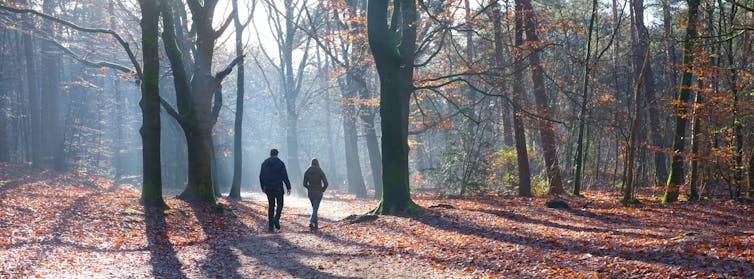
Do you love spending time in nature? Or are you a city slicker, happier in the concrete jungle than the great outdoors? Back in 1986, the US biologist EO Wilson proposed that humans have an innate connection with the natural world, an idea known as biophilia.
Almost every aspect of our lives depends on nature, from food and shelter to fuel and clothing. Yet some of us are much more “into” spending time in nature than others.
To try to understand why, we studied more than 1,100 pairs of twins to find out how much of our connection to nature might depend on our DNA. We found almost half the variation in people’s connection to nature can be put down to genetics.
Nature Is Good For You
There is strong evidence even a wander in the local park can be beneficial for our mental and physical health. Yet with work and family responsibilities and packed social schedules, most of us do not regularly spend time in nature.
We wondered why some people spend more time in nature than others, and what underpins the fact some of us feel more strongly connected to nature.
Perhaps our affinity for nature is inherited. Or perhaps we get it from environmental factors – such as beautiful forests – in the places we live. Or again it might come from our cultural milieu such as the books we read or the TV programs we watch.
Finding answers to these questions might help us work out how to get some nature back into people’s lives.
Studying Twins
We studied more than 1,100 pairs of twins to understand the origin of affinity for nature, and report the results in a study published today in PLoS Biology. It turns out identical twins are much more similar to each other in the strength of their connection to nature than non-identical twins.
Statistical analysis of the results showed 46% of the variation in connection to nature, as measured on a psychological scale, can be explained by genetic factors. Even the amount of time we spend in our own backyards and visiting local parks seems to have a strong genetic basis.

Why the strong genetic influence on our love for nature? Well, one can imagine a strong affinity with nature conferring a significant survival advantage for early humans. This might have led to the formation of complex networks of genes that govern how we relate to nature, and how we behave in it.
Despite the clear role of genetics, our results show other factors actually shape most of our affinity to nature. These might include childhood holiday destinations, the examples set by our parents, friends and other family members, educational experiences, and whether we live in a biodiverse area.
This is good news, because many of these things are under our own control.
Nature And Health
Nature–based health interventions such as green gyms or environmental volunteering can improve physical, mental and social health and well-being. Nature-play initiatives such as the Green Passport for Queensland kids can give children powerful experiences of nature that could benefit their health over the long term.
A deeper question, and one we don’t yet have a clear answer to, is whether spending time in nature fosters our sense of environmental concern, and in turn, support for nature conservation.
The US ecologist James Miller has argued interactions with nature are crucial in sparking support for protecting nature. Yet an Australian study led by environmentalist Jessica Pinder showed conservation concern among Australian undergraduates was more strongly associated with social and cultural experiences in childhood than with the amount of time a person spends in nature. Clearly, there is much more to learn in this area.
Ultimately, we now know despite a genetic basis for our affinity to nature, much of it also depends on other factors that are decidedly under our own control. So make a resolution today to rekindle your connection to the great outdoors!![]()
Richard Fuller, Professor in Biodiversity and Conservation, The University of Queensland; Brenda Lin, Principal research scientist, CSIRO; Chia-chen Chang, Research fellow, University of California, Davis; Danielle Shanahan, Chief Executive, Zealandia Te Māra a Tāne, and Adjunct Professor, Te Herenga Waka — Victoria University of Wellington; Kevin J. Gaston, Professor, University of Exeter; L. Roman Carrasco, Associate professor, National University of Singapore, and Rachel Oh, PhD Student, Centre for Biodiversity and Conservation Science, The University of Queensland
This article is republished from The Conversation under a Creative Commons license. Read the original article.
We’ve decoded the numbat genome – and it could bring the thylacine’s resurrection a step closer
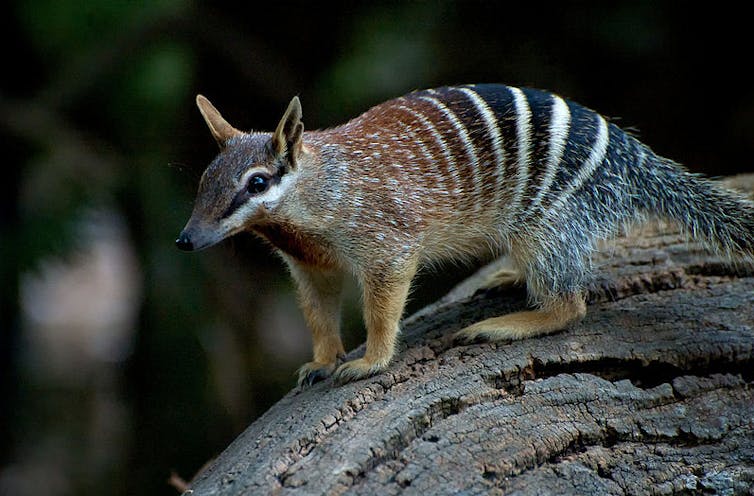
It used to be the stuff of science fiction: bringing a long-dead species back from extinction by painstakingly piecing together its full DNA sequence, or genome.
It’s not quite as straightforward as Jurassic Park would have us believe, but in the age of DNA editing, the idea of cloning an extinct species is no longer purely the realm of fantasy.
Today, our team at the DNA Zoo has hopefully taken a step towards creating a blueprint to clone one of Australia’s most loved, and most missed, extinct species: the thylacine, or Tasmanian tiger.
We’ve done it not by studying the thylacine itself, but by completing a chromosome-length 3D genome map of one of its closest living relative: the numbat.
The striped, termite-eating numbat is Western Australia’s faunal emblem, and now lives only in small pockets of that state, although it once roamed throughout southern Australia. Crucially, numbats and thylacines shared a common ancestor that lived some time between 35 million and 41 million years ago – relatively recent in evolutionary terms.
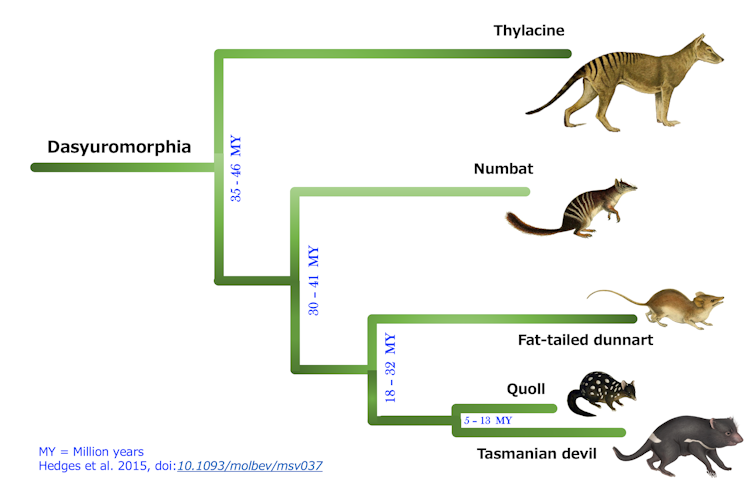
Both these enigmatic creatures have stripes, but that’s not where the similarity ends – as much as 95% of their DNA may be identical.
Decoding the full numbat genome therefore raises the tantalising prospect of being able to piece together the thylacine’s genetic sequence, which in turn would offer the tantalising prospect of reintroducing one of Australia’s most iconic lost species.
No doubt this will be more challenging than the famous bid to resurrect the woolly mammoth using DNA from the Asian elephant. But the release of the numbat genome makes the thylacine’s resurrection a more realistic prospect than ever before.
The numbat is the latest marsupial genome sequence from this family compiled by our team at the DNA Zoo, following on from the Tasmanian devil, quoll and dunnart. We acquired samples of more than 500 mammals from around the world, and aim to make all their genomes available for conservation and open-access research.
We are also working on a detailed genomic analysis of most Australian carnivorous marsupials, and will ultimately produce a full peer-reviewed publication in a journal. But today, by sharing the sequence publicly at this stage of our research, we can offer a valuable resource to other scientists and conservationists studying numbats and other marsupials. Given the conservation threats they face, time is ticking fast.
Genes From Thylacines
The first draft of the Tasmanian tiger genome was pieced together in 2018, using the century-old museum samples. But this version is very fragmentary – several key gaps still need to be filled to piece this puzzle together into a comprehensive genome sequence. Unfortunately, the old museum samples didn’t provide enough high-quality DNA to resolve these issues.
So how do you reconstruct something without some seemingly essential ingredients? This is where the genome of the thylacine’s closest living cousin – the numbat – can help. Our new high-resolution numbat genome map can help us fill in the missing bits of the thylacine genome.
There will still be significant hurdles between having a complete thylacine genome and cloning a thylacine for real. But what takes this scenario from science fiction to potential reality is CRISPR gene-editing technology – a set of enzymes that allow scientists to target very particular snippets of DNA.
CRISPR has been referred to as a kind of “molecular scissors” that allow the precise selection and insertion of DNA from specimens, making “de-extincting” the thylacine or other species a realistic prospect by allowing geneticists to selectively “repair” the missing bits of its genome.
With the help of this and other “synthetic biology” tools, geneticists could conceivably piece together a set of chromosomes that could then be inserted into an egg cell with its existing nucleus removed, allowing the new DNA to act as the egg’s genetic blueprint. This is the technique being pursued by a US research group aiming to clone the mammoth by using the DNA of its closest living relative, the Asian elephant, to fill in the missing bits of mammoth DNA.
Science Fiction Or Science Future?
Around the world, rapid advancements in embryology and genetics are opening up the possibility of resurrecting extinct species — or at least creating something that’s close enough to the original that it will develop and grow properly.
In 1996, British scientists successfully cloned a sheep, called Dolly. Then, in 2017, Chinese researchers used the same technique to create two genetically identical long-tailed macaques.
Through the growing field of synthetic biology and precise genome-editing technologies such as CRISPR, Harvard geneticist George Church has launched Colossal, a biotech company that has initially set on creating an elephant-mammoth hybrid, with the first calves expected in six years.
Helping Numbats First
Of course, the numbat is one of Australia’s most loved native marsupials in its own right.
Like the Tasmanian Tiger, it too was on the verge of extinction during the late 20th century, but extensive conservation efforts as well as government and community intervention are helping its numbers gradually bounce back.
Still, with fewer than 1,000 numbats left in the wild and the species still officially listed as endangered, our genetic blueprint hopefully paves the way for better numbat conservation information for our scientists on the front line. Many of these scientists are fighting the very genetic diseases threatening to exterminate numbats.
There is a still a long road ahead before the thylacine could be cloned. But if it works, the end goal of any de-extinction effort surely is to reintroduce animals to the wild.
If that were to happen, the thylacine already has one advantage over many de-extinction candidates: appropriate habitat. With reserves covering about half of Tasmania today, there would be ample places for thylacines to live, still teaming with the prey animals they used to eat.
There is no question it could be put back into the Tasmanian bush. There is also good reason to do so: the thylacine was Tasmania’s key carnivore. Putting it back atop the food chain could help restabilise ecosystems that are under threat.
If and when that dream becomes reality, thylacines would owe a debt of gratitude to their little cousin, the humble numbat.![]()
Parwinder Kaur, Associate Professor | Director, DNA Zoo Australia, The University of Western Australia
This article is republished from The Conversation under a Creative Commons license. Read the original article.
Placenta with an egg capsule: the strange mechanics of pregnancy in one Australian shark

People tend to think of sharks as large, frightening predators with sharp teeth, so it might come as a surprise to learn that some shark babies grow in the same way as humans – attached to the mother by an umbilical cord and placenta.
Our recent research published in the Journal of Comparative Physiology B sheds light on the placenta of the pint-sized Australian sharpnose shark – wherein a thin layer of egg capsule separates the mother’s and baby’s tissues.
Shark Pregnancy
There are more than 500 different species of shark, some as small as your hand (like the dwarf lantern shark) and others as big as a bus (such as whale sharks).
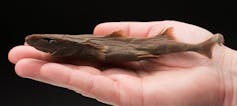
Reproduction in sharks is equally varied: some lay eggs, but most give birth to live young. Sharks typically give birth after 11–12 months of pregnancy, but some, such as the frilled shark, are pregnant for more than three years.
In some sharks, a placenta develops during pregnancy. The placenta helps the baby shark breathe, eat and expel waste as it develops inside the mother. Other species of shark don’t have a placenta, and instead their babies feed on egg yolk, secretions, unfertilised eggs or even their own siblings.
Biologists have long been fascinated by reproductive diversity in sharks, but haven’t yet figured out why some sharks have placentas and others don’t.
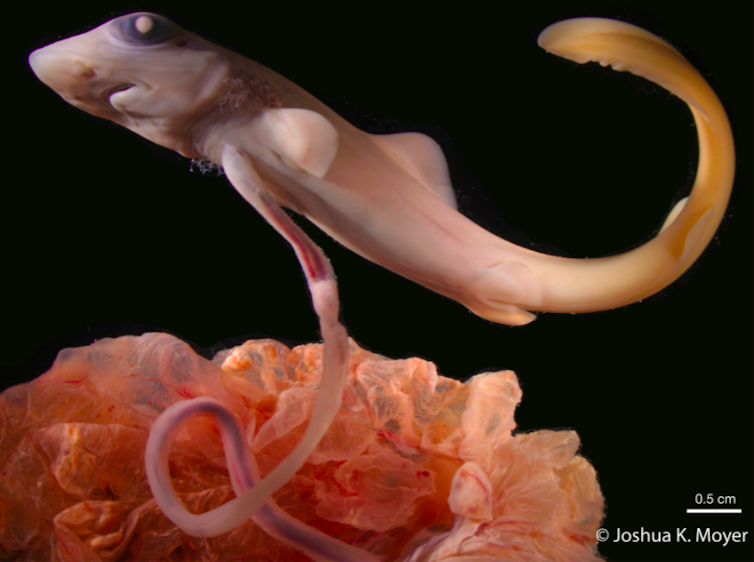
The Australian Model For Shark Pregnancy
In Australia, we have a unique model to understand shark pregnancy: the Australian sharpnose shark (Rhizoprionodon taylori). This small shark is just 70 centimetres long, and lives off the coast of northern Australia.

The females get pregnant every summer with five to ten babies (called pups). Shortly after falling pregnant, embryonic development is paused for seven months. During this time (called diapause), the embryos are still just a bundle of cells.
Diapause ensures the babies are born in summer, almost a year later. This is when they stand the best chance of surviving, as water temperature is at its highest and food is abundant.
Diapause ends when signals, such as hormones trigger the embryos to resume development. They feed on egg yolk at first, and the placenta takes over about a month later. Placentas connect to the babies by umbilical cords, and transport enough nutrients to allow them to grow 300 times larger over just 4.5 months of development.
When the babies are born, their umbilical cords drop off, leaving them with belly buttons. They can almost immediately hunt and fend for themselves, which is astonishing considering humans are born helpless after nine months of pregnancy.
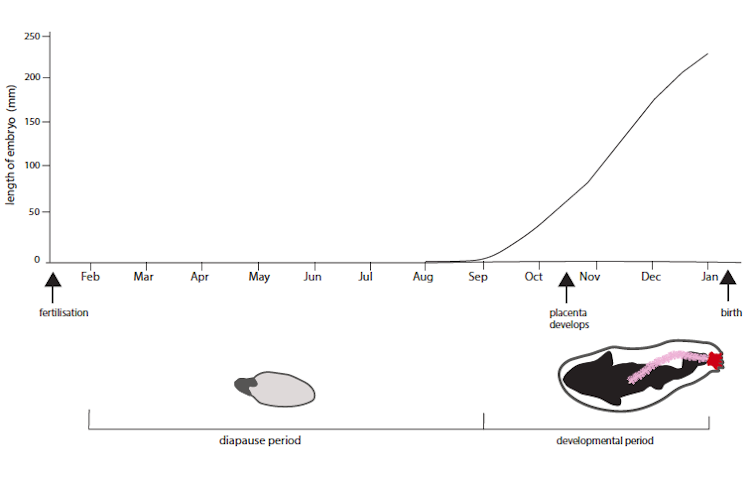
Our recent studies looked at how the placenta supports sharpnose babies so effectively during pregnancy.
The Unique Features Of Shark Placentas
Under the microscope, we discovered the sharpnose placenta is made up of thin layers of cells from the mother and the baby, separated by an extremely thin egg capsule (0.00005 centimetres). Structurally, this is very similar to the placentas of most other sharks.
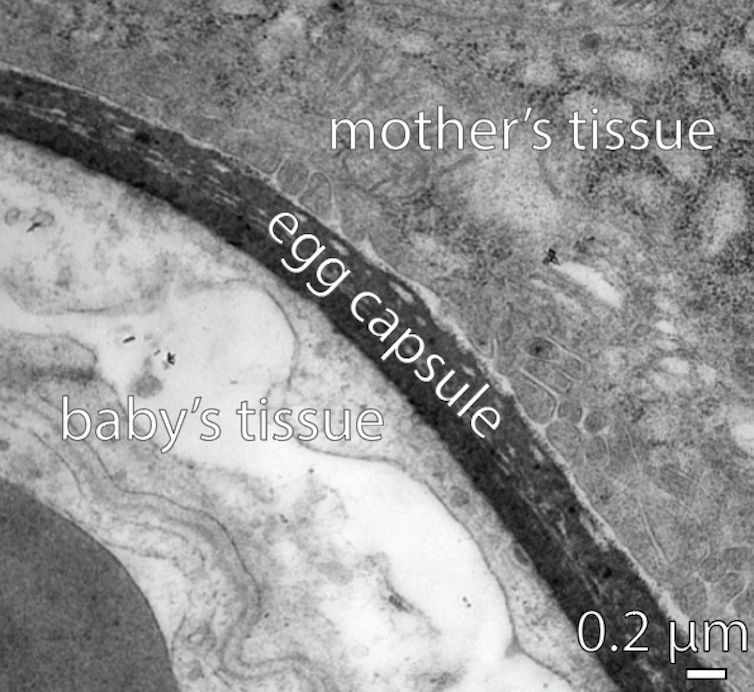
The egg capsule in the sharpnose placenta has no pores. But we showed it can still allow small molecules to pass from the mother to her babies, such as oxygen and small nutrients including sugars, amino acids, fatty acids and water. This explains how sharpnose babies can grow so quickly inside the mother’s uterus.
However, the size of the molecule matters – and larger proteins can’t get through the egg capsule. We think the capsule may act as a physical barrier that protects the babies from bacteria in the uterus during pregnancy.
Physically separating the mother’s and baby’s genetically different tissues could also help stop the mother’s immune system from attacking the baby.
Human placentas look completely different to shark placentas – there is no egg capsule and the baby’s tissues are directly bathed in their mother’s nutrient-rich blood.
Yet both function to nourish babies during pregnancy. This similar function is an amazing example of convergent evolution, given humans and sharks are separated by 450 million years of evolution.
Further research into this little Australian shark will help us understand how placentas that evolved independently in different species can perform the same functions during pregnancy. ![]()
Alice L Buddle, Research assistant, University of Sydney; Camilla Whittington, Senior lecturer, University of Sydney, and Colin Simpfendorfer, Adjunct professor, James Cook University
This article is republished from The Conversation under a Creative Commons license. Read the original article.
4 reasons why you should never say ‘do your research’ to win the argument

It’s fairly common to see many claims or arguments end with a curt “do your research”. In some ways, it’s a bold call to action.
“Come on people! Wake up! You’ll see the truth of the matter if only you see it with your own eyes!”
This type of statement is highly evocative and persuasive – in an emotionally manipulative way. Here are four reasons why we should avoid telling others to do research when discussing a topic.
1. Burden Of Proof
There’s a general rule in argumentation: “What can be asserted without evidence can also be dismissed without evidence.” What this means is that if we make a claim about the world, we bear the burden of proving that our claim is true. Carl Sagan famously argued this as “extraordinary claims require extraordinary evidence”.
This is an essential part of public discourse – if we want the public to agree with us, we must accept the burden of proof for demonstrating our ideas.
Say we want to make a claim like:
“The COVID-19 vaccine is poison.”
This is an extraordinary claim. We have a well-established track record of safe vaccines. To begin to take the “poison” claim seriously, we’ll need some serious facts to back it up.
Perhaps there are studies that demonstrate that a vaccine is poisonous or causes significant adverse reactions. But it’s still our job to provide that evidence – no one is required to take us seriously until we do.
Once that evidence is provided, we can evaluate whether that evidence is reliable and whether it relates to the main claim.
2. Confirmation Bias
Our minds don’t always work by being slow, reasonable and deliberate – that would be exhausting. Instead we use what’s called heuristics (mental shortcuts) to enable us to act and behave quickly.
We use heuristics to make choices while driving in traffic, or deciding which way to dodge in a football game, or when to turn down the heat when cooking. There are simply too many tiny decisions to make every day to not have these shortcuts.
A cognitive bias is similar to a heuristic but with an important distinction – it comes with an error embedded in the decision.
A specific type of cognitive bias is a confirmation bias: the tendency to interpret facts and information in a way that supports what we already believe. For example, if we’re distrustful of government, we’re more likely to believe news stories about corruption and fraud on the part of our elected officials.
The problem with confirmation bias is that it leads us to irrationally privilege certain types of information over others. It’s much harder to change our minds when they’re already primed to believe certain things – about vaccines, for example. In our search for information, we’ll look to sources that support claims we already agree with or deny claims we don’t like. If we are already suspicious or fearful of a vaccine and someone says “do your research on the harms of the vaccine”, we’re more likely to cherry-pick individual cases of adverse vaccine effects.
3. Poor Intellectual Virtue
Someone who tells others to do the research is looking for others to come to the same conclusions they’ve already drawn. That’s not discussion or debate. It’s seeking uncritical agreement and social acceptance.
We all seek validation of our perspectives and beliefs, but we need to do more than this. We should welcome sincere engagement and criticism.
Effective democracies require that we engage with each other using intellectual virtues like honesty, open-mindedness and rigorousness. We should aim to be truth-seekers, looking to evaluate evidence and determine credibility in all things.
4. Unreasonable Expectations
We can’t expect that everyone has the time to thoroughly examine every publication on a given topic. Even if it took only ten minutes to read a scientific article on vaccination safety (which is a huge underestimation for a paper that is thousands of words long), effective research would have us reading at least half a dozen of them to see what experts in the field are saying.
And that’s just reading. It isn’t counting the time to learn various terms and vocabulary in that field, to learn about the disagreements and schools of thought, or to form our own opinion on the quality of that research.
At a minimum, we’d be looking at hours of investigation for someone else’s argument. If the arguer puts forward their evidence, we’d still need to do our research on whether that evidence was accurate – but at least now we’re talking about minutes, not hours.

Becoming Better At Arguing
One of the most fundamental virtues in listening to each other and improving the quality of our discourse is curiosity. One of the real dangers for our lives is becoming uninterested in other perspectives – or, worse still, becoming uninterested in the truth itself.
We’ll never have a full picture of complex social and scientific problems. Our lives are busy and complex themselves and we simply don’t have the time to properly investigate every topic put before us. If someone wants to be taken seriously, the least they can do is present their argument in full.
We can still meaningfully engage with each other, but we have to be honest about our information and where we got it from.
It’s no good telling others to do our homework for us.![]()
Luke Zaphir, Researcher, UQ Critical Thinking Project, The University of Queensland
This article is republished from The Conversation under a Creative Commons license. Read the original article.
The seductive glamour and decadent hedonism of Hollywood influences on Australian architecture

Between the first and second world wars, Australia’s high-end architecture was strongly influenced by exotic scenery from Hollywood’s rapidly accelerating movie industry.
Southern California’s style of seductive glamour and decadent hedonism – recalling the sun-blessed heydays of Roman emperors and Mughal sultans – especially inspired developers and designers of lavish cinemas, mansions, blocks of flats and leisure gardens with swimming pools.
The Best Of Hollywood
Sydney’s Potts Point peninsula was a crucible of this trend, especially after music publishing mogul Frank Albert hired English architect Neville Hampson to create his splendid residence Boomerang, facing Elizabeth Bay.
In 1924, Hampson and Albert visited Los Angeles to find ideas from “the best of Hollywood”. The pinnacle then was La Cuesta Encantada, a vast hilltop estate that media magnate William Randolph Hearst was developing, in Spanish, Italian and French neo-classical styles, with architect-engineer Julia Morgan.
Their own version of Hearst’s castle included the Baroque cathedral-inspired Casa Grande, three large guest houses and “the most sumptuous swimming pool on Earth”.

Hampson and Albert probably also visited Russian actress Alla Nazimova’s Garden of Alla estate in West Hollywood, which was notorious for risqué parties around her swimming pool and lush garden. Her terracotta-roofed mansion exemplified the Spanish-Italian vineyard-villa style that was also being promoted in Australia by architects William Hardy Wilson, Robin Dods, Walter Bagot, Harold Desbrowe-Annear, and Australia’s first dean of architecture, Professor Leslie Wilkinson.
When Wilkinson founded the University of Sydney’s Faculty of Architecture in 1919-20, he strongly criticised the ornamental features and complex roofs typical of the waning Arts and Crafts movement. Instead, he promoted a Mediterranean mode of relaxed, sun-responsive elegance; based on “the work of Spain, of southern Italy, of Provence, with, perhaps, a little of the Orientalism of Northern Africa.”
He also praised Los Angeles updates of west coast Spanish missions, with their adobe walls, arched arcades, timber beam ceilings and rounded terracotta roof tiles, as “a delightful and appropriate style of building”.
This aligned his 1920s Australian clique to the medley of Spanish-Mediterranean styles that were embraced by Hollywood property developers, architects and newly rich stars from the silent films industry.

The Interwar Decades
During the interwar decades, many mansions, villas, bungalows and blocks of flats were built in Spanish-Italian renaissance styles, often combined with flat roofs, low proportions and curved corners from the then-new Streamline Moderne movement. Typical features were centre-opening French doors, curved Juliet balconies and columned porticos, colonial-style (multi-pane) windows, loggias and arcades, piazza-inspired courtyards and ceremonial staircases rising around entry foyers.
Outstanding Sydney, examples included Wilkinson’s own villa, Greenway, in Vaucluse; Burnham Thorpe and many other palatial North Shore residences by Frederic Glynn Gilling (with Howard Joseland), and Craigend in Darling Point by Frank Ironstein l’Anson Bloomfield (with Roy Stuart McCulloch).
Two other Hollywood-Mediterranean standouts were The Lodge in Canberra, by Melbourne architects Percy Oakley and Stanley Parkes, and Pine Hill (Bruce Manor) at Frankston, Victoria, by Sydney architects Prevost, Synnot & Rewald (with Robert Bell Hamilton). Both of these cream-painted, terracotta-roofed mansions shared the same first occupants: Prime Minister Stanley Melbourne Bruce and his family.

As well as residences, Spanish-Mediterranean styles were adopted for various new types of buildings; especially blocks of flats, petrol stations, car showrooms, hotels and shopping centres, and beach pavilions for new surf lifesaving clubs; notably the Bondi Pavilion by Robertson & Marks.
Spanish aesthetics also suited Catholic schools and churches, such as St Columba’s in South Perth, and crematoria for modern funerals. Two superb cremation complexes were designed by Frank Bloomfield at Sydney’s Rookwood and Northern Suburbs Memorial Gardens.
Cinemas, Theatres And Opera Houses
Australia’s most spectacular interpretations of Mediterranean architecture were the “atmospheric” cinemas designed by Henry Eli White and other antipodean acolytes of John Eberson, America’s leading interwar architect of theatres and opera houses.
Atmospheric interiors tended to feature extravagant ornamentation, scenic trompe l’oeil paintwork and dramatic lighting effects that lent audiences the fantasy of spending a starry night watching performances in the courtyard of Granada’s Alhambra Palace. His over-the-top décor influenced Hollywood scenery styles that seemed sophisticated and exotic in the mid-20th century, but today are often described as “camp” and “kitsch”.
White, a New Zealander, set up his practice in Sydney in 1913 and expanded his career on both sides of the Tasman during the 1920s. Historian Ross Thorne revealed that White worked with Eberson on Sydney’s Capitol and State theatres. He also designed the Palais, Athenaeum and new Princess theatres in Melbourne, the Civic in Newcastle, and Wintergardens at Ipswich, Rockhampton and Townsville.

Sydney architects Bohringer, Taylor & Johnson also completed some notable atmospheric cinemas in the late 1920s, including the State (today’s Forum) in Melbourne and the Ambassadors in Perth.
Spanish-Mediterranean architecture was well suited to Australia’s post-Federation culture because it gave a more exotic flavour than the Colonial Georgian revival that accompanied the reigns of kings George V and George VI from 1910 to 1952. And it connected Australia to the exhilarating, glamorous spirit of Hollywood in the roaring twenties.
Now that Australia’s own Hollywood-aligned film culture is prospering, these vintage architectural icons remain alluring.
This is an edited extract from Australian Architecture: A History, by Davina Jackson, published by Allen & Unwin.![]()
Davina Jackson, Honorary Academic, School of Architecture and Planning, University of Kent
This article is republished from The Conversation under a Creative Commons license. Read the original article.
Making change, making history, making noise: Brittany Higgins and Grace Tame at the National Press Club
Michelle Arrow, Macquarie UniversityAs an historian of the Australian women’s movement, the past two years have been extraordinary to witness. Not only are we living through a once-in-a-century pandemic, which has had profoundly gendered effects, we have also experienced a feminist insurgency that has placed the issue of women’s safety, and men’s abuses of power, at the centre of our national conversation.
While many activists, journalists and advocates contributed to this insurgency, it exploded largely thanks to two young women: 2021 Australian of the Year Grace Tame and former parliamentary staffer Brittany Higgins.
Both just 26, both survivors of sexual assault, both abused by men – and institutions – they ought to have been able to trust. Both rejected the expectation they should be shamed into silence about their experiences. In doing so, they have helped to rewrite enduring cultural scripts about sexual abuse and sexual assault.
Their joint address at the National Press Club today was a valedictory speech, a way to mark their extraordinary year in the public eye. But it was also a call to action, a warning against complacency in an election year.
Both made it very clear that, while hearing the voices of survivors of abuse and assault is important, it is not enough. As Higgins noted, the ways we discuss abuse are far too passive,
as if sexual violence falls out of the sky. As if it is perpetrated by no-one.
Of yesterday’s formal parliamentary apology to victims of alleged sexual harassment, assault and bullying, Higgins was grateful, but sceptical:
They are still only words. Actions are what matter.
Tame and Higgins both made passionate pleas for structural change, for measurable action to prevent sexual abuse and assault. Tame called for government to take abuse seriously: to advance consistent national legislative change on sexual offences, and to spend more on preventive education to curb Australia’s alarmingly high rates of abuse and assault. She calculated the government spends 11 cents per student per year on prevention education, because
we currently have a government that is primarily concerned with short-sighted, votes-based funding, not with long-term, needs-based funding.
To those of us used to government by spin, obfuscation and photo ops in high-vis vests, Tame and Higgins’ moral clarity and bluntness are exhilarating. Both vehemently ruled out the possibility of political careers and, indeed, the journalists asking them about their political aspirations seem to misread their social and political role.
They are advocates and activists, who use their public platform to articulate complex issues in clear, direct ways. Tame, in particular, clearly has no intention of playing by anyone else’s rules, as her memorable side-eye to the prime minister at The Lodge demonstrated.
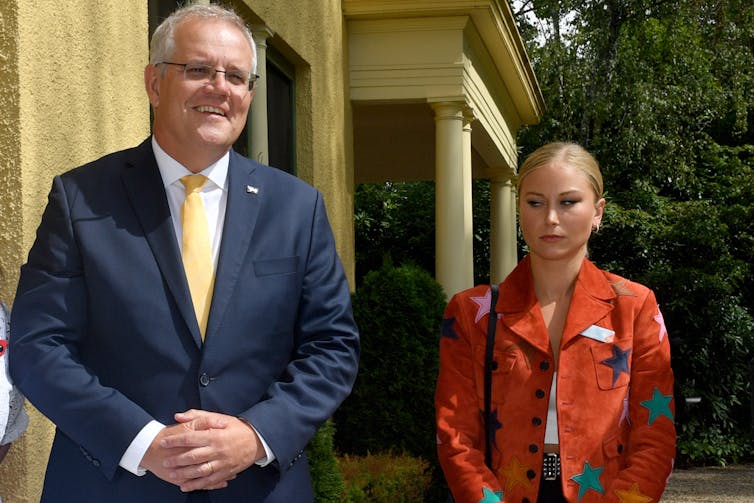
Their speeches also confirmed that their actions had rattled the Morrison government, whose response to them has been ham-fisted at every turn. Tame revealed that in August 2021 a representative of a government-funded organisation (which she declined to name) had asked for her “word” that she would not say anything about the prime minister on the evening before the 2022 Australian of the Year awards. “You are an influential person. He will have a fear,” she was told. She speculated he had “a fear he might lose his position, or, more to the point, his power”. The prime minister’s office later said it had no knowledge of such a call to Tame and the person who made it should apologise.
Tame also reminded us the Department of Prime Minister and Cabinet conducted a review of the selection process for Australian of the Year not long after she won the award. This was an attempt at intimidation, as Tame notes, but it also spoke to the government’s dislike of her fearless critique.
Higgins was consistently treated by many in the Morrison government as a political problem to be managed. In the wake of her allegations, the prime minister commissioned not one, not two, but four reviews, all the while dragging his heels on a formal response to Kate Jenkins’s landmark Respect@Work report.
Higgins reminded us that implementing Respect@Work, especially the proposed “positive duty” on employers to provide a safe workplace, would have
impacted every single working woman in the country. And we just kind of let that moment slide by without thinking.

Tame and Higgins dissected the government’s performance on gender over the past year. Tame called out Christian Porter’s reliance on a blind trust to fund his unsuccessful defamation case against the ABC. Higgins eviscerated the government’s National Plan to End Violence Against Women and Children for its “vague and lofty” aims, its lack of targets and clear plans. She noted the shocking statistics on domestic violence that
you’ve heard […] rattled off at white-ribbon breakfasts […] They should spur us to do whatever it takes. But instead they’ve become a sort of throat-clearing exercise that we all just kind of tolerate.
Policy action on abuse and assault has been a litmus test for the Morrison government’s views on women. According to Higgins and Tame, it is a test the government has failed at every turn.
In the 1970s, feminist activists told personal stories in public because of their belief that “the personal is political”. Yet victims of sexual assault or abuse typically remained anonymous, because of the shame that was attached to these crimes.
More recently, advocates like Rosie Batty, and now young women including Grace Tame and Brittany Higgins, have personalised these difficult issues, making them harder for politicians to ignore. The #MeToo and #LetHerSpeak movements have centred on survivors and focused on hearing their stories. As Tame said in her NPC address:
How beautiful is freedom of speech? I haven’t always had it.
One of the problems with a movement based on storytelling in public spaces is the brutal toll it exacts on survivors. Tame noted she had spent the past year being “revictimised, commodified, objectified, sensationalised, legitimised [and] gaslit”. As Tarana Burke has pointed out, survivors “shouldn’t have to perform our pain over and over again for the sake of your awareness”.
There are other problems with placing too much emphasis on individuals like Tame or Higgins: two young white women can hardly represent all assault survivors, as Shakira Hussein and others have pointed out. And we must be careful not to confuse justice for individuals with broader structural changes to protect all people from abuse and harassment.
But by speaking truth to power, Higgins and Tame have reinvigorated feminism for a new generation of young women. Back in the 1990s, older feminists worried young women were not taking up the feminist mantle. No-one is saying that now. Teenage girls know Grace Tame’s name, and they admire her courage and her strength.
As Jess Hill and others have noted, the public face of Australian feminism in the 2010s was dominated by “corporate feminism”: seemingly preoccupied with getting more women on boards rather than raising the wages of low-paid female workers in aged care or childcare, for example.
Sexual harassment is still, shockingly, endemic across Australia, and too many people have experienced sexual abuse and assault. By highlighting this problem – which at its core is about the gendered abuse of power – Tame and Higgins have mobilised a broad constituency of Australian women. They inspired thousands to march for justice and others to run for political office. Maybe they will play a decisive role in this year’s federal election.
As Tame reminded us:
[our leaders] may either be constructive or destructive. But every single one of them is arguably replaceable.
If you or anyone you know needs help, please call 1800RESPECT (1800 737 732).![]()
Michelle Arrow, Professor of History, Macquarie University
This article is republished from The Conversation under a Creative Commons license. Read the original article.
Liberal revolt removes all discrimination against gay and transgender children
Michelle Grattan, University of CanberraIn a humiliating rebuff to Scott Morrison, a revolt by Liberal backbenchers has struck down the provisions of the sex discrimination act that allow discrimination against gay and transgender children.
In the early hours of Thursday, five Liberals crossed the floor – Katie Allen, Dave Sharma, Trent Zimmerman, Bridget Archer and Fiona Martin – in defiance of the Prime Minister. The vote was 65-59. The amended bill then passed the House of Representatives.
The rebels had been concerned the government’s much narrower proposed change excluded transgender children.
The amendment was moved by crossbencher Rebekha Sharkie and was identical in wording to one of Labor’s proposed amendments. Sharkie told The Conversation she thought it might have a greater chance of success coming from the crossbench.
Earlier Morrison had told the house there would be “a time and place” to address the situation of transgender children.
He said the Law Reform Commission would consider the protection of these children from discrimination while allowing schools to maintain their ethos. The commission would report in six months. He also named Allen as chair of a House of Representatives select committee on the question.
The government’s proposed change to the sex discrimination legislation was a parallel bill to its religious discrimination legislation.
Labor and two Liberal rebels narrowly failed to amend the religious discrimination bill when Speaker Andrew Wallace used his casting vote to break a tied vote.
Archer and Zimmerman crossed the floor to support a Labor amendment aimed at ensuring existing anti-discrimination protections were not diminished by the protection to be given to “statements of belief”. The vote was 62-62.
The religious discrimination bill passed the house at 4am Thursday, shortly before the revolt over the associated bill. The only amendments to it were those the government made.
Archer, who supported all Labor’s amendments to the religious discrimination bill, also voted against its second reading and its final passage.
Now that they have been lost in the lower house, the opposition will pursue its amendments to the religious discrimination bill in the Senate.
Labor on Wednesday gave support to the controversial bill but said it was flawed and should be amended.
Caucus approved a package of proposed amendments that would
prohibit religious vilification
make it clear the legislation’s “statement of belief” did not remove or diminish existing protections against discrimination. (The legislation provides that “statements of belief” are legally protected if based on a genuinely held religious view.)
ensure in-home aged care providers could not discriminate on the basis of religion in providing services
prohibit discrimination against children on the grounds of sexuality or gender identity.
During the House of Representatives debate opposition leader Anthony Albanese tabled a letter Morrison had sent to him late last year in which the PM reaffirmed “there is no place in our education system for any form of discrimination against a student on the basis of their sexuality or gender identity” and said the government would amend the sex discrimination act to remove the provisions allowing this.
Labor said that it would “insist” on any of its amendments that were passed in either house. That could mean, if the government refused to accept them, the legislation bouncing between the houses until one or other side gave way.
The religious discrimination legislation is up against the clock, with the Senate rising on Thursday, and not sitting again until budget week, the last sitting before the election.
Albanese told parliament the legislation was “flawed” but it could be fixed.
He said it should be possible “to enhance protections against discrimination without enhancing discrimination against others”.
“We need shields from discrimination, not swords for discrimination." He said the legislation should be a unifying moment.
But if not amended the bill "will only succeed in driving us apart,” Albanese said.
Morrison has been pulling out all stops to get the religious discrimination legislation through.
But moderate Liberals have had a range of concerns, and much effort had gone into trying to settle backbench doubts and minimise defections.
Zimmerman told the house that he would “part with my party” on the statement of belief provision and the changes to the sexual discrimination act.
Zimmerman said the statement of beliefs “puts religious faith on a pedestal above other rights”. He objected to the changes to the sex discrimination act failing to include protection for teachers and transgender children.
NSW Treasurer Matt Kean tweeted “Trent Zimmerman has been one of my greatest political heroes during my 20 years in the Liberal party. This speech will help everyone understand exactly why.”
Earlier, NSW premier Dominic Perrottet said of the religious discrimination legislation: “I’ve made it very clear that I don’t believe legislation in this space is necessary”. He said it could end up creating more problems than it solved.
Within the Labor frontbench, and in the wider caucus, there was division about over whether the opposition should pursue amendments or oppose the legislation outright.
Former Labor leader, Bill Shorten, who was reported to have argued in shadow cabinet that Labor should oppose the legislation, told the house, “We will rue the day if this legislation passes the Senate” .
The religious discrimination legislation had its origins as a gesture to the losing side after the legislating of marriage equality.
Morrison has hoped to wedge Labor on the issue; Albanese is anxious to avoid the wedge.![]()
Michelle Grattan, Professorial Fellow, University of Canberra
This article is republished from The Conversation under a Creative Commons license. Read the original article.
Researchers Confirm Newly Developed Inhaled Vaccine Delivers Broad Protection Against SARS-CoV-2 Variants Of Concern

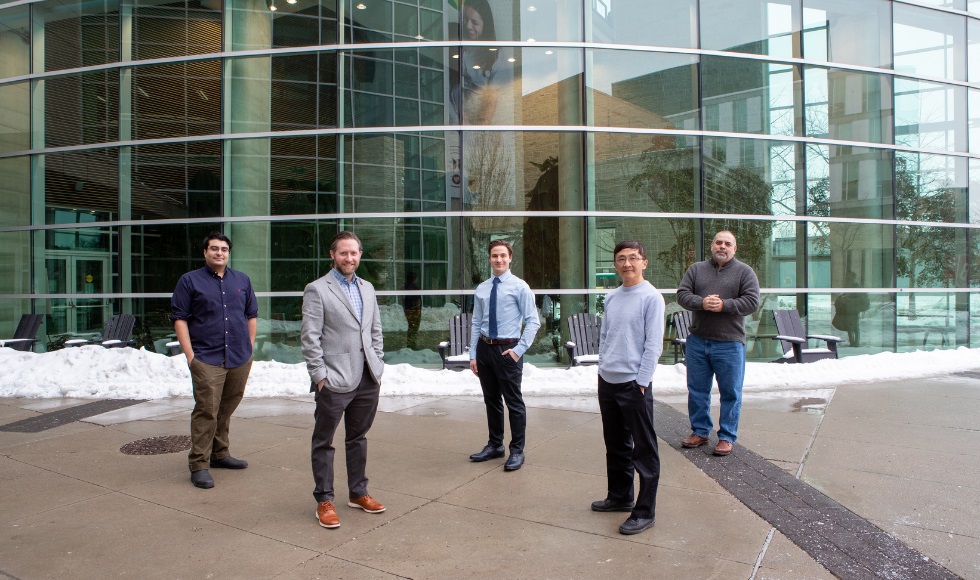
Sewer Slime Can Hang On To SARS-CoV-2 RNA From Wastewater
Gut Bacteria Linked To Immune Suppression In Pancreatic Cancer
Root Symbiosis Is Regulated Through Nutrient Status Of Plants

Time for a reckoning: Cricket Australia, fossil fuel sponsorship and climate change

As we head towards the end of the summer sporting calendar, Cricket Australia is facing pressing questions well beyond replacing Justin Langer as coach of the men’s national teams.
Chief among them is the question of climate change. While other sporting codes and teams around the world are starting to use their clout to push for more and faster action, Cricket Australia’s powerbrokers seem to be largely paying lip service to climate action. Meanwhile, many players are taking action.
You might think cricket and climate change have nothing in common. Sadly, that’s not the case. On a practical level, steadily rising temperatures and heightened natural disasters make it harder to play the sport safely over summer. And on a cultural level, fossil fuel power companies have long used sponsorships to “sportwash” their reputations.
It’s time for Cricket Australia to take a stronger stance on climate and turn away from fossil fuel sponsorships.
Is Cricket Really At Risk?
There is clear and growing evidence rising temperatures, bush fire smoke, cyclones, floods and drought brought by climate change are hurting cricket and the health of its players around the world.
That’s to say nothing of sea level rise and stronger hurricanes, which threaten to take chunks out of cricket-mad island nations in the Caribbean. In June last year, Grenada Prime Minister Keith Mitchell called on Cricket Australia and the International Cricket Council to sign on to UN efforts to harness sport for climate action. In response, Cricket Australia said they would look into it. We’ve heard nothing further.
No doubt some readers will baulk at the idea of putting the politics of climate change and cricket together. But if the last century of sporting history has taught us anything, it’s that high level sport and politics go hand-in-hand, from Cold War Olympics, to race relations, to nationalism.
Climate change is the single biggest issue of our time, dubbed “code red for humanity”. It’s an exceptionally well established issue seen across atmospheric, chemical and physical patterns. To tackle it requires a massive collective undertaking. That means politics. But to make big changes requires public buy-in. Sport, which absorbs so much of our attention, has a vital role to play.
Players Are Taking The Lead On Climate Action
Many of Australia’s leading players – including men’s Test captain Pat Cummins – are not waiting. They are calling for urgent action to protect the sport and the generations of younger players to follow.
For Cummins, the realisation was personal. In January 2020, his local cricket club in Penrith sweltered as Western Sydney became the hottest place on earth. Smoke haze from Black Summer megafires forced match cancellations. Two years earlier, Cummins watched as English captain Joe Root was taken to hospital after battling 47℃ heat.
Last week, Cummins launched Cricket for Climate, which will install solar panels on club facilities around the country. He’s not alone in his activism. This is just the latest surge of support for urgent climate action by our athletes. Cricket for Climate follows on from AFL Players for Climate Action, which now has 260 members. On a broader scale, there’s The Cool Down, a national climate campaign led by Emma and David Pocock which has more than 300 top athletes as backers, including cricket’s Alex Blackwell, Rachel Haynes and Sean Abbott.
Our Athletes Want Faster, Stronger Action. So What’s The Hold Up?
Cricket Australia supports climate action through the fine work of the Sports Environmental Alliance as an organisational member. But it could do much more.
While Cricket Australia has signed on to Cummins’ new initiative, it has not committed to either of two UN initiatives, Sports for Climate Action Framework or the Race to Zero Initiative.
You’d be hard pressed to find detail on Cricket Australia’s environmental initiatives. There’s no information about this in their current five year plan or their annual report.
There’s no reporting on the “holistic” sustainability strategy the organisation stated it was developing in 2020 in the face of concerns about extreme heat.
The Problem Of Sportswashing And Sponsorships
Unfortunately, professional sport is awash with lucrative sponsorships from fossil fuel companies. The main sponsor of our men’s cricket team is Alinta Energy, which owns one of Victoria’s largest coal-fired power plants, Loy Yang B.
While Alinta is moving into wind and solar, its parent company, Pioneer Sail Holdings, is still the sixth highest carbon emitting corporation in Australia as of 2019-2020.
These kinds of sponsorships are coming under increasing scrutiny nationally and internationally, with comparisons drawn between our current fossil fuel corporation sponsorships and tobacco company sponsorships in the 1980s.
Fossil fuel companies seek out the “soft power” of sport as a way to improve their public image and create positive brand associations.

So what would it take to deny fossil fuel companies this kind of social license? Cricket managers don’t have to look far at all. There’s an excellent example at Rod Laver Arena, just over the train tracks from Cricket Australia’s head office.
In January, Tennis Australia sent shockwaves through sport by cancelling its multi-year sponsorship with their “official natural gas partner” Santos ahead of this year’s Australian Open. The cancellation came after a long campaign targeting “sportswashing”.
This sudden shift is positive. It means the comparison with tobacco companies now has real teeth. Remember that in the 1980s, tobacco advertising was everywhere. To reduce the damage done by smoking, Australia progressively denied tobacco companies the social license offered by sponsorships and advertising, as part of a broader push. We need a similar effort to encourage a wholesale shift away from fossil fuels.
The question now for Cricket Australia is simple. How long will it hesitate at the climate crossroads, caught between the health of its players and planet and the fossil fuel interests of its sponsors? The players aren’t waiting. Pat Cummins and many other players are leading the way to a safer future for cricket and those who love it. It’s time for their national governing body to follow them.![]()
Brett Hutchins, Professor of Media and Communications, Monash University
This article is republished from The Conversation under a Creative Commons license. Read the original article.
Disclaimer: These articles are not intended to provide medical advice, diagnosis or treatment. Views expressed here do not necessarily reflect those of Pittwater Online News or its staff.